Australian
and international
exploratory
performance and
media arts
CD, Avant Whatever, 001
www.avantwhatever.com 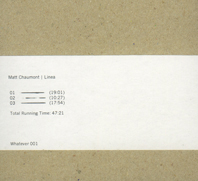
Australian artist Matt Chaumont has spent the better part of the last decade immersed in the world of low frequency sounds, producing a range of works that have probed that liminal perceptual zone where hearing and touch intersect. This has regularly involved the construction and installation of custom-built speaker systems capable of delivering sounds well below the threshold of human hearing and at a volume sufficient for Chaumont’s needs. So with the release of Linea we find out how his aesthetic and practice translates to the home listening CD/album format.
Linea comprises three pieces that are constructed using a limited set of resources—low frequency sine tones. However, this is not to say that these works are in any way austere or simply reductionist. Instead, Linea explores that territory common to the early Minimalist composers such as La Monte Young, Tony Conrad and Charlemagne Palestine, the early work of Ryoji Ikeda and the sine-tone pieces by Alvin Lucier, where reductive strategies generate complex outcomes. Each of Chaumont’s works on this CD produces an intricate sound derived from the interactions between his spare source materials. These works are in no way fast moving—all three pieces are marked by a certain stasis of form, allowing listeners plenty of opportunity to bask in the low, low sounds.
Track one begins by gently shuddering up from below the threshold of audibility before settling into a deep throb, the result of acoustical beats formed by the relationship between two or more tones close together in frequency, the effect of which is somehow both restful and disturbing. As the tones gradually fall in frequency towards the end of the piece, the ear is seemingly dragged into lower and lower pitch zones until the roles of hearing and feeling the sound are well and truly conflated. The second track is both richer and subtler, with incremental harmonic shifts between chordal structures, punctuated with occasional 'silences' produced by sub-audible tones. The last piece returns to a realm of deep pulsations, which gradually mutate and expand over its duration.
It is almost a cliché to say that works such as these that utilise low frequency sound are in some way inherently invested with notions of the physical, especially as very low frequency sounds (typically those below 20 Hertz) are largely perceived through, and interpreted as, touch. However, sounds of all frequencies are equally physical phenomena, and impinge upon our bodies in myriad ways regardless of our modes of perception. What is more interesting about Chaumont’s work is the number of ways that it engages its audience across the perceptual scheme. A sense of physicality is induced not just by the sensation of sound vibrating the ear drum, body or furniture but in the way it arranges itself in space, marking the physical relationship between the listener and the waves of sound in the room. Likewise, the movement of the loudspeaker cones is discernable to the eye (if not the ear), adding a significant visual component to these pieces, especially during periods of what otherwise is experienced as silence. More than the sensational, but rather simplistic, subsonic thump in the thorax one feels from the kick drum in a night club or rock concert, Chaumont’s work demonstrates that even without the benefit of concert sized sound systems or home theatre sub woofers, low frequency sound is more than the sonic equivalent of the fun park ride—some overpowered gimmick for quick excitement. Instead, it becomes not just a malleable tool for mingling the senses, but also a conceptual space for reappraising the everyday division of the senses into discrete realms: sight, sound, space and touch—all from the slow and steady vibration of speaker cones.
Peter Blamey
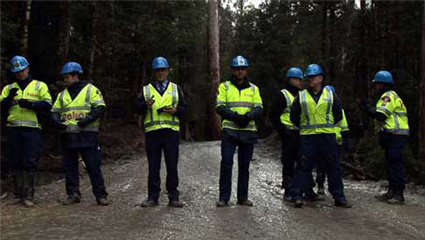
James Newitt, Passive Aggressive (2009)
video still courtesy of the artist and Criterion Gallery
James Newitt, Passive Aggressive (2009)
tasmanian spring
Having recently won the 2010 City of Hobart Art Prize (digital category) for his video work Dreams, Tasmanian artist James Newitt has now been included in the 2010 Primavera Exhibition at the Museum of Contemporary Art. This time, however, it’s his work Passive Aggressive (2009) that has attracted attention. Primavera 2010, which focuses on Australian artists under 35, also includes Akira Akira, Julie Fragar, Emma White, Jackson Slattery and Agatha Gothe-Snape. If you’re in Sydney, it’s always worth a look: last year spat+loogie smashed pie in people’s faces (2009); the year before that Soda_Jerk screened their 3-channel video installation Astro Black: A History of Hip-Hop (Episodes 0-2) (2009). It’s on from August 19 to November 21. http://www.mca.com.au/
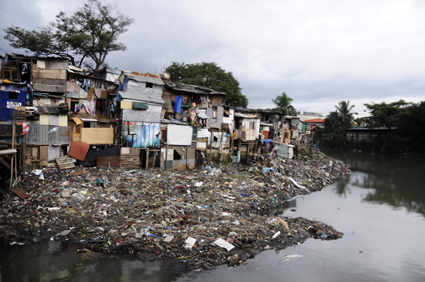
MM Yu, Waste Living 2009, duratran and lightbox, dimensions variable
photo courtesy of the artist
MM Yu, Waste Living 2009, duratran and lightbox, dimensions variable
water in the west
Still in Sydney, though a little further west, the Campbelltown Arts Centre is facilitating The River Project, a major new project comprising an exhibition, publication, performance, and education and public programs. Featuring artists from Australia, China, India, Korea, the Philippines, Vietnam and Papua New Guinea, the River Project explores how “river systems reflect our interconnectedness, our fragility and our history” (press release). Events will be held at the centre itself as well as at sites along the Upper Georges River. The River Project, Campbelltown Arts Centre; August 28-October 24; http://www.campbelltown.nsw.gov.au
blues & birthdays
Also in Sydney, the New Music Network has three concerts coming up. First, on August 24, is a concert by Continuum Sax and Match Percussion, with guests Natsuko Yoshimoto and Roland Peelman, where they will premiere Brian Howard’s Last Blues. Borrowing its title from Cesare Pavese, Howard’s compositions “invokes memory and loss through a compelling and yet fragile dialogue between the violin and ensemble” (press release). The second concert features An Infinity Room (AIR), a new ensemble comprising various synthesisers, keyboards and electronic organs. AIR, playing on September 3, “uses graphic scores, simple performance techniques and semi-improvised structures to create a haunting aura of drones and rich harmonic fields” (press release). Last but not least, Speak Percussion celebrate their 10th birthday by performing some of the oeuvre on September 20. The works are all focused around the keyboard percussion family and were premiered by the group. Continuum Sax and Match Percussion, Eugene Goossens Hall, ABC Centre Ultimo, August 24; AIR, Recital Hall East, Sydney Conservatorium, September 3; Speak Percussion, Recital Hall East, Sydney Conservatorium, September 25; http://www.newmusicnetwork.com.au
analogue love in a digital age
In the era of the iPod, the mix tape has a certain old school charm. Mix Tape is also the title of choreographer Stephanie Lake’s contribution to The Next Move, a series of performances created by the next generation of dance makers, commissioned and presented by Chunky Move. Mix Tape is, according to the press release, “about love. Driven by an eclectic and personal set of songs as well as recorded interviews, this new dance work cleverly illuminates experiences of regret, desire, ecstasy and disillusionment.” Choreographer Stephanie Lake graduated from VCA in 2002 and has spent the past ten years dancing for Chunky Move, Lucy Guerin Inc and BalletLab. She has choreographed several short works as well as two larger participatory dance works: one in 2009 for 100 people that was performed in Federation Square and another in 2010 for a City of Melbourne mob dance for 400 dancers performed in Bourke Street Mall. Chunky Move, Mix Tape, Chunky Move Studios, September 2-11; http://www.chunkymove.com.au/
a clothes line resurrected
Still in Melbourne, check out Not Yet It’s Difficult’s HOIST, which was commissioned by Federation Square’s Occupy program and created by David Pledger. HOIST consists of a general public participatory program by day and a screening program by night. In partnership with Melbourne Writers Festival, NYID is working with professional writers, commissioned artists and schools to populate the over-sized Hills Hoist with paraphernalia themed around this icon of the Australian suburbs. The company is also launching a book, Making Contemporary Theatre, in which the work of NYID is critically contextualised by company dramaturg Peter Eckersall. NYID, HOIST; Federation Square, August 27-September 9; http://www.notyet.com.au/ and http://www.hoistmelbourne.com.au/
re-enacting time
The Australia Experimental Art Foundation, in collaboration with Mildura Palimpsest, is hosting a series of installations, performances and talks for the (to) give time to time project. The project examines ephemeral and time-based practices and the impact of Mildura Sculpturescape (1969-78) on Australian contemporary art practice. It will, according to the website, “do this by making historical links” and “re-enacting key works.” Collaborators include Tim Burns, Barbara Campbell, Bonita Ely, Domenico de Clario, and Eugenio Carcheso. There is also a symposium, launched by Robyn Archer, and featuring Maudie Palmer, Judith Blackall, Rex Butler, Edward Colless, Brenda Croft, Anne Sanders, Juliana Engberg, Neil Fettling, Mark Minchinton, Marco Marcon, Glenny Barkley, and Stelarc. (to) give time to time, Curated by Matthew Perkins and Elena Galimberti, Adeladie August 20-September 18, Mildura September 17-19; http://aeaf.org.au and http://www.artsmildura.com.au/palimpsest/mildurasite.asp
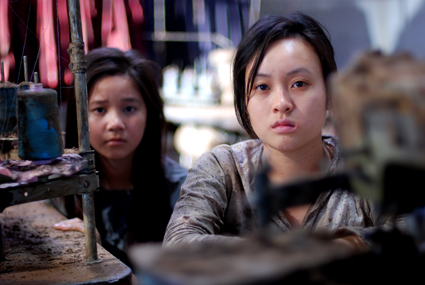
Sheena Pham and Kathy Nguyen, Mother Fish
photo courtesy of Titan View
Sheena Pham and Kathy Nguyen, Mother Fish
a refugee trilogy
Khoa Do is a regular in RealTime’s pages, appearing as both a theatre and film director (The Finished People). His latest effort Mother Fish, about two sisters who make the journey from Vietnam to Australia by boat, has been both a play and a film: the play debuted in 2008 (RT86) and the film premiered (as Missing Water) in 2009 at the Sydney Film Festival. Mother Fish the first film in a planned Refugee Trilogy (the second, Falling for Sahara, is in post-production while the third is still in the planning stages). You can see the film in a few places over the next few weeks. As part of an Amnesty International tour it will be screening in Geelong on August 29, as well as Deakin and Mercury Cinema (details coming soon). It will then tour in September as part of the Mobile AFI Awards. Screenings will be held at Nova (Vic) on September 1, Cinema Paris (NSW) on September 5, the Orpheum (NSW) on September 18, ACMI (Vic) September 19. Finally, it will also be screening at the Oz Film Festival (SA) on September 18. http://www.motherfish.com.au/
sense and censorship
It would appear that, for the moment at least, common sense has prevailed over state protectionism. Thanks to a campaign spearheaded by Get Up! and supported by activists around the country, the Labor party has deferred its internet filter until 2012 and the Coaltion has dumped the policy altogether. It remains to be seen whether “filter 2.0” will bear any resemblance to the first filter (examined by Melinda Rackham here), but with the Greens, Xenophon, and the Coalition now walking away from the policy, it looks unlikely.
RealTime issue #98 Aug-Sept 2010 pg. web
© RealTime ; for permission to reproduce apply to realtime@realtimearts.net
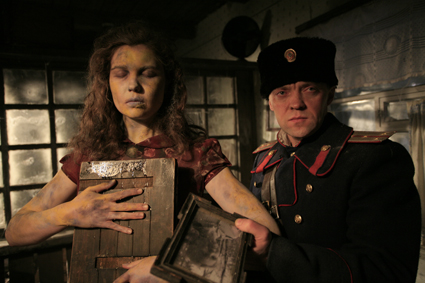
Alexander Proshkin, The Miracle
DEFINING A FILM IN REFERENCE TO ITS NATIONALITY (A FRENCH FILM, AN AUSTRALIAN FILM, A RUSSIAN FILM) IS AN INCREASINGLY TENUOUS BUSINESS THESE DAYS. IN AN AGE OF GLOBALISATION, IT WOULD SEEM THE BOUNDARIES OF A NATION STATE ARE NO LONGER IMPERVIOUS ENOUGH TO ALLOW FOR THE INCUBATION AND GROWTH OF A DISTINCTIVELY NATIONAL CINEMA. CONTEMPORARY RUSSIAN CINEMA REFLECTS THESE CHANGING ECONOMIC AND CULTURAL CONDITIONS MORE ACUTELY THAN MOST OTHER NATIONAL CINEMAS.
For so long culturally isolated and protected by the Iron Curtain, the Russian film industry has, since the fall of the Soviet Union, been forced to undergo a quick and radical transformation. Most significantly, Russian cinema has had to contend directly with Hollywood, the international monster that other national film industries have been struggling with or against for over 90 years. The goal has been simple: to survive in a monopolised marketplace without losing a distinctively national voice. After a shaky start in the 1990s, a definably 'new' Russian cinema emerged in the new century, a cinema that, for better or worse, has asserted itself as a producer of popular, economically viable films that participate in the populist aesthetics of Hollywood while also drawing on Russia’s prized and often traumatic cultural heritage.
The career of Russian director Alexander Proshkin (b1940) in many ways reads like a biography of this transformation. Beginning his career in Soviet television in the 1960s and 1970s, Proshkin asserted his reputation as a director of quality television drama before achieving box office and critical success for his 1988 feature Cold Summer of 1953. That film—a dark, violent and dramatic thriller set in the early days following Stalin’s death—was in many ways a pioneering work that offered a model for what Russian cinema could become in the post-Soviet era. Integrating historical and politically contentious subject matter within a generic scenario lifted from a Hollywood western, Cold Summer of 1953 demonstrated the possibility of a culturally respectable, serious, yet also populist and exciting cinema.
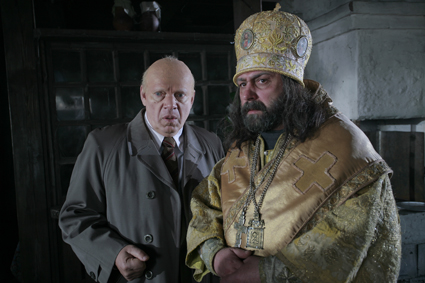
Alexander Proshkin, The Miracle
Proshkin’s latest feature Miracle, which plays at this year’s Russian Resurrection Film Festival, is also an entertaining film of serious ambition. Like Cold Summer of 1953, Miracle is set in the early Soviet 'thaw' of the mid-1950s, a period when Nikita Khrushchev initiated a relaxation of the paranoid grip of Stalinism. Proshkin was in his mid-teens at the time, and must have experienced the cultural atmosphere as a powerful liberation. “The time is significant,” he explains, “because 1956 is the year which marked a turning point in our history. Khrushchev’s address at the 20th Congress [of the Communist Party] marked the arrival of the new post-Stalinism period. With one foot, we were still in the past, while with the other we were in an uncertain future.”
Presented as a film based on historical events, Miracle’s narrative offers a fictionalisation of the characteristically Russian cultural myth, or true event, known as the “Standing of Zoia.” Said to have taken place in Kuibyshev (now Samara) in January of 1956, the story goes that while dancing with an icon of St. Nicholas, 21-year-old Zoia Karnaukhova froze solid in her living room for 128 days, only thawing at the arrival of Easter. In a culture very accommodating to superstition, news of the “miracle” was frantically suppressed by the Soviet government, and circulated only by word of mouth. Proshkin explains:
“In Russia, such information is often referred to as 'bush radio,' where one person tells one person and he tells another etc. Our scriptwriter, Yuri Arabov, was told about this incident by his grandmother, when he was nine years old. To the wider community, this information was kept confidential till about the end of the 1980s.”
With names altered and dramatic twists thrown in (Kuibyshev becomes Grechansk, Zoia becomes Tatiana and Khrushchev himself gets involved through a deus ex machina) Miracle manages to engage with the complex problems of Russia’s Soviet past without losing the narrative momentum of contemporary popular cinema, a balancing act that, in Proshkin’s view, Russian filmmakers can no longer afford to neglect. Just like everywhere else, he explains, Russian filmmakers are now answerable to the dictates of the mass audience: “The filmmaker’s role—or existence—has changed in our nation… Before there was an ideological influence, now it’s a commercial one.”
Despite being unambiguously popular in its presentation, there are considerable dimensions of depth in Miracle. As an allegory, the film would seem to present a metaphor of a society, frozen by Stalin’s terror, coming back to life. For Proshkin, however, the film’s narrative has less specific connotations:
“It is an attempt to explain the mentality of Russia, which in essence has not changed over time. Waiting for so-called 'miracles' has been embedded into the national character and we often put things down to simply being miracles.”
Proshkin’s interest in the “mentality” of Russia, and especially in the profound incompatibility between Russian social life and systematic centralisation, echoes throughout much of the director’s work. Open to the possibility of the miracle, but not certain of it, his is what might be called an agnostic attitude, significantly distanced from the more fervent religious cinema of contemporary Russian directors like Andrei Zviagintsev and Pavel Lunguin (whose epic Tsar also features at this year’s festival). Asked whether he considered his film to belong to the growing ‘religious’ genre of Russian cinema, Proshkin replies:
“For me it was always a mystery: how could a nation, which existed for 1000 years with the Christian-orthodox faith, suddenly condemn its pastors, destroy its churches and reject its religion? Religious belief, which was nurtured for 1000 years, cannot just disappear in one particular moment. It simply moved into the subconscious… Spiritual movies represent the character of our culture and its peculiarity.”
This concern with the Russian subconscious leads me to pursue another subject. If anything can be said to have persistently pricked at the conscience of Russian filmmakers for the past 50 years, it would be that most traumatic chapter of the country’s Stalinist nightmare, the Second World War. At this year’s festival, a retrospective of World War II dramas made in the post-war era—The Cranes are Flying (Kalatazov, 1957), Ivan’s Childhood (Tarkovsky, 1962), Trial on the Road (German, 1971) and The Ascent (Shepitko, 1977)—offers a captivating and sobering glimpse of the war’s centrality in the Russian memory. These are some of the finest films of their time. And yet still today, narratives set during the war continue to be made, as untold stories come to light. One such film is Vera Glagoleva’s One War, perhaps the finest new feature at this year’s festival. Other films explore an adjacent period: Stanislav Mitin’s lyrical gem Backdoor is set in 1949 and Nikolay Dostal’s award winning Peter on His Way to Heaven takes place in 1953.
For Proshkin, there’s a specific rationale in Russia cinema’s preoccupation with the trauma of Soviet history. Raking over the past is, it would seem, a way of processing the unacceptable, making sense of the incomprehensible:
“It’s not a matter of history. It is just that that period influenced the formulation of the mentality. Until we actually rid ourselves of the past which has been infused into our blood, we will never find the road to the future.”
2010 Russian Resurrection Film Festival, Sydney, Melbourne, Brisbane, Perth, Adelaide, Canberra, Aug 19-Sept 19; venues & dates www.russianresurrection.com
RealTime issue #98 Aug-Sept 2010 pg. web
© Tom Redwood; for permission to reproduce apply to realtime@realtimearts.net
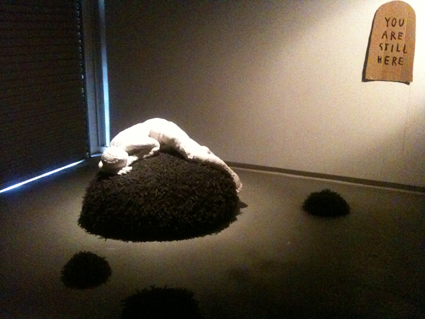
Elizabeth Dunn and Jessie Hall, (please give: it a moment)
photo Nicholas Mills
Elizabeth Dunn and Jessie Hall, (please give: it a moment)
NOW IN ITS SIXTH YEAR, THE ON EDGE FESTIVAL IN CAIRNS IS INSTRUMENTAL IN INTRODUCING NEW WORKS TO NEW AUDIENCES IN FAR NORTHERN QUEENSLAND. THIS YEAR’S PROGRAM, CURATED BY NICHOLAS MILLS, INCLUDED SOUND ART (LIQUID ARCHITECTURE), VIDEO ART (CAO FEI) AND DANCE ON SCREEN (REELDANCE) AS WELL AS PERFORMANCE WORKS. THREE OF THE PERFORMANCE HIGHLIGHTS WERE ELIZABETH DUNN AND JESSIE HALL’S (PLEASE GIVE: IT A MOMENT), POST’S SHAMELESSLY GLITZY WORK AND NICHOLAS MILLS’ OWN 2WHYTE. FOR ME, EACH OF THESE WORKS HAD A REFLECTIVE QUALITY AND MINED THE INNER WORLD OF THE SUBJECT FOR MATERIAL.
(please give: it a moment)
Wallwork Studios has been transformed into an interactive obstacle course. As I enter, I am handed a conical mask with hand-drawn features, suggestive of a shy creature that spends a lot of time in the dark. Wearing this makes me feel as though maybe I too will find a bolthole in which to hide. This is (please give: it a moment), where each audience member becomes the work’s subject via their physical engagement with it. Created by Cairns’ artists Elizabeth Dunn and Jessie Hall, it is fresh from the Next Wave festival in Melbourne.
Other masked creatures inhabit the space. We are guided past fabric mounds and along the way encounter a larger crafted hillock where a life-sized figure made from wool curls like a cat in repose. We move on to a table where we are invited to partake of a conversation conducted entirely via pen and paper. Tea is offered, along with written advice and the messages then affixed to the studio wall—as a sort of ‘moodboard’ of the soul. It’s tea and sympathy and the writing is on the wall.
We are then gently coerced into a cubby constructed of translucent paper, with moving images projected on the back wall. These are landscapes, seemingly shot at twilight from the window of a moving vehicle. By now, I am overtaken by the persona of the mask; I become a kind of hybrid creature that scratches at the door of both human and animal worlds, and it seems that I am viewing these images through new eyes. They offer up a whole new world of opportunities, should I find the courage to step over the threshold of my hidey-hole and venture into the beyond.
(please give: it a moment) is a refreshing take on the interactive installation form, where participants experience a nuanced and subtle trip through the psyche, like animals being coaxed from a subterranean burrow.
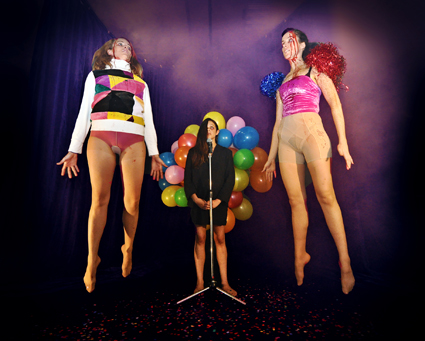
Post, Shamelessly Glitzy Work
photo James Brown
Post, Shamelessly Glitzy Work
shamelessly glitzy work
This offering from Sydney’s Post has had rapturous receptions in Sydney, Melbourne and Brisbane, so it was a sweet treat to see it in Cairns. The piece itself, however, was not without some deliciously tart satire. To open, three sparkly, spangled magicians tease us for an extended time at the microphone with inhalations, lip smacking and inane smiles. What follows is a series of faux magic routines where the performers build up our expectations for the big showstopper to reveal…well that the performer is wearing a patchwork jumper identical to the one she has just removed. The performer gestures “Ta-da!” all the while looking at us knowingly.
As the show progresses, there is a meditation on the rave scene replete with glitter in the laser lights and an account of an incident outside a nightclub where a woman, a self-described melange of Bonne Bell, Maybelline and feminine hygiene spray, considers an offer from a potential suitor. She tells us, “Guys in Barinas have yelled at me before, but this was different.” There are ruminations on contemporary security policies too, where nameless organisations reminiscent of George Orwell’s Thought Police encroach on civil liberties. The performers describe a quasi Big Brother state where the control of one’s mind and fast food choices—“I’ve got the fish burger in my hand, but I really wanted a chicken burger”—rates as serious social concern.
The centrepiece of the show is a vignette where the performers bounce for over 10 minutes to techno music while one boozily bawls “C’mon ladies!” This slowly turns into a wet t-shirt competition and then something more sinister where blood pours from mouths of the ‘contestants.’ This act is chilling in its evocation of sexual objectification and abuse, reinforcing the idea of performance as a political act that can both challenge and reassert structures of power.
The writing is a revelation in a formal sense; all that is said in the first half of the show is repeated in the reverse order in the second. As well the characters constantly allude to the audience’s presence through eye contact and gesture. This staginess, or self-conscious awareness of what Peggy Phelan calls performance’s “maniacally charged present” (Unmarked, Routledge, 1993), is echoed in the performers’ oft-repeated line: “I definitely feel something.” I felt something too, Post, and even if you were being ironic you were generous enough to let us in on the joke.
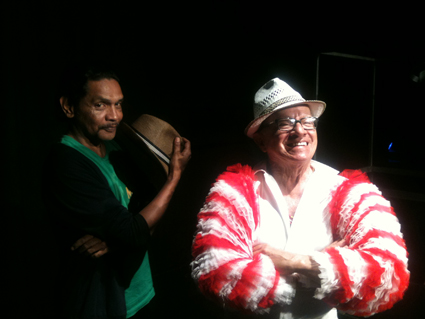
Raymond D Blanco and Raphael Blanco, 2Whyte
photo Nicholas Mills
Raymond D Blanco and Raphael Blanco, 2Whyte
2Whyte
2Whyte was held on the last weekend of the festival and is best described as a work in progress. It has an interesting premise, with Nicholas Mills bringing together two established dancers with the same surname but from different disciplines. Raymond D Blanco is a prominent Indigenous dancer, choreographer and director who has been at the forefront of Indigenous dance and its development, while Raphael Blanco is a 76 year old Cuban dancer and teacher and reportedly one of the first Cuban immigrants to arrive in Australia. Together they bop, boogie and cha cha cha their way through the show, finding common ground through dance.
As the houselights dim we are shown projected text, first about the history of Cuba and then Australia and the Torres Strait. The source cited is Wikipedia and I’m not sure if the team are being ironic or simply relaxed in respect to their research. Next there is a demonstration of Cuban dance moves, projected documentary-style footage and live onstage interviews with the dancers, interspersed with examples from Raymond’s repertoire. His evident joy in performing to Silver Convention’s Lady Bump (presumably a favourite from his formative years) is so infectious that we find ourselves bopping along in our chairs.
One audience member described this work as “docu-dance” and it shone when we were able to glimpse into the dancers’ psyches. Each grappled in their own way with the notion of being categorised as an ‘older dancer’ and the significance of this for their careers resonated with the sympathetic audience. Perhaps the work would benefit from a little more finessing and some direction in relation to teasing out further synergies, however, the performers held us with their charm and zeal.
Like the individual performances within it, the On Edge festival offers fascinating insights into the interior worlds of artists and audiences alike. The festival makes an integral contribution to the far northern landscape and its arts community with a celebration of contemporary performance and media works from all over Australia and the world.
2010 On Edge Festival: (please give: it a moment), creators Elizabeth Dunn and Jessie Hall, Wallwork Studios, July 4-7; post, Shamelessly Glitzy Work, created and performed by Mish Grigor, Natalie Rose and Zoe Coombs Marr, COCA Theatre, July 8-9; 2Whyte, director and media Nicholas Mills, performers Raymond D Blanco and Raphael Blanco, COCA Theatre July 15-17; www.onedgeart.com/
RealTime issue #98 Aug-Sept 2010 pg. web
© Victoria Carless; for permission to reproduce apply to realtime@realtimearts.net
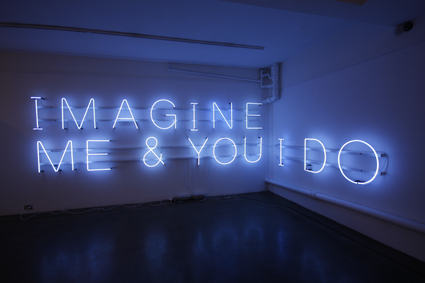
Kirsty Hulm, Imagine Me & You I Do
photo courtesy of the artist and Criterion Gallery
Kirsty Hulm, Imagine Me & You I Do
THE UN-VICTORIOUS EXHIBITION IS ONE OF THE MOST INTERESTING, IF SOMEWHAT ELUSIVE, THAT I HAVE SEEN AT CRITERION GALLERY, ARGUABLY THE BEST COMMERCIAL GALLERY IN HOBART AND THE ONLY ONE IN THE CBD. CRITERION HAS BEEN IN BUSINESS FOR ABOUT SEVEN YEARS NOW (THOUGH SOMEHOW IT STILL SEEMS NEW) AND CLEARLY HAS A POLICY OF FOSTERING TASMANIAN AND AUSTRALIAN ARTISTS WHOSE WORK IS “OUT THERE,” WHETHER THEY ARE EMERGING OR ESTABLISHED. THIS MAKES FOR A VARIED AND REWARDING RAFT OF SHOWS—GRAFFITI ART, DIGITAL PRINTS, AND VIDEO AS WELL AS SOME MORE TRADITIONAL MEDIA.
The Un-Victorious is no exception. It has a sparseness that works well in the pristine, relatively small white cube that is the Criterion. It is a three-hander show featuring Victorian artists. Kirsty Hulm’s work is a neon light installation of text and the other element of the show, bejewelled mock-ups of military medals, are the result of a collaboration by Andrew Hustwaite and Anna Varendorff. The catalogue cover shows Kirsty Hulm’s 2008 neon sign work Imagine Me & You I Do installed on the exterior of a dark, gothic-looking church, so nothing could be more different than the Criterion display, in which the neon words snake 90 degrees around two white gallery walls. In both sites Hulm’s large-scale work is strikingly beautiful, not a little eerie and certainly evidence of the artist knowing how to work with her medium. The source of the title eludes me—certainly it is from some 60s or 70s pop song and the catalogue essay talks of “the harlot’s sultry call from arms to the bed ‘Imagine me and you … I do’.”
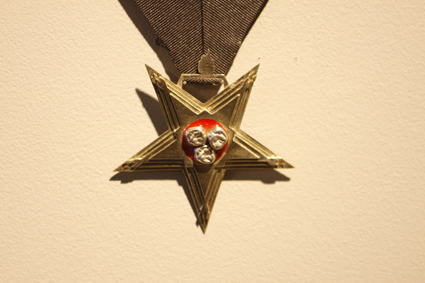
Andrew Hustwaite and Anna Varendorff, Proposition 1-5
photo courtesy of the artists and Criterion Gallery
Andrew Hustwaite and Anna Varendorff, Proposition 1-5
Hustwaite and Varendorff’s series of five very authentic-looking medals, complete with differently coloured ribbons, are hung in a V formation. They are very aesthetically pleasing objects and are made from materials such as nickel, copper and brass with silver plating and amalgam. Going by the names of Proposition I-5, they would have taken considerable skill to manufacture. Varying in size and hue, the medals are generally star-shaped and, taking up two panels in the gallery, make an exciting installation. They are eminently collectible, eminently desirable and titles such as “Above and Beyond the Fall of Duty” convey an unmistakable anti-war message.
The catalogue essay, by Jess Nossiter, is outstanding. Nossiter is a (presumably) self-styled Chevalier de la Manchette and “writer and flaneur based in Hobart,” though this city does not immediately strike me as the milieu for the flaneur. His essay is a work of art in itself—a piece of writing quite beyond definition or categorisation—Hunter S Thompson meets Lewis Carroll perhaps: wryly amusing, intellectually rigorous with a touch of soft porn! Nossiter touches on sex, popular television culture, reality TV, capitalism and, cynically, love. He concludes, “Love is a capitalist construction, an exchange of commodities. Littered with prophylactics, and the air filled with blank shots—love truly is a battlefield.” More significantly, the essay draws together two very different works and gives them a unity, without which the show would be even more elusive.
The intimate gallery space of the Criterion is an ideal venue for what is, in fact, a very small show. It would probably not have worked in a bigger venue, but then the curator Sarah Jones has clearly chosen the works with the Criterion in mind. Remarkably, Jones only received her BFA in 2007 and has since participated in several shows at Hobart venues. Last year she was the recipient of the Contemporary Art Services Emerging Curator Mentorship. For The Un-Victorious she has done a fine job discovering and promoting the three artists, not to mention the essayist. Like Jones, the artists and writer have themselves only recently completed their degrees or are still undertaking them. With the quality of works in this show being so high, it augurs well.
Kirsty Hulm, Imagine Me & You I Do; Andrew Hustwaite and Anna Varendorff, Proposition 1-5; curator Sarah Jones, The Un-Victorious, Criterion Gallery, Hobart, June 10-July 3 http://www.criteriongallery.com.au/
RealTime issue #98 Aug-Sept 2010 pg. web
© Diana Klaosen; for permission to reproduce apply to realtime@realtimearts.net

Tony Abbott, Loading
photo Tony Abbott Is Right website, reproduced under Creative Commons license Attribution-Non-Commercial 2.0
Tony Abbott, Loading
DURING THE 2010 FEDERAL GOVERNMENT ELECTION CAMPAIGN CALLS ARE INTENSIFYING FOR ALL POLITICAL PARTIES TO DEVELOP COHERENT CULTURAL POLICIES. A NUMBER OF FACTORS, ACCUMULATING OVER MANY YEARS BUT NOW MORE MARKEDLY EVIDENT, UNDERLIE THE URGENCY FOR CREATING A NATIONAL CULTURAL POLICY.
These factors include policy making on the run (reactive funding initiatives from Arts Ministers), significant changes within the arts (new forms, new technologies) and arts education (creative degrees), inadequate arts education in primary and secondary school, increasing censoriousness (the Bill Henson ‘affair,’ internet filtering), underpaid artists and a widespread devaluing of the arts (as elitist and self-serving) despite statistical evidence of growing attendance and participation figures across Australia.
This brief guide to the national cultural policy discussion begins with Arts Minister Peter Garrett’s online public discussion (without his own participation) of his Discussion Framework towards a policy. It’s followed by the most substantial engagement with the issue this year, from Marcus Westbury and Ben Eltham, and a response to one of their recommendations (about the future of the Australia Council for the Arts) from Christopher Madden. In a spirit of greater cultural inclusiveness, Westbury and Eltham substantially broaden the arts ambit (embracing non-mainstream, underground and creative industries practices), as does Helen O’Neill in Griffith Review 23 while in the same edition Robyn Archer defends art from the incursion of the creative industries model.
With its valuable historical and economic perspectives, David Throsby’s Platform Paper No. 7, “Does Australia Need a Cultural Policy?” provides a brisk, cogent argument for a national cultural policy, although Jana Perkovic in RealTime worries about the use of ‘economy’ as a principle benchmark in the making of policy: “Artists should understand the power of words. At the moment, one of these is ‘economy.’ Being good or bad for the economy, vaguely defined, is argument enough to defend or shelve a policy. Agreeing that we have a ‘culture’ would allow a whole new string of arguments to be made and, with due respect to David Throsby, defend the arts not on the grounds of its goodness for the economy, community or health, but simply as important for our culture.”
Kevin Rudd’s 2009 Summit and Peter Garrett’s subsequent National Cultural Policy Discussion created expectations that have yet to be met. Garrett did not address proposed changes to unemployment benefits in favour of artists (the Greens have embraced this in the election campaign), instead delivering the micro-business modelled ArtStart designed exclusively for tertiary education graduates (“I think this makes ArtStart the only Australia Council grant program that requires an artist to hold formal qualifications.” Peter Anderson, “Visual Arts Education: Between research & the market,” http://www.realtimearts.net/article/98/9959).
While ArtStart and its likes look good for emerging artists, without a coherent arts policy (let alone a cultural policy) they could put artists on the path to a dead end: where is the policy that points towards the development of an arts infrastructure that will accommodate the growing numbers of arts graduates (and the non-academically trained)? As attractive and significant as the micro-business model is and, for some, the correlative argument for a de-institutionalisation of the arts, we need to recognise the arts as a complex system requiring a subtle response—no easy task in an era of reductionist binary thinking. A national cultural policy that can do justice to the arts and to artists is not going to be easy to achieve, but one thing above all we must be mindful of is that art is not merely part of culture—art builds, fuels and transforms culture.
Discussion: National Cultural Policy
Minister for the Environment, Heritage and the Arts, http://nationalculturalpolicy.com.au The site includes Arts Minister Peter Garrett’s address to the National Press Club, October 27, 2009 and the National Cultural Policy Discussion Framework. Submissions can now be found in the Library section.
Sharing the Luck: Cultural Policy in Australia
Marcus Westbury and Ben Eltham, Centre for Policy Development http://morethanluck.cpd.org.au/sharing-the-luck/cultural-policy-in-australia/
Marcus Westbury, “Suggestions for politicians in search of a cheap arts policy,” The Age, August 2 http://www.theage.com.au/entertainment/art-and-design/suggestions-for-politicians-in-search-of-a-cheap-arts-policy-20100801-111ce.html
Christopher Madden, “In defence of the Australia Council,” ArtsHub, August 2 http://www.artshub.com.au/au/news-article/opinions/architecture-and-design/in-defence-of-the-australia-council-181853?sc=1
The art in cultural policy making
Gavin Findlay: Peter Garrett’s national cultural policy discussion
http://www.realtimearts.net/article/issue96/9805
Culture: an intangible, protectable & nurturable good
Jana Perkovic: cultural policy and the arts
http://www.realtimearts.net/article/issue97/9855
David Throsby, Does Australia Need a Cultural Policy?, Platform Paper, Currency House, Sydney, January 2006
Jennifer Craik, Re-visioning arts and cultural policy: Current impasses and future directions, http://epress.anu.edu.au/revisioning_citation.html, July 2007, ANU E Press, co-published with the Australia and New Zealand School of Government
Workshop on Cultural Policy, Culture and Policy, Griffith University, Vol 8, No 1,1997
Helen O’Neill, “Ratbags at the Gates,” Griffith Review 23, Essentially Creative, ABC Books/Griffith University, Autumn 2009
Robyn Archer, “Industry that pays, and art that doesn’t,” Griffith Review 23, Essentially Creative, ABC Books/Griffith University, Autumn 2009
Forum: “A National Cultural Policy for Australia”, Australian Performing Arts Market, February 22, Adelaide 2010; includes downloadable panel discussion transcription. Facilitator Sarah Miller, Speakers: Bronwyn Edinger, Kathy Keele, Greg Mackie, Chris Puplick and?David Throsby
http://www.performingartsmarket.com.au/keynote-and-forums
The Music Show, ABC Radio National
Andrew Ford with Marshall McGuire, Clare Bowditch, Graham Wood, Sandy Evans and Michael Kieran Harvey musicians http://www.abc.net.au/rn/musicshow/stories/2010/2982941.htm
ArtWorks, ABC Radio National, August 8
Amanda Smith with Marcus Westbury and Chris Puplick
http://www.abc.net.au/rn/artworks/stories/2010/2969104.htm
Julian Meyrick, Cultural Policy in Australia
Meyrick is a writer and theatre director and, with Marcus Westbury and others, a member of the Arts Minister’s Creative Australia Advisory Group.
Streamed talk, October 19, 2009, Baldy Centre for Law & Social Policy, University of Buffalo, USA. Access via AustralianPolicyOnline:
http://www.apo.org.au/video/cultural-policy-australia
RealTime issue #98 Aug-Sept 2010 pg. web
© Keith Gallasch; for permission to reproduce apply to realtime@realtimearts.net
THOUGH THE ARTS AND CREATIVE INDUSTRIES MAY HAVE BEEN ABSENT FROM POLICY DEBATES, CREATIVITY ITSELF HAS NEVERTHELESS BEEN A VIGOROUS PRESENCE DURING THE 2010 FEDERAL GOVERNMENT ELECTION CAMPAIGN. WITNESS, FOR INSTANCE, THE SUCCESS OF THE ABC’S GRUEN NATION PROGRAM, WHICH NOT ONLY ANALYSED ACTUAL POLITICAL CAMPAIGNS BUT ALSO PRODUCED ALTERNATIVE ONES AS WELL.
In the first week of Gruen Nation, ad agencies were asked to humanise Tony Abbott and tell Julia Gillard’s back story. In the second week, another two agencies were brought in to mobilise fear about Labor and the Coalition. In the third episode, one agency created an ad to inspire mainstream voters to vote for the Greens while another encouraged Greens voters to endorse a mainstream party. The former was so impressive that the party approached the ABC about using the ad. While they weren’t allowed to do so, they benefited nonetheless as the video went viral.
Also on the ABC, the Chaser has returned with a program called Yes We Canberra, featuring a staring competition with Julie Bishop, a game of Guess Who? with Tanya Plibersek and a “Pollie Graph” test for Maxine McKew.
fake politicians
Beyond the box, there are the secret pleasures of the Fake Senator Steve Fielding’s twitter account. In fact, there’s a whole fake twitter parliament and press gallery (see Bella Counihan’s article), including a fake Gillard, three fake Abbotts (one of which was set up by the ALP) and a fake Andrew Bolt, but Fake Fielding remains my favourite. He tweets about the finer points of policy (“Family Fist [sic] wants more for our kids education. Less iMacs, more Bibles”) and politicking (“Susan was right, the bottle suit does scare children”), as well as the joy of Milo (“Absolutely tonguing for a hot Milo right now but Susan’s out and I’m not allowed to use the microwave unsupervised”) and the perils of preparing it (“Disaster. Milo everywhere. So much tears”). He has more followers than the real Fielding (3165 as opposed to 2141) and considerably more tactical nous, constantly consulting with Senator Nick Xenophon (variously spelled Xzenophonne, Xemaphore, Xzuezephone).
While impersonating someone on twitter certainly takes effort, it requires even more energy to do physical and vocal impressions. Sadly Anthony Ackroyd’s Kevin Rudd may have to be retired, but there are a variety of Gillard impersonators ready to step into the breach, including Amanda Bishop (seen here and here, as well as an interview here), Gabby Millgate as Julia Spillard, and Lynne Cazaly as Gulia Jillard. Get Up! has also used a Gillard impersonator in its parody of a coffee ad (“Hello, would you like to grab a coffee and talk about climate change?…Tony’s about direct action, I’m about acting directly.”)
get up! gets up
Get Up! itself has had a stellar campaign, winning a famous victory in the High Court and in doing so enabling an additional 100,000 Australians to cast their vote. Beyond campaigning on climate change and voting rights, Get Up! has also campaigned about internet censorship, mental health, women’s issues and asylum seekers. You can see all their campaigns here: http://www.youtube.com/user/getupaustralia
activist art
The mention of asylum seekers brings to mind the work of the group boat-people.org. In response to the escalating rhetoric on refugees, including the Liberal party’s infamous Dad’s Army arrows, Julia Gillard’s regional processing centre and the Department of Immigration and Citizenship’s new No to People Smuggling YouTube channel, boat-people.org have staged two Muffled Protests, one in Melbourne and another in Sydney. The protest features people slowly wrapping the Australian flag around their heads. The resultant image is dense with allusions, recalling Magritte and Abu Ghraib all in the same simple gesture.
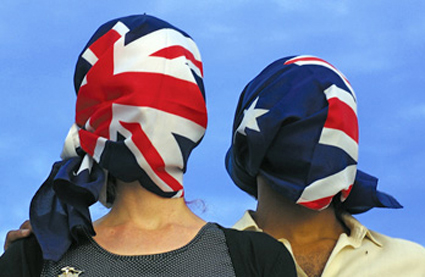
Muffled Protest
photo boat-people.org
Muffled Protest
One member of the group, Deborah Kelly, has also produced another image aimed at Family First (perhaps Fake Fielding could post a twitpic).
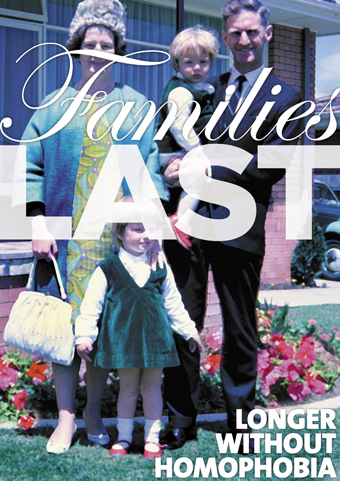
Families Last
photo Deborah Kelly (copyleft)
Families Last
Elsewhere, Stephen Rowley, as cinephobia, has redesigned Obama’s Hope poster as Abbott’s Nope.

The Audacity of Nope, Created in honour of Tony Abbott’s ascension to the Liberal leadership, and his blocking of the ETS
photo Stephen Rowley, cinephobia, reproduced under Creative Commons license Attribution-Non-Commercial 2.0
The Audacity of Nope, Created in honour of Tony Abbott’s ascension to the Liberal leadership, and his blocking of the ETS
The image is now the profile picture for the Facebook group Friends Don’t Let Friends Vote Liberal. While you’re on Facebook you might like to join Tony Abbott’s Ladies Auxiliary. But if you’re a bit shy, then you can still enjoy their work here.
campaign jamming, campaign loading
While culture jamming is usually associated with subversive politics, political parties are increasingly trying to co-opt the tactic for their own purposes. See for instance the Labor party’s Tony Abbott Is Right website, where users can download a template and make their own Tony Abbott poster. One of the most popular posters features a pixellated Abbott with the slogan “Tony Abbott, Loading …”
There is a sense in which the campaign itself is still loading—the Liberal launch was only last week while the Labor launch is today (Monday, August 16). Both parties have taken vows of austerity, which has prevented them from announcing any major new policies. If it makes you nostalgic for more exciting times, you might like to revisit the It’s Time campaign or, at the other end of the Whitlam era, Norman Gunston’s take on The Dismissal in 1975. One YouTube commentor calls the moment “surreal,” adding that it’s “like Borat trying to interview Bush in 2000.”
Speaking of surreal, what to make of Mark Latham? This article was written before his 60 Minutes report went to air, but it may be that Latham’s performance as a journalist turns out to be the greatest parody of them all.
RealTime issue #98 Aug-Sept 2010 pg. web
© Caroline Wake; for permission to reproduce apply to realtime@realtimearts.net
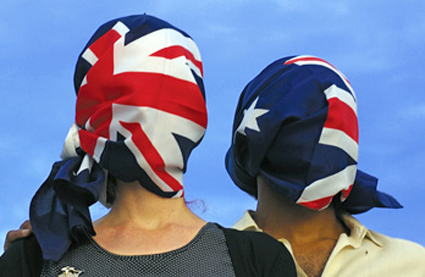
Muffled Protest
photo boat-people.org
Muffled Protest
THE 2010 FEDERAL ELECTION CAMPAIGN HAS BEEN DISGRACEFULLY NOTABLE FOR THE ZERO LEVEL OF LABOR AND COALITION ENGAGEMENT WITH ART, SCIENCE, SPORT (NOW, LIKE ART, CHARGED WITH ELITISM BY THE CRAWFORD REPORT) OR AUSTRALIA’S ABORIGINAL POPULATION. PETER GARRETT IS AN INVISIBLE ARTS MINISTER. TO DATE, ONLY THE GREENS HAVE PROMISED NEW INVESTMENT IN THE ARTS. BUT IT’S THE CULTURAL POLICY ISSUE WHICH EMERGED WELL BEFORE THE ELECTION CAMPAIGN AND WILL LONG OUTLIVE IT.
Peak Arts organisations (gathered together under the ArtsPeak banner), ABC Radio National arts programs and, especially, Marcus Westbury and Ben Eltham of the Centre for Policy Development (“Sharing the Luck: Cultural Policy in Australia” http://morethanluck.cpd.org.au/sharing-the-luck/cultural-policy-in-australia/) have prompted artists and the general public to apply pressure to the parties to embrace the arts in their election policies.
new directions, different paths
The greatest emphasis has been on the need for a national cultural policy with Westbury and Eltham pushing the notion in new directions, if divisively—demanding redistribution of funding from the major performing arts organisations (Opera Australia in particular) to the small to medium sector including areas like design, computer gaming, graphic arts, animation and others hitherto associated with an ‘underground’ not interested in funding (or engagement with government) or the creative industries that have one foot planted, if often lightly, in the commercial landscape. Westbury has written: “It is easy to argue that such people do not need funding. It is probably a reason for their relative vitality that they don’t. But that does not mean that they are without needs or that we can simply pretend that they do not exist” (“Evolution and Creation: Australia’s Funding Bodies,” Meanjin, Vol 68, No2, 2009).
It’s a pity that instead of arguing for greater funding overall for the arts and that the government ought to reconsider what comprises the arts (under the broader rubric of culture), Westbury and Eltham implicitly exhort the arts to instead turn on itself. Likewise, the writers problematically set up the Australia Council for the Arts as the target for their dissatisfaction with the status quo. As Christopher Madden argues eloquently on Arts Hub (“In defence of the Australia Council,” August 2 http://www.artshub.com.au/au/news-article/opinions/architecture-and-design/in-defence-of-the-australia-council-181853?sc=1), government itself—the Department for the Arts—is the more apt target. “If Australia’s cultural policies are a shambles, then the real source of the problem is central government, represented by the bureaucratic behemoth that is the Department. By international standards, the Department is not doing all it should be doing, and is doing many things it shouldn’t. This is hardly surprising for an agency in which arts and heritage are subsumed by such momentous portfolios as environment and water.”
Westbury and Eltham call for the dissolving or reform of the Australia Council (the two have different views on this: see the response pages at the end of their paper) and the establishment of a new cultural agency with whole of government management of culture (linking the arts with health, education, urban planning etc), resonating with the demands coming from ArtsPeak and others. To be effectively realised, Madden argues, an internal government agency would be needed to make this work—not one at arm’s length from it: “Proper engagement from within central government would let the Australia Council get on with what it does best, being an arts council.” Yes, but how are artists to have input into the making of arts policy in an increasingly top down political climate? Through ArtsPeak and consultative committees? A national cultural policy should include a guarantee of artist consultation in respect of policy realisation: but how would that be made effective?
inclusiveness & divisiveness
The strength of the Westbury and Eltham policy paper otherwise lies in its inclusiveness: recognising culture as more than the arts (or is it really a broader notion of what comprises art); abandoning “the false divide between high art and popular culture”—particularly apt in a time of unpredictable and innovative change; and “cutting the red tape that affects culture” to allow artists to access low rent work places and capital. The latter involves “putting in place policy settings that allow [artists] to perform, present and produce with limited capital [and] is more important (and effective) in ensuring their success than direct subsidies.” This last proposition could be comfortably adopted by the slash and burn Coalition.
On the other hand, the writers also propose funding “artists and productions, not institutions.” This reads like a radical proposal on behalf of underpaid artists but it fails to acknowledge rank and file orchestral players, choruses, ballet and contemporary dancers and actors and theatre support staff (set builders, stage hands, technicians etc) who comprise a large part of Australia’s arts ecosystem, many of whom are not exclusively involved in heritage arts. While we might be shocked at the per seat subsidy for an opera ticket (and at the high ticket cost for many opera lovers who are not well-off) it would be negligent to ignore the very nature and complexity of arts institutions, let alone the benefits of the outreach programs of some of the larger ones.
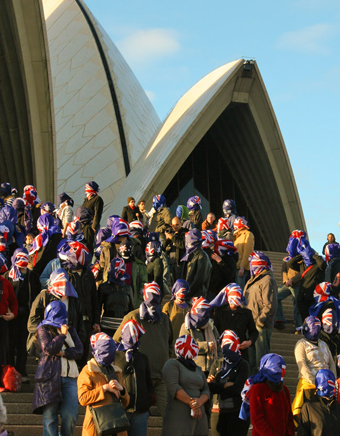
Around 70 people joined Muffled Protest on Saturday, August 2, 2010 “to show up the blind nationalism and xenophobia fueling the fear rhetoric surrounding refugees and asylum seekers.”
cultural and economic reciprocity
It is undeniable that the small to medium sector has been consistently underfunded relative to its larger peers (and their recurrent rescue packages) and that this needs to be addressed, but funding redistribution would be a crude and cruel tool. Increased funding is vital, consistent with national economic growth and reciprocating artists’ contribution to the Australian economy—”While nine out of 10 Australians participate in the arts, the federal government invests in this area less than one per cent of its expenditure overall,” ArtsPeak).
New funding should not come in the form of one-off initiatives but as part of a coherent national cultural policy, one that acknowledges the need for consistent funding and other strategies outlined by Westbury and Eltham, ArtsPeak, Throsby and others. A national cultural policy should entail, for the arts, whole of government engagement, education in the arts for all, protection of artists’ rights, a reassessment of the scope of the arts, the introduction of tax incentives and social security for artists, the collection and analysis of “adequate statistical and qualitative data that identifies both economic and social return on investment,” “forging a national research agenda for arts and culture based on policy development and private investment” and the protection of Australian culture “in the context of international trade agreements” (ArtsPeak).
the greens & the arts
The Greens’ latest election policy anouncement is responsive to key areas of development—R&D, national access and export. It includes a proposal to invest $5m in a research and development fund for new work; $10m in overseas touring; and additional funds for regional touring. As well the Greens promise to improve artist incomes through a copyright issue consultation, “Centrelink recognition of engagement in art as part of a dole recipient’s mutual obligation requirement,” revision of the Resale Royalty Scheme and the institution of a $3 million Artists’ Fund to assist publicly funded galleries to pay artists’ fees (Australian Financial Review, Aug 13). These Greens initiatives go some way to establishing in practical terms some of the principles that might be integral to a national cultural policy.
For a brief guide to books, essays and online material go to: A short guide: national cultural policy
Boat-people.org is an art gang which has been making work around race, nation, history and borders since 2001. The group’s current work, Muffled Protest, is a distributed expression of dismay in cities around Australia. You can participate! See www.boat-people.org
RealTime issue #98 Aug-Sept 2010 pg. web
© Keith Gallasch; for permission to reproduce apply to realtime@realtimearts.net

Families Last
photo Deborah Kelly (copyleft)
Families Last
WE NEED A NATIONAL CULTURAL POLICY THAT FORMALLY RECOGNISES THE IMPORTANCE OF THE ARTS TO SUSTAINING, ENRICHING AND DEVELOPING AUSTRALIAN CULTURAL LIFE.
As David Throsby has argued in “Does Australia Need a Cultural Policy?” (Platform Paper 7, Currency House, January, 2006) we need consistency, not “policy by review”—Nugent, Myer, Strong and the various ‘initiatives’ have come from pressured Arts Ministers, not from the Australia Council which then has to execute the initiatives. As Throsby points out it makes Ministers look simply “reactive,” responding to problems, often inadequately, and then, as with the major performing arts organisations, having to address them again.
The difficult thing about major policies, like a Human Rights Charter or a national cultural policy, is that they can be expressed as well-intentioned grand generalities or, evasively, as mere motherhood statements. Interestingly, once Peter Garrett put out his ‘over the summer holidays’ request of ideas for a policy (closed Feb 1, 2010), most of the responses were not policies per se but funding and other strategic wishlists, if quite policy indicative ones.
Some writers who contributed to the discussion questioned the very notion of having a cultural policy: would it define our diverse cultures too narrowly?; allow for the revival of the Howard government’s invocation of the ‘un-Australian’?; limit artists’ right to agitate? Like those who object to having an Australian Human Rights Charter, some of these writers feared greater political and bureaucratic intrusion into and regulation of the arts. Other respondents saw a cultural policy as a means to cementing into place the hitherto uncertain standing of art in Australia. Some wished to redefine art, making it one part of the creative industries. One writer argued that art is irrelevant to the cultural lives of many Australians.
The majority of responses focused on the plight of individual artists and organisations in the ‘small to medium’ sector, the lack of a pervasive arts policy in the education realm, extensive regional disadvantage, shortage of artist workspaces, constrained library and other collections and limited arts coverage on ABC TV.
Writers saw potential correctives in the shape of private sector investment in the arts (through means similar to film funding tax rebate mechanisms); greater pressure to promote philanthropy for the arts; the redistribution to the small to medium sector of funding allocated for major arts institutions; audience development campaigns; improved television reporting and wider access to the arts through digital media; the creation of artist-specific tax and unemployment benefit schemes (side-stepped when Garrett introduced Artstart); and support for more art-led urban renewal ventures like Renew Newcastle. A few respondents argued that if we are to have a national cultural policy, a discrete Ministry for Culture & the Arts would be warranted. Garrett is Minister for Environment Protection, Heritage and the Arts, but the Department of the Environment, Water, Heritage and the Arts covers a number of portfolios in which, as Christopher Madden has commented, the arts sector is a small player (“In defence of the Australia Council,” ArtsHub, August 2 http://www.artshub.com.au/au/news-article/opinions/architecture-and-design/in-defence-of-the-australia-council-181853?sc=1).
Central to the online discussion and subsequent debate is a desire for guaranteed equitable access, socially and geographically, to the means to enjoy, participate in and make art. Let’s hope that the pressure currently applied to the major political parties to develop a national cultural policy persists beyond an election that is not likely to resolve the matter. Let’s hope too that Australians can move towards acknowledging that the arts are not discrete from culture, but are integral to it, nurturing and making culture. Just because more Australians are engaged with art does not mean that this understanding is inherent.
For a brief guide to books, essays and online material go to: A short guide: national cultural policy
Deborah Kelly is a leading Australian arts activist whose works include Tank Man Tango: A Tiananmen Memorial http://www.realtimearts.net/article/issue93/9564. Families Last was made in 2010 in response to antigay pronouncements from Family First candidates
RealTime issue #98 Aug-Sept 2010 pg. web
© Keith Gallasch; for permission to reproduce apply to realtime@realtimearts.net
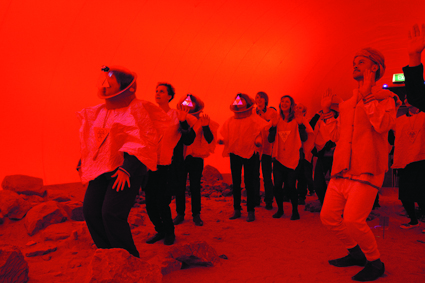
100 Proofs the Earth is Not a Globe, Tape Projects
photo Shea Bresnehan
100 Proofs the Earth is Not a Globe, Tape Projects
NEXT WAVE FESTIVAL IS RIGHTLY SEEN AS A MELTING POT WHERE YOUNG ARTISTS CHALLENGE TRADITIONAL CREATIVE APPROACHES AND METHODS OF PRESENTATION. THERE IS ALSO AN EXPECTATION THAT VISITORS WILL ACTIVELY CONTRIBUTE TO THIS DIALOGUE. ALTHOUGH THIS YEAR’S FESTIVAL CONTAINED NUMEROUS EXAMPLES OF EXHIBITIONS AND PERFORMANCES IN TRADITIONAL VENUES, MANY OTHER PROJECTS RELIED UPON NON-TRADITIONAL AUDIENCE ENGAGEMENT. THIS IS CHARACTERISTIC OF AN ORGANISATION THAT SUPPORTS YOUNG AND EMERGING ARTISTS, AND IT RESONATED PARTICULARLY WELL WITH THE THEME OF THE 2010 NEXT WAVE FESTIVAL, “NO RISK TOO GREAT,” ENCOURAGING NOT ONLY ARTISTS BUT ALSO VIEWERS TO STEP OUTSIDE THEIR COMFORT ZONES.
sunset over cardboard mountains
Sunset Over Cardboard Mountains, by artists Rachel Feery, Ed Gould and Lisa Stewart, proved a fitting beginning to my voyage through this year’s festival. While a number of Next Wave pieces broadly picked up on the idea that ‘risk taking’ is often the domain of youth, this work responded to the ways that children experience and negotiate the unknown, the scary and the risky through storytelling, role-playing and imagination.
An audience of 12, each member in their own individual cardboard box (cushions provided), sits inside a large tent-like structure. The lights go down, a live but unseen musical accompaniment begins and the tent fabric shakes, as if buffeted by a strong wind. From this point onwards the audience is treated to a low-fi performance of lighting, shadow and video effects which poignantly evoke common rites of passage. From confronting silhouetted ‘tree-monsters’ that appear during storms, to telling ghost stories by torchlight under bed sheets, to constructing fantastic machines and fortresses out of cardboard boxes and quilts, these childhood modes of play and initiation were all joyfully revisited by Sunset Over Cardboard Mountains in an immersive and often surprising performance.
100 proofs the earth is not a globe
The highly anticipated, ambitious 100 Proofs the Earth is Not a Globe from Melbourne-based collective Tape Projects did not disappoint. Tape Projects worked with the Victorian Space Science Education Centre at Strathmore Secondary College to develop 100 Proofs, shifting their artistic focus from visual arts projects towards a performative and experiential practice.
100 Proofs took viewers on a highly choreographed trip into a seamlessly constructed environment in which fantasy, fiction and alternate realities collided with rational and logical experience. The Space Science Education Centre was transformed each night into an otherworldly research facility, full of focused yet strangely attired inhabitants in a time warp. At the outset, the audience was divided into two groups (blue and red) and we were each assigned an alter ego. I became Raphael Constantinescu of the Personnel Department.
Being a member of the blue group, I was required to complete a number of pre-designated experiments. Armed with a lab coat and a clip-board Raphael Constantinescu was ushered through a series of tasks which included estimating the weight of a rock, sketching with a non-preferred hand, determining a ‘magic number’ through a series of calculations and observing and analysing the movements of a strange group of subjects (the red team). While the significance of these tasks was often unclear, in the context of the performance they took on a strange sense of urgency and purpose. By compelling the audience to act out roles as either scientists or subjects, 100 Proofs provided a thoroughly enjoyable and fascinating commentary on our understanding of scientific knowledge. As the work’s title implies, often our perceived reality is at odds with scientific truth. The minutiae and detail of scientific process and logic can obscure broader contexts and implications; science can go too far. At the same time, the imaginative possibilities of science are enticing and enthralling as science fiction rapidly turns into science fact.
evolution
Evolution by Safari Team (Blaine Cooper, Lillian O’Neil, Jon Oldmeadow) was yet another work inspired by scientific progress and imagined futures. By flagrantly opposing the supremacy of 19th century religious beliefs and institutions, Charles Darwin will forever be acknowledged as one of history’s greatest risk-takers, a figure whose ideas to this day remain controversial and passionately contested by the champions of Creationism and Intelligent Design.
A five-screen video installation, Evolution, located in ArtPlay in Birrarung Marr on the north bank of the River Yarra, responded to some of the ways that the general public are often introduced to and made familiar with scientific discoveries. The series of carefully composed images that repeated across the five screens seemed to be inspired by a warped view of natural history documentaries and science fiction films, mashed up into a dystopic vision of scientific endeavours.
I had high expectations for Evolution, but unfortunately it failed to live up to Safari Team’s delightful Molto Morte (2008), one of the highlights of the 2008 Next Wave Festival. Unlike 100 Proofs, which cleverly critiqued methods of scientific research and discovery, Evolution did not engage as strongly with the very real and fascinating contemporary dialogues around human evolutionary activity, such as the fact that humans can now actively control and dictate evolution through technological advances—evolution through ‘unnatural’ selection. The piece was certainly not narrative-based, however it needed a stronger overarching structure, or perhaps a soundtrack or some kind of aural accompaniment, to draw the compelling but disparate images into a more fluid conversation with each other.
Furthermore, the installation did little to enhance the artwork, making it appear too ambitious for an outdoor location. As well, time-based artworks are forever burdened with the necessity of having to engage viewers relatively quickly, and even then they don’t necessarily stay long. However, when the artwork is installed outdoors, after hours and during a festival that creeps into Melbourne Winter, the challenge is amplified.
doomsday vanitas
In this sense, Nicole Breedon’s Next Wave project, Doomsday Vanitas was a minimal but ultimately more successful example of a media artwork conceived for public space. Breedon projected hologram-like images of common objects onto buildings in Guildford Lane and surrounds. These were not complex images, yet as viewers discovered each successive projection amongst the alleys they were rewarded immediately, as the artworks’ simplicity and surprising beauty melded perfectly with their laneway environment. Rendered as gently rotating and glowing still-lifes, everyday items such as a water bottle, Swiss Army knife and an axe assumed an ominous quality within the urban environment, reflecting ongoing concerns to do with street violence and weapons culture.
film that will end in death
Perhaps the most literal exploration of the festival’s theme was Trevor Flinn’s Film that will end in Death. Based in Dunkeld in regional Victoria, Flinn identified and interviewed a number of people in ‘risky’ occupations—from lion taming and bull riding to wildlife rescue—questioning them about their relationship and attraction to risk. In the film, as in real life, Flinn has an endearing and engaging personality, which draws out candid admissions and stories from his interviewees. His dry sense of humour, wide-eyed enthusiasm and self-confessed ‘risk-averse’ personality make him the perfect foil for his subjects.
Interestingly, many of Flinn’s subjects spoke about their rather dangerous pastimes and jobs not so much in terms of ‘thrill-seeking’ impulses, but rather as almost normal activities in which inherent risks needed to be understood, mitigated and minimised. The hilariously blasé lion tamer Matthew Ezekial said that after a while “it’s just a job.” This matter-of-fact sentiment was reflected in the traditional documentary construction of Flinn’s film. It was a welcome and memorable interlude in a festival which, while always encouraging the provocative and the novel, also allows a space for audiences to engage with personal modes of storytelling and presentation.
2010 Next Wave Festival: Sunset Over Cardboard Mountains, Rachel Feery, Ed Gould, Lisa Stewart, Studio 246, May 14-21; Tape Projects, 100 Proofs the Earth is Not a Globe, Lee Anantawat, Cait Foran, Eugenia Lim, Tanja Milbourne, Michael Prior, Zoe Scoglio, Jessie Scott, Victorian Space Science Education Centre, May 19-28; Safari Team, Evolution, Blaine Cooper, Lillian O’Neil, Jon Oldmeadow, Birrarung Marr, May 13-30; Doomsday Vanitas, Nicole Breedon, various locations, May 13-30; Film that will end in Death, Trevor Flinn, Kings ARI, May 8-31
RealTime issue #98 Aug-Sept 2010 pg. 41
© Kate Warren; for permission to reproduce apply to realtime@realtimearts.net
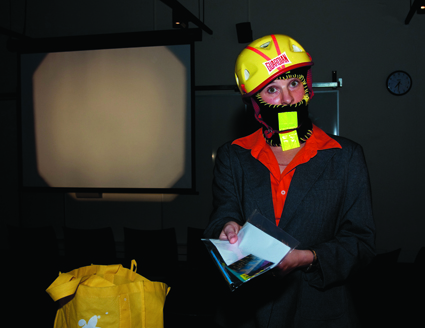
Paula van Beek, Dangerous Melbourne
photo Oliver Parzer
Paula van Beek, Dangerous Melbourne
WE’RE HAVING TEA AND BISCUITS IN A SEMINAR ROOM ABOVE MELBOURNE’S CITY LIBRARY. A PASTY FACED CHICK WEARING A PLAID SUIT AND ADIDAS RUNNERS STANDS TO ONE SIDE. TOO MUCH FOUNDATION HAS BEEN APPLIED TO HER FACE. HER EYES HAVE ABOUT THEM THE VAGARIES ASSOCIATED WITH NARCOTIC ADDICTION, AND HER ENTIRE BEING APPEARS TO TREMBLE. SHE GIVES THE IMPRESSION SHE MAY BOLT ACROSS THE ROOM AT ANY MOMENT AND HURL HERSELF OUT THE FIRST FLOOR WINDOW.
dangerous melbourne
But Dangerous Melbourne is an ironic take on the safety seminar. So performer Paula Van Beek instead situates herself before a projector while we the audience are paired off with one another. You know the corporate training drill. Name tags attached to shirts stating ‘Hello, my name is blah, blah, blah…,’ two 15-minute breaks either side of lunch and the assumed authority of an inane team leader who believes in her purpose with a missionary’s zeal. Van Beek advises us to open our eyes and become aware of Melbourne’s dangers, as she projects on a screen sign after relentless sign, each indicating an unreasonable fear of annihilation.
What I experience, however, is a slippage between the formality of the training seminar and the art of performance. Here, the boredom associated with corporate training dissipates revealing a quietly hysterical team leader who is as terrified of being shat on by a pigeon as she is of being pack-raped. Dissolute, Van Beek stands before the bright light of her projector. Contained by emptiness, stepping into the unknown is the most terrifying risk a human being can undertake.
i thought a musical was being made
A Melbourne landmark, the Greek restaurant Stalactites is best known for its chicken souvlakis rather than as a performance venue. We sit at pre-designated tables and a waiter soon delivers a plate containing spanakopita, kalamata olives, dolmades and other Greek goodies. A dude sitting directly across from me explains that he’s a vegan and that therefore I can eat as much of the food as I like. Thanks for that, but eating in a performance context is a sly form of audience participation; one that often has unforeseen consequences.
Filtering through my headphones is a sonorous mix of atmospherics and performance poetry. Through a window, it soon becomes apparent that a second event is also taking place, outside in Lonsdale Street. But I’m seated in such a way that I can’t see the action; which is quite interesting really: being prevented from seeing for yourself what others can see for you is an illuminating interpretation of the public-private interface—a distortion we experience everyday in our media dominated lives.
The music ends and we’re led back downstairs to where this performance began, outside in Lonsdale Street. Just as we have been prevented from—or allowed to participate in—watching others perform from an upstairs window, there now occurs a further elaboration of this collaborative awareness. As we shuffle around in circles and do silly things, others now watch us perform from the 1st floor of three buildings situated at the intersection of Lonsdale and Russell Streets. My sense of the sanctified individual and their place in a consumptive society is replaced by the multiplicitous proposition that as individuals we ignite when gazed at by other human beings.
and then something fell on my head
The stated theme of Next Wave 2010 is “No Risk Too Great.” Funny though, the one time I feel threatened is when traversing the technocratic badlands of Melbourne’s recently developed Victoria Dock to see And Then Something Fell On My Head.
Seated within the post-industrial Shed No. 4, I notice that a senior Victorian politician is also in attendance. We’re wearing mandatory dust masks, protective goggles, hard hats and coveralls, and for good reason. From high up on a scaffold, shadowy figures dispense with a multitude of coloured pencils, sheets of paper and empty water containers, while a submissive office worker moves toward us. It’s the forces of nature, thunder, rain and snow challenging the technocratic forces of habit: pencils, paper and purified spring water. And we the audience are also under threat. Until, in a neatly conceptualised projection layered across three sheets of cotton scrim, a video representation of the same office worker first unravels, then multiplies, while a developing awareness of the natural world dawns, along with its accompanying void.
Later, when inside the most uninviting unisex toilet I have encountered for quite some time, I quip to the senior Victorian politician that this show, perhaps, resembled a day in the life of the Victorian Parliament. “Yes,” he says, slightly embarrassed. “Lots of shit falling on your head from a great height.” Yeah, right…
a good death
And Then Something Fell On My Head was the most concentrated realisation of the troubling effect of technocracy and its consequent human frailties. But the attention to detail accompanying The Sisters Hayes’ A Good Death distinguished it from its peers.
It takes place in a wizened crypt beneath North Melbourne’s Mary Star of the Sea Church. There are tears of blood descending from forlorn eyes and the viscera of religious conviction represented by crimson braid. There’s a painting of a personal friend of the artists, a wigmaker resembling a glamrocker, who, for some obscure reason has been elevated to sainthood. During a penny arcade animation comprising a performance containing painstakingly constructed masks, I cringe when I see one of those bum shaped, 70s, blue plastic chairs. This, however, may be a considered choice. A good death exposes the mysterious mythologies and disturbed impulses that underpin the stories of Catholic sainthood. But these retellings occur in such an idiosyncratic way that the ominous tale of Catholicism instead assumes a playful irreverence, one that conveys a genuine respect for its source. Impressive in scope and impervious to my secular scepticism, A good death dies a thousand deaths as it subverts Catholic history, and reinterprets the birth of Christ.
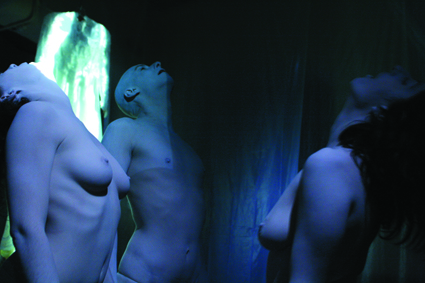
The Oak’s Bride, Red Moon Rising
photo Gareth Hart
The Oak’s Bride, Red Moon Rising
the oak’s bride
Situated near the corner of Bourke and Spencer Streets, The Donkey Wheel Room is a subterranean exemplar of a now disused World War II bomb shelter. The opening sequence of The Oak’s Bride is too familiar, as Butoh inspired representations of eternally rebirthing ghosts are now a performance cliche. But there’s a crafty director’s eye at play here, one that maintains an awareness of architectural space. In a second performance area, a woman adorned in an archaic dress occupies a now spatially charged window. She says nothing, she does not do that much, and what she does do is performed in a slow, meticulous manner. And in spite of a tendency for blockbuster inspired sound designers to neglect the power of silence, this image of a woman electrified by an architrave remains hypnotic. As a gateway into the third performance space and its mythological content, the same woman steps down, draws the audience’s attention toward a distant doorway, and its portent of death as feminine.
It’s a delightful transition, this dissolution of one performance and its blending with another. And it occurs to me that consistent with Next Wave’s “No risk too great” theme, the five shows I’ve seen have been defined, in various ways, by an absence of safe, conventional theatrical structure. Even so, The Oak’s Bride maintains a disciplined approach toward defining its images. On a far wall, several coquettish picture-frames are filled with black and white film, while the performers find solitude in an imbroglio of flesh contained by a huge vent rising upward into the outside world. With the dissolution of form and the disintegration of self there occurs the birth of that which, by definition, is yet to be known. Of the five shows, this ‘body melt’ exemplifies Next Wave’s underlying impulse.
2010 Next Wave Festival: Dangerous Melbourne, creator, performer Paula Van Beek, dramaturg Nicky Fearn, various venues, May 17-27; I thought a musical was being made, creators Jess Oliveri, Hayley Forward, performers The Parachutes for Ladies, cnr Lonsdale & Russell Sts, May 18-23; And Then Something Fell on my Head, choreographer Ashley Dyer, lighting Travis Hodgson, video Rachael Brown, writer, dramaturg Sime Knezevic, programmer Fred Rodrigues, Shed 4, Docklands, May 19-23; A Good Death, creators The Sisters Hayes, lighting Bronwyn Pringle, sound design Angela Grant; St Mary Star of the Sea Church, May 16-23; The Oak’s Bride, creators Ellen Rijs, Jeremy Neideck, Polly Sara, lighting Angela Cole; Donkey Wheel House, May 18-23
RealTime issue #98 Aug-Sept 2010 pg. 40
© Tony Reck; for permission to reproduce apply to realtime@realtimearts.net
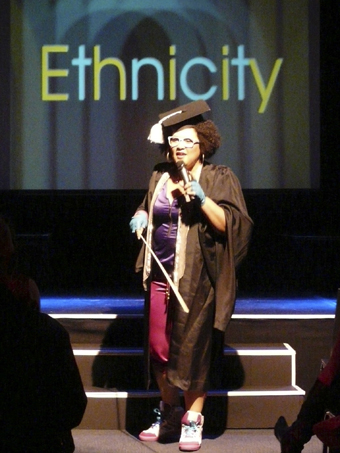
Candy Bowers, Who’s That Chik?, performing at National Multicultural Arts Symposium 2010
photo Andrew Dundon
Candy Bowers, Who’s That Chik?, performing at National Multicultural Arts Symposium 2010
CULTURALLY DIVERSE ART IS INSPIRING, INNOVATIVE AND MARKETABLE—AND IT NEEDS YOUR SUPPORT. THIS WAS THE CLEAR MESSAGE AT A RECENT GATHERING OF CULTURALLY DIVERSE PRACTITIONERS, EACH LEADING CONTEMPORARY ARTS PRACTICE ACROSS A RANGE OF ARTFORMS AND SPECIALISATIONS.
And yet that clear message is not so straightforward: needing your support means overcoming those persistent barriers that have confronted culturally diverse arts for decades. Identity, funding, leadership and the politicisation of its very vocabulary remain ongoing problems. All the while, the work becomes ever more sophisticated, attracts new audiences and tours internationally, joining that increasing array of Australian innovation that enjoys more brilliant accolades overseas than at home—or on our mainstages. So what’s still at issue? And how can cultural diversity lead contemporary Australian arts with widespread recognition?
Held in Adelaide and presented by Nexus Multicultural Arts with Kultour, the National Multicultural Arts Symposium was preceded by two days of performances and exhibitions, with Candy Bowers’ provocative Who’s That Chik? setting the tone (“a hip hop tale of a brown girl with big dreams”; http://whosthatchik.com). Culturally diverse artists framed the symposium, with the work and the practitioners speaking for themselves. This too was questioned at the outset: Who speaks? Who names? Need every artist and every work represent an entire community?
Names and their political appropriation have long confused the Australian community, and frustrated the practitioners whose work they label. Christian (Bong) Ramilo, Executive Director of Darwin Community Arts, saw little progress across two decades of advocating access, equity and representation. For Mirna Heruc, Manager of the Arts & Heritage Collections at the University of Adelaide (and former CEO of Nexus), “Sometimes labels have marginalised us, sometimes they’ve brought us to the centre, but nothing has changed.” Political decisions have seen successive governments adopt—and often, quietly reject—terms such as ethnic, multicultural, Aboriginal, Indigenous, cross-cultural, Community Cultural Development (CCD), disability, all abilities, Culturally and Linguistically Diverse (CALD), Non-English Speaking Background (NESB), diverse, culturally diverse, and even culture itself.
When these shifting terms translate into shifts in policy, culturally diverse practitioners are—like it or not—drawn into their politics, needing to identify with the current language to achieve recognition or secure financial support. For Heruc, the best approach to these names is to reject them entirely; multicultural arts organisations should facilitate pathways into the mainstream, presenting work without any framing label. “Our job is really to get rid of this multiculturalism business, and just focus on the arts.” She adds, however, “We’re not close to achieving this.”
Independent producer Kath Papas, former director of Ausdance Victoria, distinguished between three kinds of diversity that focus her practice: form, content and philosophy. This approach overcomes the fraught cultural labels, opening diversity itself to a space beyond othering. Papas made particular mention of disability arts as informing her practice. “There’s a lack of engagement from the dance mainstream,” she says, and while there’s plenty of talented culturally diverse artists, “who’s going to take them on?” Papas identified flexible infrastructure, networking and skilling up as key issues. Without these essentials, “we lose those artists because they get too tired—you can’t self-produce forever.”
Not all artists make a conscious choice to self-produce, while for others the torch-bearing work of speaking for an entire community is central to the art. Khaled Sabsabi, visual artist and Creative Producer at Casula Powerhouse, saw no distinction between CCD and his own artistic practice. Karl Telfer, Kaurna Cultural Bearer and visual artist, described reconciliation as the driver of all of his work. Such practice is never about aligning itself to funding categories. As Sabsabi put it, “Art leadership is a resistance against the way things are.”
Many speakers lamented the rise and fall of leadership organisations; touring and advocacy body Kultour remains the only national multicultural organisation. Yet all speakers agreed that leadership is about the work itself, and its articulation into the community. Bowers spoke passionately about a new space in which diverse artists see themselves represented in the faces as well as the programming of mainstream arts organisations. “Beyond being ‘championed,’ or ‘helped,’ we want to be paid for being artists. We want the resources, we want the recognition.”
So, how do you position yourself in the culturally diverse arts? Head on. In fact, it’s a proven strategy. Karen Bryant, Associate Director of the Adelaide Festival Centre, presented a powerful argument for diversity as a strategy towards financial sustainability and artistic success. “We’re no longer a series of buildings,” says Bryant, “we’re a facilitator—which means asking, and then re-evaluating.” Direct engagement is essential: programming is developed in close consultation with emerging and established communities. In this way, the Centre overcame its empty seats and its venue-for-hire image. The results are inspiring: a 33% increase in audiences in its first year, and 25% in the second.
Similarly, Adelaide Fringe’s 2011 Director, Greg Clarke, aims at international recognition as a culturally diverse festival by 2020. Clarke sees this as an artistic as well as a commercial strategy for engaging with a majority of Australians. With a strong record in culturally diverse policy as well as programming, Clarke says the Fringe has prioritised diversity quite simply “because it was mind-blowing.”
Communications consultant and editor Fotis Kapetopoulos’ statistics demonstrated just how marketable culturally diverse art is—both at home and overseas. “Our mainstream companies are caught up producing the same styles, but what we’re talking about is international.” Aaron Seeto agrees: “Internationally, diversity is our point of difference.” Seeto, Director of artist-run space Gallery 4A: Centre for Contemporary Asian Art in Sydney’s Chinatown, described the contemporary visual arts museum as “a self-replicating machine, a safe-house,” while contemporary culturally diverse work is “feeding into the international arena.”
Rather than engaging with and supporting this work, our own governments prefer to stick to the known. The major mass-marketing campaign in culturally diverse Victoria is Melbourne Winter Masterpieces, a showcase of well-known European artists from previous centuries. Kapetopoulos described the end of Sydney’s Carnivale as a cynical stroke: it was defunded by the NSW government at its peak demand and sustainability point because its audiences “had started to look too mainstream—it didn’t look like an ethnic festival.” Such ironies were not lost on a gathering of practitioners accustomed to being ‘othered.’
On the other hand, some mainstream arts organisations experiencing significant audience loss have been receiving funding boosts in recent years. Emphasising this particular irony, Opera Australia’s Artistic Director Lyndon Terracini used his morning keynote to ask the funding bodies in the room to “empower” his organisation through a funding increase. Opera Australia currently receives as much Australia Council funding as the other 900+ funded organisations and projects combined. Terracini, founder of Kultour member, Northern Rivers Performing Arts (NORPA) in Lismore NSW, spoke of new Indigenous and Asian initiatives: “I don’t want to play to an elite audience—I’ve never wanted that.”
With all speakers projecting a future Australia of increasing diversity, governments will need to direct subsidies to culturally relevant work that’s artistically exciting as well as economically sustainable. The undeniable reality of Australian multiculturalism as always already mainstream can no longer be avoided; changing labels simply exposes a political reluctance to accept that diversity will not remain ‘othered.’
Fundamentally, such barriers aren’t specific to the arts. They’re generational; they’re administrative; they’re political. Ironically, they’re cultural—in the word’s corporate meaning, describing entrenched practices in establishment organisations. Culturally diverse art is ready to lead contemporary Australian practice, further developing audiences here and overseas.
Candy Bowers knows it. “How can cultural diversity lead the Australian arts?—Get out of my way.”
National Multicultural Arts Symposium 2010, ?Diversity in the Arts: Theory + Action, May?19-21, 2010, presenter Nexus Multicultural Arts in partnership with Kultour
RealTime issue #98 Aug-Sept 2010 pg. 42
© Esther Anatolitis; for permission to reproduce apply to realtime@realtimearts.net
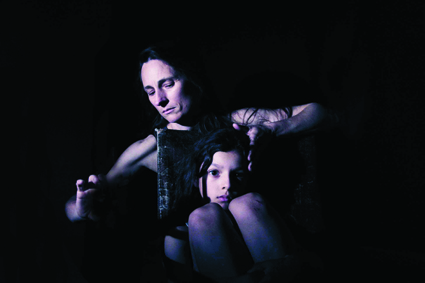
Deborah Kayser, Tomas Tsiavos, Exile
photo Daisy Noyes
Deborah Kayser, Tomas Tsiavos, Exile
“THE CREATIVE PROCESS IS QUITE LIKE OP-SHOPPING,” ARTISTIC DIRECTOR OF CHAMBER MADE OPERA DAVID YOUNG REMARKED TO ME BEFORE THE PREMIERE PERFORMANCE OF HELEN GIFFORD’S OPERA EXILE, “BECAUSE YOU CAN AFFORD TO TAKE RISKS.” AS WITH ALL RISKS THERE ARE STAKES TO BE WON OR LOST IN WHAT IS POSSIBLY THE WORLD’S FIRST OPERA PRODUCED FOR THE IPAD.
Using the familiar op-shopping strategies of combination and alteration, Euripides’ play Iphigenia in Tauris is rewritten, the history of Victoria’s Point Nepean on the Mornington Peninsula is revisited through the lens of gaming technologies and chamber opera is presented on a new platform. The outcomes of the project will not be known until its release and screening at ACMI in November. In the meantime the project’s collaborators from Australian new music organisations Aphids, Chamber Made Opera, Speak Percussion and Amsterdam-based media artists Champagne Valentine will be negotiating multiple priorities and balancing innovation with technical limitation.
Exile has lain dormant since its composition by Gifford as Iphigenia in Exile with the librettist Richard Meredith in 1985. The opera’s recent rediscovery by David Young prompted some closet archaeology by Gifford, uncovering reel-to-reel recordings of a women’s chorus recorded in a Kew apartment in 1986, an autoharp part recorded in 1989 in an old post office and a mandolin through which Gifford attempted to reimagine the timbres of Ancient Greek music. Gifford has not tried to faithfully reconstruct the music of Ancient Greece, but to rediscover it creatively: “People like to think that they can get an idea of Ancient Greek music from decoding carvings and etchings. That’s nonsense. You get more of an idea from listening to modern Greek music of a Demotic order. The timbres, the rhythms; I don’t think those things change so much over 2000 years. Though,” Gifford adds, “my music sounds nothing like Greek music today.” The artefacts were incorporated into the opera’s recent recording at the ABC’s Iwaki Auditorium that will serve for both a radio broadcast and the iPad application’s soundtrack.
The application will also be available for download on iPhone, prompting the question of the iPad’s significance to the work. “They remind me of Speak and Spells,” Aphids Executive Producer Thea Baumann admits, though Anita Fontaine of Champagne Valentine considers the large, higher resolution screen “a nice addition which contributes to the experiences we will create.” With Baumann flagging the “data-heavy layers of moving image” common to Anita Fontaine’s work, there is justifiable concern about the “limited processing power and lack of Flash support” that the iPad inherits from the iPhone. But Fontaine is confident in the project’s ability to overcome these limitations as “these kinds of challenges and constraints are something Champagne Valentine is accustomed to when developing bespoke interactive experiences.”
Rather than processing speed, the iPad’s audio may be the main obstacle to successfully mounting the opera on the platform. The multi-purpose ABC recording will reach Champagne Valentine in the form of a highly compressed stereo mix, making user-controlled manipulation of the composition’s parts, as in the company’s GPS controlled interactive musical game for the Tate Modern, more difficult to implement. Working closely with Champagne Valentine, Baumann anticipates that “one of the main challenges will be to make the audio just as luscious as the video.”
The video component of the work, filmed in consultation with Parks Victoria, engages with the natural environment and rich history of Point Nepean to reflect and comment on the themes of longing, claustrophobia and isolation in Gifford’s opera. Both visually and historically Baumann sees the landscape as “woven with paranoia and isolation,” likening the tone of Exile to the psychologically loaded game spaces of Quake and Half-Life first-person shooters. Baumann hopes to explore this likeness in Fort Nepean’s labyrinthine tunnel system: “The tunnels have a Greek architectural symbolism, simultaneously connoting the Minotaur’s labyrinth and gaming architectures.” By way of visual and aural analogy the southern Australian coastline’s sombre palette, eroded forms and bitter winds provide a desolate backdrop to Gifford’s aural palette, coloured with sparse mandolin, clarinets, clay flute and percussion.
Point Nepean has been the site of Victoria’s main quarantine station 1852–1980, Prime Minister Harold Holt’s disappearance and presumed drowning in 1967 and accommodation for Kosovar refugees in 1999. The area’s legacy of isolation draws Gifford and Meredith’s psychological portrait of Iphigenia into Australia’s grim colonial and immigration history. The protagonist is powerfully realised by soprano Deborah Kayser as she contemplates her effective exile from Greece to the role of high priestess at the temple of Artemis in Tauris (Crimea). Vilified by the townsfolk and wracked by self-loathing, “she feels as though she has been tricked into performing the duties of the high priestess: anointing shipwrecked sailors before sacrifice, or in the case of the high-born, cutting their throats herself,” Gifford explains. Iphigenia is left in her unenviable position after being saved from sacrifice at her father’s hand by the goddess Artemis in Aulis. In Euripides’ play Iphigenia’s brother Orestes is brought to her for sacrifice in Tauris, where they escape with the help of the goddess Athena. Gifford describes the serendipity and divine intervention in Euripides’ play as “cheating,” placing Iphigenia beyond the reach of Ancient Greece’s fickle gods, at the mercy of the Taurians and her memories. “Euripides’ play is a bit like a soap opera,” Gifford laughs, “he had to have a happy ending. But there were thousands of temples in the area, and those that did have human sacrifices needed priests and priestesses.” Drawn by the mournful song of a migrating seabird from her homeland (rendered on clay flute), Iphigenia walks on, or into, the ocean at the opera’s conclusion. “Whereas the poor soul fantasises walking with Orestes over the water, she is really, I think we can agree, walking under it.”
Exile shows us a world of Ancient Greek myth without gods. The secularised portrait of Iphigenia is made profoundly sympathetic at the expense of its dramatic context, turning Euripides’ melodrama into a personal tragedy. The composition should be given a renewed and poignant context in Point Nepean, where history may come into a creative synthesis with the possibilities of computer game narratives and technologies. The opera’s successful implementation on iPad, as on its other intended platforms, hinges largely upon Aphids and Champagne Valentine turning the opera’s recording from ABC’s Iwaki Auditorium and video component into an engaging interactive music video.
Exile, composer Helen Gifford, soprano Deborah Kayser, co-producers Aphids, Chamber Made Opera; studio recording, Iwaki Auditorium, ABC Southbank Centre, Melbourne, June 22
RealTime issue #98 Aug-Sept 2010 pg. 43
© Matthew Lorenzon; for permission to reproduce apply to realtime@realtimearts.net
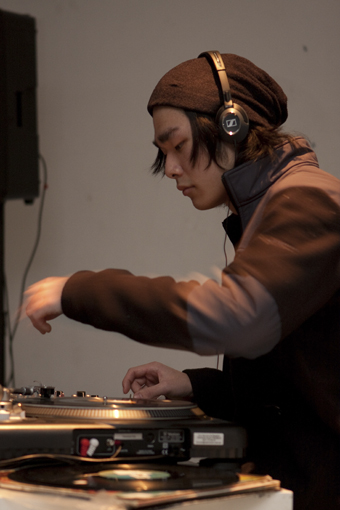
Jordan Dorjee performing at Refraction June 29, 2010 (co-curated with New Weird Australia)
photo Marnie Vaughn – see image note*
Jordan Dorjee performing at Refraction June 29, 2010 (co-curated with New Weird Australia)
THERE IS A RICH HISTORY IN AUSTRALIA OF VIBRANT AND GROUNDBREAKING HIGHER EDUCATION PROGRAMS THAT OFFER AN ALTERNATIVE TO THE MORE TRADITIONAL CONSERVATOIRE EDUCATION FOR YOUNG ARTISTS AND MUSICIANS. EXAMPLES INCLUDE THE LATROBE UNIVERSITY MUSIC PROGRAM THAT STARTED IN THE 1970S, THE FORMER DEGREE IN MUSIC AND ELECTRONIC ARTS AT THE UNIVERSITY OF WESTERN SYDNEY, CURRENT PROGRAMS SUCH AS RMIT AND QUT’S CREATIVE INDUSTRIES, WAAPA’S BACHELOR OF MUSIC TECHNOLOGY AND THE NEW UTS BACHELOR OF SOUND AND MUSIC DESIGN. OVER THE YEARS JULIAN KNOWLES (QUT) HAS BEEN INVOLVED WITH A NUMBER OF THESE UNIVERSITIES AND ARGUES THAT “THESE PROGRAMS HAVE BEEN CRITICAL TO BUILDING THE CULTURE AROUND EXPERIMENTAL MUSIC IN AUSTRALIA FOR 30-40 YEARS” BECAUSE THEY HAVE TRAINED PRACTITIONERS AND DEVELOPED NEW AUDIENCES.
Knowles explains that “those of us teaching in university programs in the 1990s were very active as practitioners in the scene and we brought students into contact with the network of festivals such as What is Music? and Liquid Architecture and the warehouse gigs that were happening in the more underground artist run spaces..[and we] brought practitioners from this scene back into the university by offering casual teaching appointments.” Indeed, it seems that the most successful educational programs in Australia have always involved engagement with the wider community, a feature of the La Trobe Music course, UWS and most recently RMIT. Articulating perfectly such an approach, which seems relatively common in Australia, Philip Samartzis (RMIT) claims that “the role of an institution is to facilitate opportunity and development by introducing students to an expansive range of ideas and practices that afford a greater appreciation of sound culture.”
Despite their success and involvement with the wider experimental music and sonic arts community in Australia such programs are often regarded as expensive and relatively niche and so have frequently been at risk. Knowles explains that “the 1970s was particularly active. There was some fallback in the late 80s and early 90s, then a significant increase in offerings from the mid 1990s onwards.” Still it is only a few years ago that the widely admired UWS Electronic Arts program was shut down and academics and students alike know they can’t be complacent about the future. Cat Hope (WAAPA) says that “there is not a good feeling amongst academics in Australia” because, while the area is vibrant and active within universities, constant instability and demanding teaching loads have the potential to effect the quality of the teaching offered.
Apart from concern about the future, issues currently of interest in experimental music and sound art include the increasing numbers of artists and musicians taking up PhD and DCA places, the focus of students on career pathways and the centrality of research to university funding models and activities.
paperwork
It is widely speculated that there has been an increasing number of artists and musicians taking up PhD and DCA places in the last few years but it is unclear what effect it will have on the development of experimental music and sonic art culture in Australia. Kirsty Beilharz (UTS) comments that “there has definitely been an increase in composers pursuing higher degrees which may be due to various conditions, such as the almost requisite PhD for academic employment, and returning to studies in the current economic climate, but also positive factors such as the increasing recognition and understanding of creative practice as research or as being significantly rounded by research.” Analysing this trend, Cat Hope thinks that the increase in PhD and DCA study among artists and musicians “will result in better articulation of artists’ ideas since some sort of record of arts practice has been absent from the experimental music scene for over 30 years.” She argues that “perhaps experimental music has more academic credentials now than before.”
exploration & employment
Despite the increase in numbers taking up research places, students on the whole seem to have an increasing focus on career pathways. Philip Samartzis believes “that institutions are now so invested in postgraduate research, students are generally thinking beyond their undergraduate program in order to develop strategies that will assist them upon graduation…For some this may lead to further education, but for many the ultimate goal is to practise as an independent artist.” Consequently, “it is incumbent upon program leaders and lecturers to ensure that students are provided with as much workplace integrated learning as possible so that students establish and grow their practice whilst at the institution.” Addressing this issue, Julian Knowles suggests that while it is clear that students have become more focused on their career pathways in the last 10-15 years, a really good program can meet such needs as well as satisfy students more interested in exploration. He says that he struggles with the ‘nostalgic’ notion of ‘the liberal arts education as an end in itself.’ “Being interested in the experimental arts does not mean that a student has no desire to work in a relevant field and it does not mean that academics can ignore or absolve themselves of the responsibility to help people establish viable practices.” Instead he claims it has been his experience that “many graduates from these programs have developed production skills in audio which have served them very well from an employment perspective.”
the research economy
Perhaps the most notable shift in tertiary education in Australia in recent years has been the increased emphasis on research in universities. The Federal Government has made a significant amount of funding dependent on each university’s research output. Understandably this has increased the focus of the institutions on research but beyond that it has made the issue of defining just what counts as research more crucial than ever and this is a problem for experimental music and the sonic arts in universities. Knowles explains that “the real issue is that the research assessment process does not easily recognise the sites for output or activity in the experimental music scene” because “major sites for experimental music research and output—artist-run spaces—are not considered ‘serious’ in the national assessment process, despite the fact that they host top national and international practitioners.” But he believes that, fundamentally, “there are fairly marked cultural and ideological differences between the most underground experimental musics and the institutionalised research economy.”
Samartzis feels that “the emphasis on research however has somewhat devalued undergraduate learning and teaching as more resources are directed to the post-graduate sector.” However, while he believes that “the undergraduate sector provides the biggest contribution towards the general development and wellbeing of sound culture, postgraduate research does offer the artist an opportunity to develop intellectual rigour whilst investigating rarefied areas of knowledge and practice.” Significantly, he points out that “the institutional model of research often results in an invaluable contribution to the field but it is no more important than less formal modes of practice and research generated by independent artists with no institutional affiliation.”
The focus on research that dominates the tertiary sector, the increased number of artists studying towards PhDs and the increased vocational focus of students, raises important questions for experimental music and the sonic arts. How can universities maintain strong undergraduate programs while increasing their research output? How can they develop programs that encourage students to be exploratory and still offer strong career opportunities? What effect will an increased number of research students have on the experimental music and sonic arts community in Australia?
In the meantime there is undoubtedly a great deal of activity in the tertiary education sector, reflecting the strength of the field in Australia. Indeed the most successful experimental music and sonic arts programs in Australia’s universities appear to be those that generate and facilitate activity in the wider community while meeting the needs of students and supporting the work of staff. Although a number of highly regarded experimental music and sonic arts programs have been shut down over the years there are still a significant number of respected courses on offer in this country, such as those at RMIT, QUT and WAAPA, and the launch this year of a new program at UTS demonstrates that even in the current climate of economic rationalisation such programs can not only survive but thrive.
*Image note: Jordan Dorjee is a BA student in Sound and Music Design at UTS. Refraction is a semi regular media art, music and sound event run by the UTS Sound collective “dedicated to the support, mentorship and development of student projects as they take their practice from the classroom to the community.” (Emily McDaniels, Refraction coordinator)
RealTime issue #98 Aug-Sept 2010 pg. 44
© Ben Byrne; for permission to reproduce apply to realtime@realtimearts.net
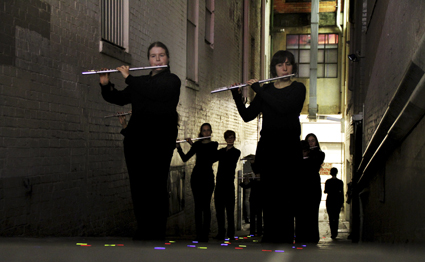
Super Critical Mass – Sub Mass 4, Burnett Lane
photo Lawrence English
Super Critical Mass – Sub Mass 4, Burnett Lane
BRISBANE’S ALBERT STREET MALL CUTS BURNETT LANE INTO A LONG END AND A SHORT END. THE SHORT END OF BURNETT LANE SLOPES DOWN BETWEEN A 7-ELEVEN AND A DUTY FREE, TO FINISH AT A CARPARK. THIS IS THE PUBLIC SPACE FOR SUB MASS 4, PART OF LIQUID ARCHITECTURE II—BUT IT’S BEEN PRIVATISED FOR THE NIGHT WITH A SEMI-CIRCLE OF SMALL BATTERY-POWERED FOOTLIGHTS PLACED AROUND THE ENTRANCE AND A COUPLE OF OH&S WITCHES’ HATS EITHER SIDE IN CASE PEOPLE DON’T REALISE THE DANGER FLAUTISTS PRESENT.
There’s a goodly crowd clustering around, waiting for the start. Four flautists emerge from the left hand side of a building at the bottom and start to walk slowly up the lane toward the crowd. They’re playing a soft drone and, as they move up the alley toward us, another group of four emerge from below, then another and another, until the alley is filled. When a row reaches the top they stop, turn, and walk down to the bottom to begin again. It’s a stately processional conveyor belt of flautists, pitch rising as they get closer and closer to the audience. Over 30 minutes the drone slowly breaks down to puffed bursts, then to a swinging gate effect as the pitches move from one group to another—a swinging sync that peters out, gets a pulse, peters out again.
It’s a beautiful piece, but there’s a problem. Late night shopping and the onset of dusk sees the Brisbane Mall a lively place. Seated on a platform, not a few steps away, a terribly sad woman strums an acoustic guitar and sings a dismal song about how one is often unaware of the value of what one has until it is gone. Further up the mall a retailer shares their enjoyment of jug band music with the public at large. So you can barely hear the performance. And you can’t see much of it either because of the narrow alley and the people clustered around trying to get best pozzie for whatever it is that everyone else is struggling to get best pozzie on.
The publicity blurb goes “As a listener you are invited to walk through the space or simply sit within the evolving sound-fields…This performance event, Sub Mass 4, draws you into the depths of Burnett Lane…” But it doesn’t and that’s a shame because if we had been allowed into the alley way and the space of the performers Sub Mass 4 would have been a great experience. On the other hand that’s fine because Sub Mass 4 is part of an exploratory/experimental program by the composers and the next night they perform the same piece in a very different setting where the audience and performers intermingled (which I missed, but apparently it worked a treat). I love this investigative approach to working—it seems a great addition to the take-it-or-leave-it model of art production as ‘revelation.’
Across the mall and down to the long end of Burnett Lane, runs Insitu: Sonore, sound installations for a few weeks in June, another Liquid Architecture 11 work. The long end is filled with trucks, bins, the arse end of shops selling Vietnamese koalas and plastic rulers covered with photos of Great Barrier Reef attractions or inset with the seven timbers of Australia.
And somewhere amongst all this is the sound of Janek Schaefer’s National Portrait. (Schaefer is the person who posted a voice activated dictaphone around Britain, picking up the stray utterances of various mail handlers.) I wander up the lane. I wander down, I wander up and down again. I hear the trucks, the air-conditioning ducts. It’s a great sounding lane. But no Schaefer. I ask upstairs at a newish art/design collective (Glow32) and they point to a little box above an awning. I go down and hang around trying to invoke the cocktail party effect that lets you hear your name whispered from the other side of a crowded room. Primed for Schaefer, primed for Schaefer—nup, nothing, a faint hint of a conversation maybe, then more nothing. This installation is way too quiet. Undeterred (well, a tad deterred) I come back a couple more times for more of the same.
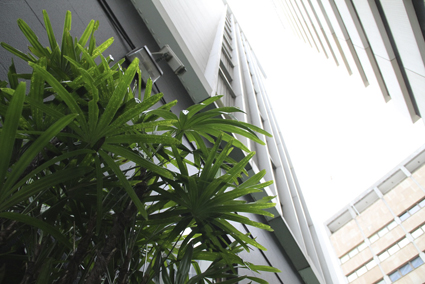
Inhabit Fiesta: Urban Jungle, Eagle Lane
photo Lawrence English
Inhabit Fiesta: Urban Jungle, Eagle Lane
Ah well, off to another lane for another sound installation, Urban Jungle, part of the Inhabit Fiesta Festival, where works by Chris Watson, Lawrence English and James Webb are up for the next few weeks. This is more the Brisbane I know, modern high rise, no street life at all. At one end the lane pokes between two buildings to make a smallish aperture onto the rest of the city. This bit is closed off to cars, and Lawrence English has arranged a small, slightly tacky, setup of fake grass on the ground, shrubs potted and plopped along the sides. Looks like a temporary beer garden. The wind shoots through the space, rustling the leaves—suitably ear-height through the choice of shrub. The movement of leaves as a signal of changes in the air. A pleasure of sound at multiple scales. A message from another, biological, world. Contrast with the usual background city rumble: acquired deafness, slightly elevated blood pressure.
At the other end of the lane there’s a building on the right with grilled-over holes cut into the first floor. The entire building surface is articulated with bursts of white noise. It’s like being in a forest when bell-birds sing out and you hear space activated through sound. This time it is the reflective surface of a building, flat and high up, whose distance and shape is perfectly realised through the time it takes for sound to reach the ear. I can’t remember enjoying a public sound work more, but no sign saying whose work it is. Because it isn’t anyone’s—this is just how the space sounds without any intervention at all. What a find—whilst listening for soundworks I’ve been taking a soundwalk instead.
Liquid Architecture 11, artistic director Nat Bates, Brisbane curator Lawrence English; Sub Mass 4, Julian Day, Luke Jaaniste, Janet McKay, June 25; Insitu: Sonore, Janek Schaefer, Leighton Craig, DJ Olive, Brisbane, June 11-27
Inhabit Fiesta: Urban Jungle, Lawrence English, Chris Watson, James Webb, Brisbane June 11-27
RealTime issue #98 Aug-Sept 2010 pg. 46
© Greg Hooper; for permission to reproduce apply to realtime@realtimearts.net
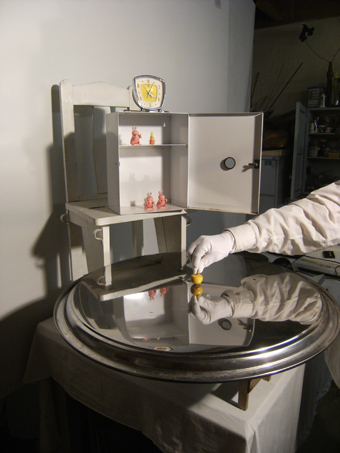
Tin Rabbit’s Life Chance, Ros Bandt, part of Constellation: A Durational Chamber Work
photo Ros Bandt
Tin Rabbit’s Life Chance, Ros Bandt, part of Constellation: A Durational Chamber Work
TWO EVENTS AT THIS YEAR’S LIQUID ARCHITECTURE SUGGEST THAT THE FESTIVAL IS MOVING IN A NEW DIRECTION. A CENTRAL THEME IN BOTH CONSTELLATION: A DURATION CHAMBER WORK AND CONCERT II WAS THE RELATIONSHIP BETWEEN SOUND ART AND PERFORMANCE, EITHER AS RADICALLY DISCRETE OR THEATRICALLY INTEGRATED.
Concert II was held at the 3RRR performance space, a new venue for Liquid Architecture. The studio is a Melbourne institution and an important platform for non-mainstream music and culture. In this concert, duo Lionel Marchetti (France) and Yoko Higashi (Japan) integrated sound art and performance in a most striking way. Producing various forms of feedback, covering extremities in volume and high and low frequencies, musique concrète composer Marchetti sustained an intense atmosphere.
In white body paint and wearing a kimono, Yoko Higashi accompanied Marchetti, performing Butoh inspired movement. Her dark demeanor and contorted gestures provided a backdrop to the centrally located Marchetti. These different modes of performance gradually became literally entangled as Higashi climbed onto the shoulders of Marchetti, who continued unperturbed as his role in the dramaturgy of the performance shifted.
Higashi also crossed over into the realm of sound art, picking up a microphone and speaking softly into it. Twirled around, it thumped loudly as it banged against her body. This wild and almost dangerous gesture complemented the dramatic and violent energy of the music beautifully. Overall, the theatricality and musical content of this performance worked together well to create a thrilling atmosphere.
Opening the program with a far more understated approach, Perth based ensemble Decibel performed three works by Alvin Lucier. Each of these explores the sonic possibilities created by sine tones as they come into physical contact with objects or sounds in space (see also RT97).
Performed by flautist and ensemble director Cat Hope, Still and Moving Lines of Silence in Families of Hyperbolas requires the performer to play a series of sustained notes, moving in microtonal increments. In this extremely stark work the imperfections of the flute were exposed against the purity of two sine tones. However the essence of this piece is the way these frequencies clash in the space to cause ‘beating’ patterns. This created rich sonorities in the dry acoustic of 3RRR’s performance space.
The next work, Music for Snare Drum, Pure Wave Oscillator and One or More Reflective Surfaces, was an exercise in sympathetic resonance. As a sine tone gradually descended in pitch, the snares of a drum and the resonant frequency of the drum itself, were made to sound, causing a further range of sound complexes to occur and interact.
As in the opening work, in Lindsay Vickery’s performance of In Memoriam Jon Higgins a series of sustained tones on the clarinet were exposed against the comparative purity of the sine tone. The effect was accentuated further by what sounded like a small amount of spittle in Vickery’s throat or the mouthpiece.
The extreme starkness of these pieces invited a contemplative mode of listening. None evolved beyond very limited parameters, which were revealed in their entirety in the first few moments. Rather than articulating events over time, Lucier invites the audience to bear witness to acoustic phenomena. This was reflected in Decibel’s equally stark performance mode, in which the dramaturgy was inherent in the sounds themselves rather than the performers’ actions.
Following the restrictive conceptual scores of Lucier was a far more visceral and spontaneous approach to performance. 12 Dog Cycle, comprising Alice Hui-Sheng (Taiwan) and Nigel Brown (Australia), gave what felt to be a largely improvised performance. Using a piano accordion and effects processing to produce a texture of drones, Brown essentially provided a vehicle and framework for Hui-Sheng’s vocal performance. Hui-Sheng demonstrated a remarkable repertoire of extended techniques, moving between moments of intricate, breathy subtlety, to almost grating loud tremolos and shrieks.
A restrained approach to materials enabled this duo to build to passages of convincing intensity. In a performance which meticulously took its time to develop, these moments held the greatest impact.
Another event on Liquid Architecture’s program exploring an intersection between sound art and performance was Constellation: A Durational Chamber Work. Curated by Madeleine Flynn and Tim Humphrey, this exhibition explored the notion of a musical work outside the confines of performance. Eleven composers were invited to submit works based on the theme of the Zodiac. The title refers not only to the Zodiac, but also to the way the eleven works co-existed in an interconnected web.
Empty seats and music stands were arranged around the gallery space, mostly in pairs upon small podiums. Each seat represented a composer and members of the audience were invited to sit, triggering a recording of the composer’s work. Accompanying each piece was an artifact. In many cases this was a notated score, however this was not necessarily the rule. Videos, installations and instruments were also used to create a physical presence for the musical work. Not only an exhibition, this event also featured daily performance “interruptions” in which all the works were heard.
One of the strengths of this exhibition is its representation of diverse composition practices. Ros Bandt’s Tin Rabbit’s Life Chance is a strikingly original work, blurring the line between artifact and performance. In this interactive sound installation the participant is instructed to put on white gloves and spin a top on a large metal plate. These actions are part of a small ritual, culminating in a back-flipping contest between three wind-up toy rabbits.
Rat Tea Ceremony by Anita Hustas is an improvised musical work with a theatrical framework. Musicians are invited to partake in a tea ceremony with fortune cookies. The message within the cookie is used as a catalyst for improvisation, providing a clear indication of how the piece will unfold dramatically, however they also reveal that the musical content is extremely variable. There is a recording of this work as part of the exhibition, however as the piece is to be performed by two, six or 10 players on any instrument they wish, this is only one rendition of a work that may take on vastly different guises.
Carolyn Connors’ work, RatOxTigerRabbitDragonSnakeHorseGoatMonkeyRoosterDogPig, also offers a framework for improvisation, in this case for two-12 performers. However, rather than being concerned with the creation of a theatrical setting, the signs of the Zodiac are used as a starting point for improvisation. Robin Fox’s Melanoma Study # 1, a framework for improvisation for EWI (electronic wind instrument) and any keyboard instrument, features a Max/MSP patch for the EWI and pitch modules to be performed on the keyboard instrument. In each of these works, it is interesting for the audience to become acquainted with aspects of the work that would normally only be revealed to the performer.
David Young’s Esaurita (Breakdown) also has aspects which are left to the performer’s discretion, however there is far greater detail in the work’s structure, an original form of notation using an old constellation map. Moving vertical lines on a video score indicate when performers are to play. Composed for flugelhorn and “slightly” prepared piano, the notation does not indicate exact pitch, however it does indicate the rhythmic placement of notes with even greater precision than traditional notation, making this work an extremely successful exercise in control and indeterminacy.
Although the works in Constellation were performed from time to time, aptly as “interruptions,” the exhibition successfully presented its commissioned compositions as artifacts which were encountered by the audience outside of the usual performance context.
Liquid Architecture 11, artistic director Nat Bates; Concert II, 3RRR, July 2; Constellation, a durational chamber work, curators Madeleine Flynn, Tim Humphrey; Red Gallery, Melbourne, July 1-17
RealTime issue #98 Aug-Sept 2010 pg. 47
© Simon Charles; for permission to reproduce apply to realtime@realtimearts.net
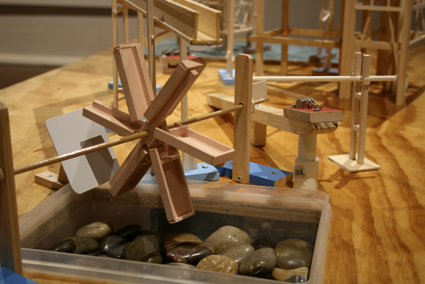
END (Ice Cold Drinks) detail of installation, Andrew Varano
see image note*
END (Ice Cold Drinks) detail of installation, Andrew Varano
BEING AN ARTIST DOES NOT REQUIRE ANY PARTICULAR QUALIFICATION. UNLIKE ACCOUNTING, LAW, MEDICINE OR ARCHITECTURE, WHICH REQUIRE SPECIFIC TRAINING, QUALIFICATIONS AND ACCREDITATION, TO BECOME AN ARTIST YOU JUST HAVE TO ESTABLISH A PRACTICE. BUT AS A RESULT OF THIS, ONE OF THE DIFFICULTIES ARTISTS FACE—PARTICULARLY EMERGING ARTISTS—IS THAT THEIR STATUS AS PROFESSIONALS IS OFTEN SOMEWHAT UNCLEAR. OVER THE LAST DECADE IN AUSTRALIA, THE NUANCES OF OPERATING AS A PROFESSIONAL ARTIST—RATHER THAN AN AMATEUR, OR HOBBYIST—HAVE BEEN THE SUBJECT OF QUITE A BIT OF DISCUSSION, NOT LEAST IN RELATION TO THE WAY THE AUSTRALIAN TAX OFFICE AND SOCIAL SECURITY AGENCIES DEAL WITH PRACTITIONERS IN THE SECTOR.
artstart: qualifications required
While the Labor Government’s ArtStart policy was originally oriented towards dealing with some of these issues, in its final form it has become little more than another funding program managed by the Australia Council aimed at providing start-up support for artists. In fact, far from seeking to resolve the issue of how an emerging artist might establish their professional status, the program has fallen back on a very simple test—the key eligibility criteria is that the applicant is a recent graduate from an appropriate educational institution. While this might seem to focus the grant program on emerging artists, the removal of the initially proposed age limit sees ArtStart grants being awarded not only to young undergraduates, but also to older artists who have recently completed PhDs, some of whom may well have been exhibiting for a couple of decades. While I may be wrong, I think this makes ArtStart the only Australia Council grant program that requires an artist to hold formal qualifications. It’s an interesting move, particularly in the light of debates in and around the contemporary art school.
rethinking art school history
In this context two of the key threads of debate revolve around the way the creative activities of artist academics are valued as research within the university context, and the gradual shift towards the PhD as the terminal degree in the visual arts. Rethinking the Contemporary Art School: The Artist, The PhD, and the Academy, edited by Brad Buckley and John Conomos, is one of a number of recent collections of essays to enter into the debate around this territory. While it is a book that is very clearly international in approach—it’s published by the Press of the Nova Scotia College of Art and Design and includes contributions which focus on the Art School in North America and Europe, as well as Australia—the tone set by the editors seems very much derived from their Australian context (both are senior artist academics at Sydney College of the Arts).
Certainly, their introduction to the collection is framed by the complex changes to the Australian higher education sector over the past two decades, and the awkward place of Australian art schools within that context. It’s a pity that Buckley and Conomos don’t begin their account of the Australian art college system a little earlier than they do as this would have allowed a more nuanced picture of just where ‘art colleges’ were located—from those that stood alone and those that were already within universities to those attached to Colleges of Advanced Education, Institutes of Technology and even the TAFE system. Instead, by starting their account with the Dawkins reforms of 1990, they suggest that many of the problems of today’s Australian art colleges are the result of the ‘shotgun weddings’ that saw many colleges forced into amalgamations with the existing research universities. As they note, “until then, colleges which granted degrees did not have a research culture as such,” with the art work that was produced by teaching staff being referred to as “professional practice.”
In the wake of the shift of the art colleges into the university system, artist academics found it increasingly necessary to recast their ‘professional practice’ in terms of the research paradigms operating within the new context. It was often a very difficult fit, with the issue made all the more challenging by the imposition of more limited frameworks for what ‘counts’ as research across the sector as a whole, as well as the linking of funding to research outcomes. Significantly, the development of research based higher degrees within the field—particularly the PhD—has also produced some tensions with existing paradigms. But what Buckley and Conomos don’t deal with clearly is what we might see as the ‘two speed economy’ of contemporary art, that tension between art as ‘academic research’ and art as it operates out there in the art world. Perhaps they don’t see a difference between the two.
a qualification too far?
For Buckley and Conomos, the university system is not only subject to criticism because of the inflexibility of its traditional paradigms and values, but also because of the way it has shifted away from these towards an “increasing emphasis on training rather than education (the latter as represented by critical debate, discussion, difference and nuance).” In other words, the university system is both too traditional and inflexible, and at the same time has become too instrumental, too focused on vocational outcomes, rather than open critical inquiry. But if the amalgamations forced by the Dawkins reforms had not happened we might well still have a split system, with the art colleges most often aligned (as they once were) with the ‘training’ side. In light of this, it is a pity that no mention at all is made of the direction art education has taken within the TAFE system, where certificates and diplomas continue to be cast explicitly in vocational terms. There is of course an interesting tension for artists who teach in both systems. In TAFE a teacher now needs a certificate IV in training and assessment, while to teach in a university, the key qualification is the PhD.
If these remarks give the impression that Rethinking the Contemporary Arts School has an overall argument, it needs to be made clear that this is not the case. It is, rather, a set of diverse pieces gathered around a very broad thematic. And the approach is very varied, from Edward Colless’ virtuoso piece on the ‘trick’ of teaching, to chapters that focus on case studies around the approach of particular institutions, such as those by Mikkel Bogh (the Royal Danish Academy of Fine Arts) or Juli Carson and Bruce Yonemoto (the Studio Art Department of the University of California, Irvine). Other contributors include Bill Seaman, Gary Pearson, Sara Diamond, Su Baker and Lauren Ewing.
art school as intersection
One strong thread through the book is the impact of ‘new media’ and the internet on how art is developing, and how contemporary art students think and work. This, and other factors, have impacted on the shape of the visual arts as a discipline specific activity. As Su Baker puts it: “contemporary art may no longer be a discipline in itself but rather a place where disciplines intersect and interact.” Amongst the contributors to this book there is a general consensus that art education needs to become more interdisciplinary, perhaps even more undisciplined. As Lauren Ewing argues, “art students should be able to browse the curriculum and take courses they qualify for anywhere in the curriculum.” But significantly, what her examples demonstrate is that the art school of the future may need to be part of a larger institution, a node within an academic network, rather than a stand alone institution.
Where does this leave the ‘traditional discipline’ skills and knowledge that once provided the backbone of an art education? Might they be in danger of slipping away, along with the particular things art students might learn from them? Putting what he describes as an “unfashionable position,” Gary Pearson, for example, argues “that art history and production skills training, both increasingly marginalised in today’s curricula, remain important pedagogical fields, but they do require continual revision and upgrading in content and mode of delivery.”
looking for professional practice
But perhaps there are also new areas to be consolidated and developed. While a lot is said in this collection about the educational value of student interaction with practising artists, there is little comment on the concrete demand for what is these days usually termed the ‘professional practice’ course. Often seen as something of a side issue, and relatively neglected, it is the perceived lack of attention to this area that seems to underpin the focus of the ArtStart grant program. In light of this it seemed ironic that as I read this book, Sydney College of the Arts was advertising a newly created position of Lecturer in “Visual Art Practice.” The appointee’s responsibilities are to be focused on developing curriculum at both undergraduate and postgraduate levels, “to provide student artists with the relevant and necessary professional and entrepreneurial skills to achieve their personal career goals and an understanding of the elements of contemporary art curatorship.”
While it might be possible to think of this as just another slip down the slope of vocational training, my reading of the essays in Rethinking the Contemporary Art School suggests otherwise. For in the increasingly ‘undisciplined’ context of visual art education, it is within the context of ‘professional practice’ that the institutionally embedded nature of contemporary art is brought into sharp focus, with an essential intersection of both ‘research’ and the market.
Rethinking the Contemporary Art School: The Artist, the PhD and the Academy, edited by Brad Buckley and John Conomos, The Press of the Nova Scotia College of Art and Design. ISBN: 978-0-919616-49-3
*Image note: Andrew Varano is a graduate of Curtin University. This work won him the inaugural Dr Harold Schenberg Art Prize ($20,000) presented at the opening of HATCHED National Graduate Show, PICA, Perth April 16.
The judges said of their choice: “This work stood out as being distinctive and innovative with conceptual rigour and a refined use of visual, aural and kinetic languages.” PICA Press Release.
RealTime issue #98 Aug-Sept 2010 pg. 48
© Peter Anderson; for permission to reproduce apply to realtime@realtimearts.net
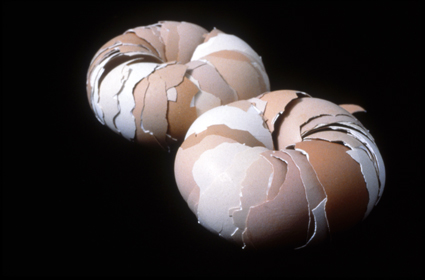
Bronia Iwanczak, Defence Rhythm, 1997
courtesy the artist
Bronia Iwanczak, Defence Rhythm, 1997
PLAIN SPEAKING RENEGADE ART CRITIC DAVE HICKEY TAGS IT “THE INVISIBLE DRAGON.” IT’S BEEN DEEMED “UNCONTROLLABLE” WHILE OTHERS HAVE WRITTEN OF ITS “MISADVENTURES.” PICK PHILOSOPHER ARTHUR C. DANTO’S BRAIN AND HE WILL TELL YOU ALL ABOUT ITS “ABUSE.” BEAUTY, AS MUCH AS IT PURPORTEDLY REMAINS A TABOO IN TODAY’S ART WORLD, HAS CERTAINLY HAD SOME IMPASSIONED WORDS PENNED IN ITS DEFENCE IN THE PAST TWO DECADES.
Conceptual Beauty: Perspectives on Australian Contemporary Art, a new book by Sydney visual arts scholar and writer Jacqueline Millner, doesn’t take to this debate with guns blazing. Rather, from the perspective of an attentive, perceptive and thoughtful critic who has observed the breadth of Australian art practice on the ground for the past decade and a half, there emerge some telling observations on the state of beauty in Australian art. Firstly, Millner identifies a substantial body of Australian artists making visually compelling artworks that challenge audiences to consider complex ideas, often of a political or socially engaged nature. Unlike their anti-aesthetic contemporaries, these artists care deeply about materials, craft and formal qualities. And, as it happens, many of them are women, some relegated to the margins of the local canon.
For these findings alone, Conceptual Beauty is a worthy addition to the critical landscape. Yet the book serves another function, too. A collection of previously published essays and articles (some from RealTime) spanning the mid-90s to the near present, the book offers insight into many of the driving concerns of recent contemporary art as well as a window into Jacqueline Millner’s development as an arts writer. As such, the author has not confined herself to the subject of beauty and, reflecting her diverse interests, the book is organised around the broad themes of nature, space(s), body relations, politics, history and, lastly, beauty. Yet even when the author is not directly dealing with this subject, much of her writing embodies a revisionist impulse that acknowledges the critical power of aesthetics.
Take her choice of cover image which offers a good clue to the type of beauty to which Millner is drawn. An installation detail from Bronia Iwanczak’s Defence Rhythm (1997), it shows two embryonic slug-like forms fashioned from fractured eggshells packed ever so delicately and self-entwining, giving rise to a tension between strength and frailty. There is charm and visual allure to be found in the artist’s resourcefulness, in her artisan-like attention to her materials and in her meticulous arrangement of these brittle cast-offs into patterns of soft tonal gradation from dark to light. They are indeed beautiful, in an unconventional way. Yet, Millner suggests, they speak also of the larger cultural climate of late modernity where “life continues, albeit in corrupted, hybrid forms, forged out of expediency from whatever is at hand.”
While Defence Rhythm is placed in the chapter on history, Iwanczak’s creations would also be at home in the primary essay in which Millner contextualises her main argument; “Conceptual Beauty: Aesthetics and recent Australian contemporary art.” Focusing on the practices of Fiona Hall, Tracey Moffatt and Rosemary Laing, Millner formulates “conceptual beauty” as describing “an artwork’s integration of intense attention, pleasure, and communication in a way that can bring about a momentary decentring of self in the viewer and evoke a ‘wealth of thought-emotion’ capable of creating the materials with which to construct new concepts and the socio-political arrangements that would correspond to them.”
The types of “thought-emotion” that artworks exhibiting conceptual beauty can give way to appear vary in Millner’s inventory. Robyn Stacey’s wondrous large-scale photographs of moth, insect and animal specimens normally hidden away in natural history collections, for example, provoke consideration of the interdependence between science and the visual in systems of taxonomy. Equally seductive are the super slick techno-human sculptural hybrids of Patricia Piccinini, underscored by ethical concerns over the manipulation of nature in the digital age. While the visceral delight to be enjoyed in the sensual and gloriously thick lashings of paint on Ben Quilty’s canvases form the material of a playful yet multi-faceted enquiry into the negotiation of masculine identity in Australian culture.
As noted, there is undoubtedly an emphasis on the practice of female artists at play here, and while male artists such as Mike Parr, Adam Geczy, David Noonan, Christopher Dean, Jonathan Jones and William Seeto are included, Millner is unapologetic about the gender imbalance. This stems partially from the author’s long running interest in feminist theory and art practice, as well as a natural attraction to the “strength of ideas” she finds in the work of Australian female artists. It would be unnecessarily heavy-handed to insist on equal representation of male and female artists, but given the long entrenched association of women with such areas as beauty, nature and the body, it is possible the inclusion of just a few more male artists who consciously employ the trope of beauty would have been effective in further challenging stereotypes.
The two-fold aim of the book to offer a snapshot of Australian practice from the mid-90s to now, whilst also putting forward an argument for the term “conceptual beauty” does pose structural challenges, too. For the most part these are skillfully handled but for one perplexing choice, the placement of the extended essay on Conceptual Beauty, the raison d’être for the book’s title, toward the end of the book. Perhaps this represents a gesture of humility on the author’s part, not wanting to impose an umbrella type theory over the entire volume especially when it doesn’t apply to every essay, leaving readings more open. Yet having skipped forward to this section, craving a deeper explication of Millner’s term, subsequent readings of preceding chapters did seem enriched.
Such phrases as ‘beauty is in the eye of the beholder’ tend to become clichés because they contain a distillation of truth. The strength of Millner’s contribution lies in her capacity to enact a journey into the mind of the ‘beholder’ with her thorough, and frequently elegant, assessments of the psychological processes that cleverly crafted objects can engender. Writing from a position of empathy, rather than provocation, Millner practices what she preaches by handling artists’ work with care. In this way, Conceptual Beauty speaks of a fairer critical benchmark where ideas and aesthetics may, at last, be equally weighted.
Conceptual Beauty: Perspectives on Australian Contemporary Art by Jacqueline Millner is published by Artspace, Sydney, 2010. ISBN 978 1 920781 41 5
RealTime issue #98 Aug-Sept 2010 pg. 50
© Ella Mudie; for permission to reproduce apply to realtime@realtimearts.net
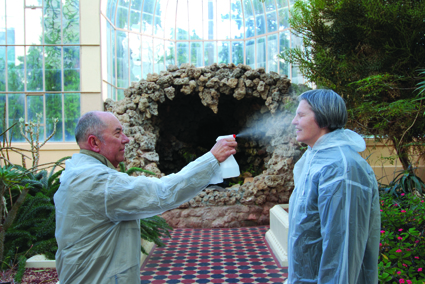
Aleks Danko, Jude Walton, A list of positive things for later when things may not be so positive, Palm House, Adelaide Botanic Garden
photo Michael Zerman
Aleks Danko, Jude Walton, A list of positive things for later when things may not be so positive, Palm House, Adelaide Botanic Garden
AT MEDIEVAL FEASTS THERE WAS A PARTICULAR CLASS OF DISH CALLED SUBTLETIES. TRICKSY DISHES, THEY WERE MADE FOR EFFECT (MARZIPAN CASTLES, BIRDS IN A PIE) AND ALL ABOUT ILLUSION AND ITS DISSOLUTION. COLLABORATIONS BETWEEN MAKER AND AUDIENCE, THEY DEPENDED ON THE DINER’S WILLINGNESS TO RISK ENTERING THE UNKNOWN AND THE ILLUSIONIST’S CREATIVE SKILL. IN RETURN FOR BELIEF THE REWARD WAS SURPRISE AND DELIGHT. THIS TACIT CONTRACT LIES TOO WITHIN COLLABORATIVE PARTNERSHIPS. AS COLLABORATORS ARE TWINNED AND DOUBLED, SO RISK AND DELIGHT ARE INTIMATELY ALLIED. NO LIGHT THING, DELIGHT IS SHADOWED BY LOSS AND FOR THE DELIGHT OF WHAT IS GIVEN AND CREATED, COLLABORATORS CONTINUALLY RISK IT.
It’s not such a long way then from marzipan castles to Pip and Pops’ fantastical sugar landscapes, Farrell and Parkin’s gleeful animation or the joy of two poets talking on a bright cold day, for delight runs deep through Duetto’s rich offerings.
Twinning exhibitions with film and performance elements, the Australian Experimental Art Foundation’s exploration of the nature of collaborative partnerships, Duetto, ranges over a broad variety of collaborative forms and expressions. What emerges most strongly from this multiplicity is a sense of sustenance—of sustaining and being sustained by these ineffable and often alchemical relationships. While these may, as director Domenico de Clario writes, “resist any kind of articulation” (Duetto catalogue), the scaffolding is there to be sensed in the rhythms, synergies and patterns of the work.
Delight is immediate with Pip and Pops’ Three minutes happiness (2010), their grand, hugely detailed landscape composed wholly of coloured sugar, origami follies and craggy mountains. Its wealth of things (birds, lights, horses, rainbows) technicolour palette, scale and idiosyncratic sensibility fascinate. Yet it’s not simply whimsy with the landscape forms and arrangements owing as much to Japanese gardens, with their raked patterns and symbolism, as to the sensibilities of kawai culture’s cuteness. In the same way that Japanese landscapes draw the viewer into contemplation, the absolute superabundance of Three minutes happiness provokes wonder, drawing the eye in and through, revealing something gentler and deeper.
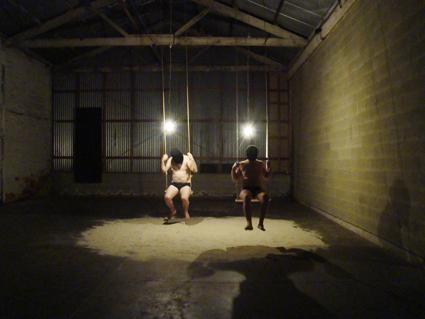
D&K, The stranger and his friend, Queen’s Theatre
photo Teri Hoskin
D&K, The stranger and his friend, Queen’s Theatre
Here collaboration emerges as ethical. Greg Burgess and Pip Stokes write of their relationship as “a form of healing care of the self and other” and their term “the architecture of kindness” seems an apt and expressive one for the structures of nurturing partnership and for the persistence of care that abounds in the works in Duetto. D&K’s performance The stranger and his friend (2010) involved the two men almost naked, hooded in black, slowly swinging and singing hymns beneath naked, single light bulbs. Haunting, it was also a work of great and unexpected tenderness.
Janine Antoni and Paul Ramirez Jonas’ two-screen video work Migration (1999) shows one artist endlessly stepping into the only just made footsteps of the other. Quoting Octavio Paz on the experience of love, “we are the theatre of the embrace of opposites and their dissolution,” the continuous production of the self, other and the collaborative third is embodied in this endless loop of making and dissolving footsteps.
This experience of being joined and yet individual is articulated as forms in space in Burgess and Stokes’ Sense (2009). Hollow beeswax blocks, the six-sided form referencing the cell and collective life of the beehive, are arranged in an open curve, like a half built tower. Neither open or closed, the curve creates a sheltering space defined by the tension between openness and enclosure. Not simply a work between two people, photographed in its original bushland setting, Sense extends collaboration into a healing relationship with nature.
The doubling of self and other moves through the spoken word poems of Aleks Danko and Jude Walton. Taking their audience on a rambling processional through the Adelaide Botanic Gardens they performed A list of positive things for when things may not be so positive (2010). An index of first lines borrowed from other poets—”musing on roses and revolutions,” “beauty and beauty’s son,” “and the winter’s cold bright tulips we do know”—grew into a singing duologue of lines bouncing back and forth between the poets, a gentle rhythm of the accommodations of each to the other’s thought. Enveloped jellyfish-like in raincoats in the Victorian Palm House, they gave us a couplet of longing (“I mist you,” “I mist you too”) as they lovingly sprayed water into each other’s faces. The rhythm of this nurturing partnership flowed through it all as play and humour.
Different sorts of collaborations take place in the works by Stelarc and Nina Sellars and Farrell and Parkin as they expand and mutate the possibilities of collaboration. Stelarc’s Ear on Arm (2010), seen as a giant sculpture and surgical photographs, is to be internet enabled with microphone and transmitter allowing remote transmission and input. Becoming many to one, Ear on Arm both diffuses the idea of collaboration as necessarily intimate and complicates it as the ear becomes the implanted collaborator.
As Stelarc morphs self into many, Farrell and Parkin merge in their kooky manga video Physiology of spite (2009/10). Stretching the possibilities of portraiture, Farrell and Parkin have mutated their images into cartoon beings. Seen first as themselves they mutate into winged creatures that spread flaming, highly coloured destruction. Against this unreal apocalypse comes the third creature made of their merged photographic selves, a golden ambiguous angel. This oddball take on the collective self embodies their practice, their joyful willingness to enter into the collaborative moment, recognising its generative possibilities and the surprise and delight therein.
Missing my own domestic collaboration, I couldn’t attend the World Cup tribute soccer match or Domenico de Clario and Stephen Whittington’s tribute to the eclipsed moon, Universe as Mirror (2010). But in a way the descriptions of these celebrations were enough. Delighting me in the telling, in my brain they became something other than what actually happened. Ideas connect and grow; every time a tiny collaboration.
AEAF, Duetto; Queens Theatre, Mercury Cinema and Adelaide Botanic Gardens, Adelaide, May 28-June 26
RealTime issue #98 Aug-Sept 2010 pg. 52
© Jemima Kemp; for permission to reproduce apply to realtime@realtimearts.net
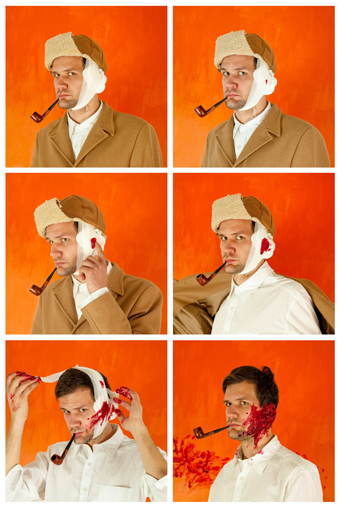
I, Goghbot, 2010, Reges Lobud, digital print
courtesy the artist
I, Goghbot, 2010, Reges Lobud, digital print
IN THE AUGUST-SEPTEMBER ISSUE OF REALTIME EACH YEAR WE TRY WHERE POSSIBLE TO FEATURE INTERESTING WORKS BY STUDENTS, RECENT GRADUATES AND EMERGING ARTISTS. OUR SEARCH TAKES IN UNIVERSITY WEBSITES AS WELL AS EVENTS SUCH AS THE HATCHED GRADUATE ARTISTS EXHIBITION HELD AT PICA EACH YEAR. MORE RECENTLY, WE’VE CAST OUR EYES OVER THE SHORT-LIST FOR THE NATIONAL YOUTH SELF-PORTRAIT PRIZE HOSTED BY THE NATIONAL PORTRAIT GALLERY IN CANBERRA.
That’s where we came across our striking cover artwork entitled I Goghbot, 2010 by Egres Ludob. It didn’t win the prize (that was awarded to Bridget Mac for her portrait masculine/feminine). In interpreting Van Gogh’s famous Self-Portrait with Bandaged Ear, Ludob says he “tried to envisage what the work would look like when adapted for modern trash culture which favours shock value and ultra-realism.” At the same time he wanted to “maintain a tongue in cheek criticism of trash culture. When historical works or events are reinterpreted in popular culture, for me they lose a lot of romanticism and mystique due to sensationalism.”
I, Goghbot is part of a series of works that Ludob is working on, based around a similar theme of selective re-imagination of historical works in a modern context.
I asked Egres Ludob’s alter-ego Serge Bodulovic about his educational trajectory which offers an example of the progress of the young working artist in the age of creative industries. He wrote, “I graduated from ANU in 2007 with B Comm (majoring in Marketing) and B Arts (majoring in Art History) degrees. I also completed a fashion design course in Milan after completing university.
“I had decided to study commerce, particularly marketing and advertising because it enabled me to combine creative expression with an educational background that could be utilised in any industry or endeavour. I also like the referential and humorous aspects of marketing and advertising, which I try to adopt in my work. Whether my marketing studies can be used in the traditional sense still remains to be seen. I had also wanted to study Fine Art, but was unable to do so while studying commerce, as the ANU did not offer cross-institutional studies between Fine Art and the Commerce faculty. So I switched my focus to a more academic study of art. My studies in Art History, including film have added to my passion for popular culture and allowed me to get an in-depth insight into the lives and times of artists and movements.”
As well as maintaining his own art practice and curating shows at the Canberra Contemporary Art Space and other galleries, Serge and his colleague Simon Gibson founded the designer boutique menswear label, Book Club.
“While there are clear overlaps between the two in a creative sense as both use the medium of photography, I personally treat them as two separate areas of endeavour, hence the use of an (admittedly poor) nom de guerre for my artworks. The reason why I separate the two areas of my life is due to the fact that with fashion design there are commercial realities that need to be addressed in order to have a successful label. With art, it is purely a means of self-expression, not based on commercial considerations. I also have more trepidation about showing my works as an artist as it’s a more direct representation of my creativity than fashion design, which is more removed as it deals with tangible, utilitarian objects.”
National Youth Self-Portrait Prize, Finalists exhibition, National Portrait Gallery, Canberra, on show to September 12. http://www.portrait.gov.au
RealTime issue #98 Aug-Sept 2010 pg. 53
© Virginia Baxter; for permission to reproduce apply to realtime@realtimearts.net
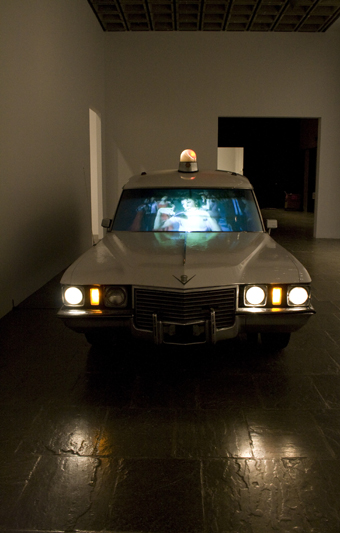
We Like America and America Likes Us (2010), The Bruce High Quality Video Foundation
BOTTLES AND JARS WRAPPED IN RED NET HOLD AMBER, JELLY-LIKE SUBSTANCES AND HANG ABOVE AND NEXT TO OLD ELECTRICAL DEVICES, STOOLS AND BOXES. A SLIGHT WOMAN STANDS AT THE WALL DRAWING A LARGE CHARCOAL GRAPH, ITS SHAPE TRACED IN CONFIGURATIONS OF ROPE AND NETTING. WITH LARGE CUSHION ‘DOUGHNUTS’ ON HER ARMS, WHILE PROJECTORS TURN ON AND OFF, SCREENING LIGHT AND SCIENTIFICALLY FORMED CIRCULAR SHAPES, SHE MAINTAINS A CONTINUOUS MONOLOGUE ON THE MATHEMATICAL CONCEPT OF THE LORENTZ ATTRACTORS (WHOSE CONTINUOUS MOVEMENT AROUND CERTAIN POINTS CREATES DOUGHNUT-LIKE SHAPES) CONNECTING HER ACTIONS TO THE INSTALLATION. THIS IS STRANGE ATTRACTORS, A FRENETIC PERFORMANCE PIECE AND UNCANNY INSTALLATION BY AKI SASAMOTO INCLUDED IN THE 2010 WHITNEY BIENNIAL.
Sasamoto’s sustained action and disorienting monologue created a language that underscored the experimental possibilities of intersection, confluence and the everyday nature of disjuncture. A little like a ‘happening,’ the physical and linguistic permutations of the performance seemed to foreground the trajectories of this year’s biennial and its media works in which the language of modernism—its reconfiguration—and the centrality of experimentation and abstraction were guiding aesthetics.
The ‘intermedia’ aesthetic of Strange Attractors found resonance through a confluence of spoken word and image in The Bruce High Quality Foundation’s video work. On a white Cadillac Miller-Meteor’s windscreen they projected a video created out of YouTube clips (think funny cat videos and babies throwing food), Hollywood movies (Ghost Busters, Frankenstein, Independence Day) and news media. The vehicle—designed to double as hearse and ambulance—provides an engaging viewing platform across which this stream of images, iconic and everyday, lulls us into a comforting visual rhythm.
The images fade in and out while a low female voice soothes us with descriptions of her/their relationship: “We like America. And America likes us. But somehow, something keeps us from getting it together. We wished we could have fallen in love with America. She was beautiful, angelic even, but it never made sense…America stayed simple somehow. He stayed an acquaintance, despite everything we shared. Just a friend.”
We Like America and America Likes Us (2010) makes clear references to Joseph Beuys’ I Like America and America Likes Me (1974). Both works deal with the cultural myths of America, reviving them, critiquing them, exposing them. But in this piece the centrality of human physicality is muted as the image/text confluence sculpts us into the work. It’s confrontational—the images in their strange juxtapositions demand some kind of imaginative work. It’s also ritualistic: the slow cadence and rhythmic relationship of the film clips to the voiceover recreates the open space of the white walled room (lined with large digital images of Lorrain O’Grady’s First and Last of the Modernists, 2010) into something more reverential, within which the large white motor vehicle serves as mausoleum and instrument of healing. Standing in this space evokes an intense feeling of collectivity: the voiceover, hushed, solemn, also disjointed, provides something like an architectural frame. The monologue layers over and insulates the soft flow of images, while threading us into its passage of time.
These works and the artists creating them spoke back to a history of modernism in which language—and its abstraction into the realm of the performative—was central. A floor below, Ärztliche Zimmergymnastik (2008), the video work of Jesse Aron Green, created another form of abstraction in the angulated movement of his performers. His work is based on a book of the same name by Dr Daniel Gottlob Moritz Schreber (1808-1861; his son’s self-documented hallucinatory nervous illness fascinated Freud) detailing a system of exercises designed for the maintenance and invigoration of a healthy body and mind. Green uses the book as a kind of ‘score,’ his revolving camera (slowly making a complete revolution of the room in 80 minutes) captures 16 men performing an entire catalogue of physical movements executed according to the 45 exercises created by Schreber. Green’s gridded arrangement, the pieces of its constructions—the wooded plinths the performers stand on—and the extended duration of his single shot camera work reference minimalism and structural film making, highlighting and critiquing the relationship between these modernist art practices, psychoanalysis and the ideologies of 19th century German physical culture.
Tracing this history, the work nonetheless maintained a remarkable lack of rigidity. I was struck by the coalescence of the bodies, the way arms, heads, feet moved in sequences that solidified into a kind of bodily legibility characterised by a silent fluidity. In the seamless rotation of the camera and its slow elucidation of the bodies on view, the aesthetic rigidity of these earlier art practices was brought into a more intimate plane. As I watched, for at least half an hour, this formal abstraction of the body into gesture seemed more akin to a poetic anthropology. Becoming aware of the exact motions, a fine attenuation of muscle, skin, bone in the thrust of an arm, the curve of a neck, the elongation of a foot, Green created the space for a heightened sensitivity to what I can only describe as a physiological collectivity of (self) awareness.
The expansion of the video screen into the space of the gallery was effective in Parole (2010), a multi channel video projection by Sharon Hayes. Each of four walls held a video screen, and the work itself was housed within the four walls of a Whitney white box. Once inside the ‘inner’ structure—composed of plywood, plank supports, PA systems and wall coverings—I sat and watched various scenes of public speech play across the four screens—news segments, speeches, public recordings, auditions—each of them connected through the inclusion of a mysterious, silent, red-haired figure. This figure records sounds—political lectures, erotic readings, a kettle boiling, the reading of a love letter—but never speaks. Her silence is translated into a constellation of facial expressions that keeps time with the work’s expansion across the space of its projection. It unfolds around me through a simultaneity of differing experiences, flow of emotions and snatches of recognition. Poetic yet highly simulated the work examines the alluring, and harmful, power of speech, the marginalisation of sexual minorities and in its haunting expansiveness provided a uniquely communal sense of personhood.
A few rooms on I came across Annotated Plans For an Evacuation (2009) showing artist Alex Hubbard modifying his Ford Tempo. Shot in static profile by a camera attached to the side of the vehicle, Hubbard’s alteration followed a deliberate plan in which the continual transformation of his car unfolded to a soaring soundtrack across a shallow depth of field that immediately entangled me within its small, tucked away space at the back of the gallery. The deadpan purpose of Hubbard’s automotive alterations led only to a process of sustained movement, poignant and painterly in its action. A haunting complement to the structural analysis of Ärztliche Zimmergymnastik this study in time transformed the screen into a canvas in which the banality of the everyday and the mechanics of the industrial are pictorially arranged into a series of precise colours, lines and angles. An animated form of assemblage, Hubbard’s alterations called attention to the textural work of video, its ability to elongate and compress our sensory perceptions.
In the sculpture courtyard transformed by Theaster Gate’s installations of shoeshine chairs—a wooden pavilion, and walkways lined with repurposed Wrigley gum boxes—I watch Derek Chan crouching over a large checkered square of calligraphy paper. He slowly markes off each square—a diary of thoughts—with a random series of signs, sometimes breaking off to speak with viewers and obstructing the completion of his patterns. A study in the informal practices of everyday interaction and the specificity of urban life, Chan’s performance of serialisation and introspection is an intriguing complement to the graphic loops of dialogue and objects in Strange Attractors. The new media ‘aesthetic’ in the mutual fascination with serialisation and patterning to screen the encounter between artist and viewer highlighted the ritualised gestures that animate our everyday interactions.
What emerged for me in these video and performance works were the collective possibilities of new media. Through the ‘intermediation’ of text, image and installation the expansive and elemental historical languages of modernism were refigured through forms of contemporary abstraction.
2010 Whitney Biennale, Whitney Museum, New York, Feb 25-May 30, http://whitney.org/Exhibitions/2010Biennial
RealTime issue #98 Aug-Sept 2010 pg. 54
© Anna Arabindan-Kesson; for permission to reproduce apply to realtime@realtimearts.net
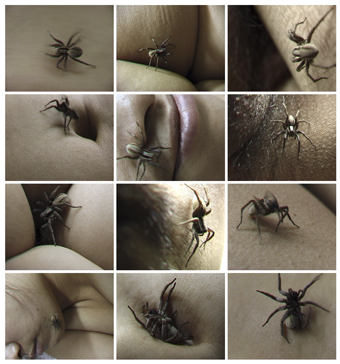
Looking, Looking, Looking for…, Kan Xuan (2001)
courtesy of the artist
Looking, Looking, Looking for…, Kan Xuan (2001)
GREETING US AT THE ENTRANCE TO THE GALLERY ARE TWO TRADITIONAL CHINESE LIONS. RATHER THAN BEING CARVED OF STONE, HOWEVER, THESE CREATURES ARE TRAPPED INSIDE SCREENS, THE LION ON EACH SIDE SPLIT BETWEEN TWO STACKED MONITORS. FAR FROM UNHAPPY ABOUT THEIR FATE, THESE LIONS ARE PLAYFUL, WINKING AT US, LIFTING PAWS AND SENDING OUT THE OCCASIONALLY PROVOCATIVE ROAR. THE WORK, ALWAYS WELCOME (2003) BY WANG GONGXIN, ONE OF CHINA’S LEADING VIDEO ARTISTS, OFFERS AN INVITING INTRODUCTION TO MU:SCREEN, AN EXHIBITION OF CHINESE VIDEO ART CURATED BY MARIE TERRIEUX AT THE UTS GALLERY.
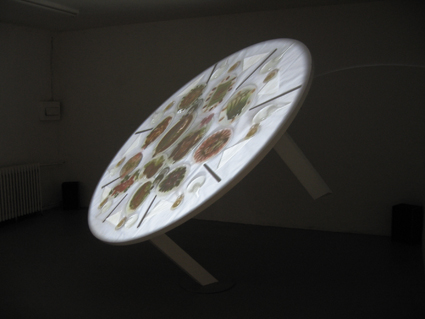
The Dinner Table, 2006, Wang Gongxin
courtesy the artist, collection of the Neilson Family, White Rabbit Collection, Sydney
The Dinner Table, 2006, Wang Gongxin
Wang Gongxin contributes another sculptural video work, The Dinner Table (2006). An oversized tabletop on a precarious 60-degree angle acts as the screen for the projection of a fully set banquet table. Gradually we begin to notice that the sauce from some of the plates is seeping across the table, but defying gravity, oozing upward. Before long, food and cutlery are all impossibly sliding up and over the edge, accompanied by soft crashes and clangs, until all that remain are the stained tablecloth and a few napkins, which are also whipped off, surprisingly from the lower side of the table. Wang’s challenge to viewers’ spatial perception is a potent metaphor for the provocations that art can offer to established ways of seeing—particularly resonant as he is one of the first artists in China to push beyond traditional mediums to explore video.
Zhang Peili is in fact recognised as the first Chinese video artist. The piece included here, Water—Standard Version from the Dictionary Ci Hai (1992), features a news presenter reading the full nine-minute definition of the word for water from a dictionary. As there is no translation offered, the experience for an English speaker is purely conceptual, but the correlation with works by Western artists such as Bruce Nauman is clear. As Peili is such an important figure, it would have been interesting to experience at least one other work of his (as we do with Wang) to get a clearer sense of his practice and of the beginnings of video art in China.
There appears to be a clear lineage between Zhang and Wang’s work—in the manipulation of temporal qualities and the concentration on live action—expressed in the work of two of the younger artists represented. In Kan Xuan’s Looking, Looking, Looking For…(2001), presented on a small screen, a tiny spider skitters over naked male and female bodies, exploring every crevice and orifice. Both playful and disturbing, the work has the ease and directness of approach that characterises a generation born into a media and technologically driven age. Similarly, Ma Qiusha’s A Beautiful Film (2007) suggests an artist immersed in a critical exploration of screen culture as well as contemporary representations of sexuality. She uses close-ups of pornographic images to create a hazy, romanticised vision of beauty, accompanied by endlessly scrolling movie credits.
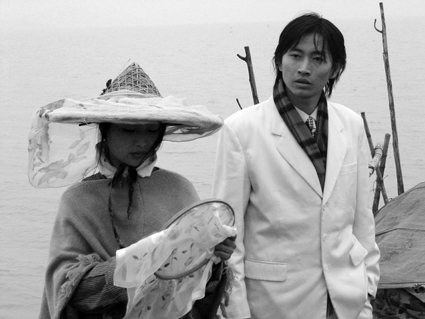
Liu Lan, 2003, Yang Fudong
courtesy of Shanghart gallery
Liu Lan, 2003, Yang Fudong
Yang Fudong, has recently been introduced to Australian audiences with his disturbing work East of Que Village (2007), presented as part of the recent Biennale of Sydney (RT97, p 46). A less harrowing experience, his work in this exhibition entitled Liu Lan (2003) is stunningly shot on 35mm black and white film (transferred to video) and focuses on a beautiful young fisherwoman on an eerily isolated lake where she is joined by a handsome man from the city wearing a white suit. It is a quiet, romantic vision of an impossible meeting occasionally undercut by the extraordinarily weathered face of an old woman, hinting at these as her memories or dreams. Under the veneer of idyllic beauty is a subtle sense of irony and social criticism that gives the work its intensity.
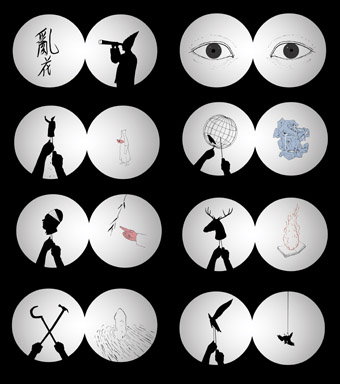
Flowers of Chaos, 2009, Wu Junyong; exhibited as part of Mu: Screen, UTS Gallery
courtesy of the artist
Flowers of Chaos, 2009, Wu Junyong; exhibited as part of Mu: Screen, UTS Gallery
Interestingly, three of the artists utilise drawing and animation. Most intriguing is Flowers of Chaos (2009) by Wu Junyong who, with his simple, almost naive line drawings, creates his own symbolic language to explore power, manipulation, repression and freedom in a strangely joyous way. Sun Xun’s People’s Republic of Zoo (2009) also explores these themes, with animal/human chimeras acting out symbolic power plays. Sun’s animation is a complex collage of styles reminiscent of William Kentridge—drawings, cutouts and actual video footage of shadow play—that bring to mind a dark, often opaque dreamscape.
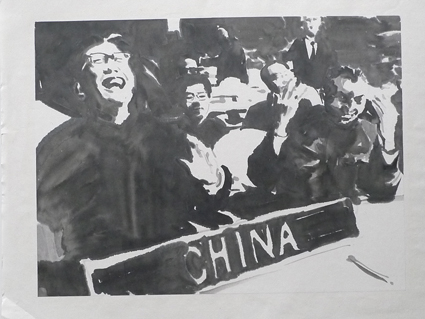
The Ink History, 2010, Chen Shaoxiong
courtesy the artist
The Ink History, 2010, Chen Shaoxiong
With four works presented, it is hard not to see Chen Shaoxiong’s Ink series as the centrepiece of Mu:Screen. Created from hundreds of ink drawings, these simple animations often involve just flipping through different scenes, or at most a close-up or pan within an image. It’s the accumulation of detail that makes these works so powerful. Across the four screens, we move from everyday life in The Ink City (2005) to the personal in The Ink Diary (2006), to a micro view in The Ink Things (2007), ending with the macro in The Ink History (2010), an epic exploration of Chinese history. Chen’s work is particularly poignant, not only in its subject matter—the methodology itself illustrates the tensions between old and new media.
The UTS Gallery was well transformed to house the substantial number of video works in this exhibition, although the issue of soundbleed presented a problem. While some works were well served by headphones, there were still four soundtracks mingling in the reverberant, tiled space. The effect was exacerbated in the use of video projectors as audio source for two works rather than placing speakers in close proximity to the actual projection. This meant that sound and image became quite dislocated and confusing, particularly in the case of Sun Xun’s work.
Marie Terrieux is a freelance art consultant, with her own company, Shuang Culture, advising collectors and institutions and working with established and emerging artists from China and the region. Her thorough knowledge of the Chinese art scene is evident in this exhibition, which includes illuminating contextual information on the website. Terrieux’s choice to present artists across three generations provided a fascinating introduction to an area of art-making only just beginning to make the same impression as other Chinese art practices on the international stage.
Mu:Screen, three generations of video art, curator Marie Terrieux, artists Wang Gongxin, Zhang Peili, Chen Shaoxiong, Yang Fudong, Ma Qiusha, Wu Junyong, Sun Xun, Kan Xuan; UTS Gallery, Sydney; June 1-July 9; www.utsgallery.uts.edu.au; www.muscreen.com
Wang Gongxin’s The Dinner Table (2006) was lent to Mu:Screen by the White Rabbit Gallery, Sydney which houses the largest private collection of contemporary Chinese Art outside China. www.whiterabbitcollection.org
RealTime issue #98 Aug-Sept 2010 pg. 56
© Gail Priest; for permission to reproduce apply to realtime@realtimearts.net
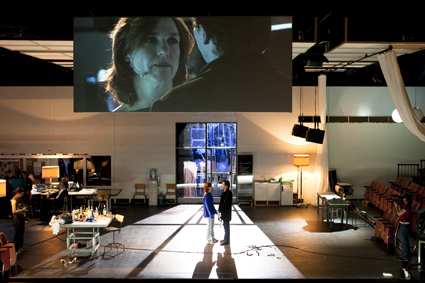
Opening Night, Toneel Groep, Melbourne Festival 2010
photo Jan Versweyveld
Opening Night, Toneel Groep, Melbourne Festival 2010
9.30AM, SYDNEY HILTON HOTEL SUITE: COFFEE, PASTRIES, FOUR MEMBERS OF THE PRESS AND BRETT SHEEHY. AN INTIMATE, 50-MINUTE BRIEFING ON THE ARTISTIC DIRECTOR’S PROGRAM FOR THE 2010 MELBOURNE INTERNATIONAL ARTS FESTIVAL. IT’S THE SECOND OF THREE BRIEFINGS THIS MORNING AND ONCE WE GET PAST A LUMPEN CELEBRATION OF THE 2009 FESTIVAL’S ECONOMIC SUCCESSES (“I KNOW IT’S NOT ABOUT THE MONEY, BUT FINALLY IT IS ABOUT MONEY”), SHEEHY’S POSITIVELY EFFERVESCENT.
A festival theme, “a motif,” he declares (conjuring images from his laptop onto the big screen before us), has emerged naturally from the well-spring of his discussions with Australian and international artists selected for the festival. “Spirit,” “mortality,” “transformation,” “transition,” “transcendence,” “ascension” and “epiphany” consistently bubble forth as the ever speedy Sheehy briskly uncaps his program. No mere froth and gas, there’s plenty of body here: a festival about “mortality and spirituality, not in a religious sense, but in terms of transition and transcendence.”
cassavetes’ opening night
The standout work in the program, and the one on which Sheehy lavishes most attention in this briefing is Toneelgroep Amsterdam/NTGent’s Opening Night by John Cassavetes, directed by Ivo van Hove whom Sheehy ranks as “one of the greats with Mnouchkine and Ostermeir” (whose works have appeared in Sheehy festivals). Van Hove is reproducing the 1977 Cassavetes classic on stage. As opening night of a new play draws near, an ageing actress faces emotional collapse after the death of a fan, “confronts her own mortality,” says Sheehy, “and comes out the other side with an epiphany.”
Sheehy explains that “over the last few years van Hove has been dissecting theatre and cinema and looking at the points of cross-over and diversion. Camera men and women, all professionals from the world of cinema, constantly feed the performance live by video [to screens large and small], creating a real time film of the performance throughout.” Cinema took much from theatre in its evolution and now “Van Hove is taking back from cinema certain of its achievements and putting them into theatre to create something new and fresh—the closeup, multiple points of view, sonic veracity. This is not new, directors have worked with video, but the way van Hove does it completely enhances the theatrical experience—every single scene is lit and blocked for both cinema and stage, for every seat, in real time in a work about a stage production.” One third of the audience is seated on the stage, ‘playing’ their theatre double.
For those of us who have admired Australian director Benedict Andrews’ virtuosic and integrated use of video in The Season at Sarsaparilla (RT78, p11) and Measure for Measure (p8), van Hove’s realisation of a film classic as a stage-cum-film work will, it’s to be hoped, engender further theatrical possibilities while offering a new understanding of Cassavetes’ unique vision.
hotel pro forma: tomorrow, in a year
There’s more hybridity abroad in the festival’s opera and music theatre offerings. Denmark’s Hotel Pro Forma, working to a score by Scandinavian electro-pop duo The Knife and the choreography of Japan’s Hiroaki Umeda, “creates a new species of electro dance opera.” Titled Tomorrow, In a Year, the opera celebrates the 2009 150th anniversary of the publication of Charles Darwin’s The Origin of Species. Darwin appears as a character alongside Time and Nature—our understanding of which he radically reconfigured—with singers and dancers in a spectacular aural and visual stagescape, reminding us of the transcendant sense of duration, variation and diversity Darwin bequeathed. (A laterally related work, epi-thet, by Melbourne composers Madeleine Flynn and Tim Humphrey [p47], offers audience members sonic and visual responses to their genetic makeup in terms of height, posture and movement in a work inspired by an ANAT Synapse Residency with Dr Shane Grey at the Garvan Institute of Medical Research in Sydney.)
heiner goebbels: sifters dinge
Heiner Goebbel’s Sifters Dinge (Sifter’s Things; RT86, p54) is performed not by singers and musicians but by programmed, up-ended pianos “over a massive dry ice pit to a soundscape that includes Malcolm X speeches”—an installation as performance, in a theatre, with an inevitable touch of the uncanny. Goebbels, a multimedia pioneer, was inspired by the pantheistic writing of a 19th romantic, Aldabert Sifter. Sheehy describes the work as “deeply political and, finally, a homage to nature.” Given that Sifters Dinge “is almost impossible to describe,” Sheehy wonders what kind of reviewer—music, theatre, visual arts—editors should send to experience the work in which “the pianos play, fog rises, rain falls, water bubbles, objects move mysteriously” [Press Release]. There’s original music by Goebbels, traditional chants from South America and Papua New Guinea, fragments of texts from Sifter’s novels, quotations from Claude Levi-Strauss, William S Burroughs and Malcolm X. Goebbels will speak about his work at the festival.
david chesworth: richter/meinhof-opera
Melbourne composer David Chesworth will premiere Richter/Meinhof-Opera (to a libretto by Tony MacGregor), “exploring the limits of representation and direct action.” To be staged at the ACCA gallery, the opera is inspired by German artist Gerhard Richter’s October 18, 1977, a series of paintings responding to the alleged suicides of jailed Baader-Meinhof Group members and accused at the time of “aestheticising terrorism.” Will the charge be repeated this time? This 45-minute work will musically and visually conjure a dark period in western democracy, one with immediate resonances, says Sheehy.
robert lepage: the blue dragon
Brett Sheehy says it’s usually anticipated that Canadian director Robert Lepage’s multimedia works will be “between four and seven hours in length, but The Blue Dragon is one hour 45 minutes: imagine all that theatricality and theatre magic condensed down into an absolute gem of a production.” This time Lepage focuses on three people in contemporary Shanghai: “a Canadian ex-pat who runs a gallery in the city’s art district, a young Chinese artist exhibiting at the gallery and a Montreal advertising executive in town to adopt a Chinese baby.” Sheehy sees the work as being about “the West grappling with the new China especially the Chinese artist.” Doubtless The Blue Dragon will display Lepage’s engaging theatre magic, but will it also feature the soap-operatics of Lipsynch (RT87, p3), with its crudely ‘transcendent’ treatment of a central female figure? And, the choreography of Tai Wei Foo (Singapore/Canada) aside, in what ways will Lepage choose to represent Chinese art?
australian art orchestra: soak+the hollow air
Paul Grabowsky and the improvising Australian Arts Orchestra frequently inspire with their cross-cultural collaborations. On this outing the focus, in two works, is multimedia. The Hollow Air brings together the AAO and shakuhachi player Riley Lee with “sound projection and real time digital manipulation using the visual programming language MAX/MSP.” Soak is described as “a live music and film experience…an extended ambient work, it slowly unfolds through compositional elements influenced by artists such as Arvo Pärt, Henryk Górecki, Brian Eno, Radiohead, Dust Brothers and Miles Davis.” Australian film artist Louise Curham will use a variety of projectors and screens to provide another layer of improvisation. The aim is, again, transformative, to create “an aural and visual exploration of sound that breaks down distinctions between musical genres and incorporates elements of ambient music, electronica, contemporary art music, jazz and rock” [Press Release].
thomas adès: in seven days …
Britain’s leading ‘contemporary classical’ composer, Thomas Adès will be in-residence at the 2010 festival. The American Calder Quartet joins Adès on piano to perform his Piano Quintet. Adès also directs musicians of the Australian National Academy of Music in a program of his own music and of “music close to his heart” by Rameau and Couperin. Michael Kieran Harvey, Anthony Pateras and musicians of the Academy will perform Thomas Adès’ Living Toys and the world premiere of String Quartet by Anthony Pateras.
The Melbourne Symphony Orchestra will play Adès’ violin concerto Concentric Paths, written for and performed by Anthony Marwood, and present the Australian premiere of In Seven Days Piano Concerto with Moving Image: “a collaborative work between Adès and video artist Tal Rosner…described by the artists as a video-ballet in seven movements that follows the Genesis tale of creation. The visuals and the music tell the story in a set of abstract variations, each new element—light/darkness, sea/sky, heavenly bodies, plants, creatures…” [Press Release].
akram khan, michael clark, hiroaki umeda
In Vertical Road, the multicultural Akram Khan Company (including Australian dancer Paul Zivkovich) will explore the pan-cultural phenomenon of angels who travel the road, as Sheehy puts it, “to heaven or whatever’s up there”, danced to a score by Nitin Sawhney in an investigation of “ascension.” Also the UK-based, Michael Clark Company will perform a new work (London premiere, October 3), come, been and gone, with Clark’s trademark mix of ballet and modern dance here set to the music of David Bowie and collaborators Lou Reed, Iggy Pop and Brian Eno. Sheehy describes the work as “an exploration of the musical world of the 70s and 80s and Clark’s own journey through it, with a moment of epiphany at the end.” Hiroaki Umeda, as well as choreographing for Opera Pro Forma, will perform two solos to his own computer, lighting and sound design. In Adapting for Distortion, “engulfed in computer generated sounds and optical effects, Hiroaki Umeda’s body seems to slowly fade away and go out of focus within luminous lines and spirals, until it is a mere vibration, a shadow of its real self.” In Haptic, Umeda works, minus computer, with light and colour. Evanescence and a sense of time standing still are central to the Umeda experience (RT 94, p38).
beckett, keene, ranters, jack charles, optimism
The Irish/French theatre company Gare St Lazare Players Ireland will perform The Beckett Triology, adaptations of the novels Molloy, Malone Dies and The Unnameable by Samuel Beckett. Sheehy describes the performance—a “solo marathon” by leading Beckett exponent, Conor Lovett—as “riveting; it flies by,” doubtless not before throwing us into a few existential black holes and racking us with laughter. Daniel Keene gets a Melbourne Theatre Company guernsey after all these years. Sheehy describes Life Without Me as “a cross between Sartre’s No Exit and Fawlty Towers: an eccentric fable about taking up residence and trying to move on.” In another work on the theme of transition, Melbourne’s Ranters Theatre further their successful, cool poetic modus operandi of recent years with Intimacy, “a performance about intimacy in the age of celebrity,” says Sheehy.
Ilbijerri Theatre Company will premiere the solo performance Jack Charles V The Crown, featuring the Aboriginal actor (the subject of the documentary, Bastardy, RT91, p24) “at the peak of his powers” and a script by John Romeril based on Charles’ life in crime, theatre and on the road—challenges faced with “constant and unswerving optimism.” Optimism against the odds is also the subject of eccentric Canadian writer-performer Jacob Wren and Belgian writer, philosopher and theatre-maker Pieter De Buysser’s An Anthology of Optimism. The pair asked 200 business people, scientists and artists about their inclination—optimism or pessimism?—and collated the results into a droll, “low-tech as you can get” two-hander lecture-performance which will also canvas local opinion: “What sort of meaning can optimism have today in this era of heightened terrorism awareness and global warming..?”
Cabaret, live art and weirder stuff will populate Finucane & Smith’s Carnival of Mysteries at 45 Downstairs with 30 artists curiously “commissioned to respond to the Mysteries of Innocence, Passion, Mercy, Forgiveness and Love.” In the tradition of sideshow alley, you’ll wander four sites and buy tickets for what grabs you: music, miracles, freakery.
more transformation, transcendence…
Look out for Australian recorder virtuoso Genevieve Lacey and UK filmmaker Marc Silver’s part concert, part film, part installation immersive bird flight experience, en masse. US video artist Bill Viola will be showing The Raft at ACMI and Fire Woman and Tristan’s Ascension at St Carthage’s Catholic Church in Parkville—a 20-minute loop drawn from Viola’s contribution to Peter Sellars’ New York production of Wagner’s Tristan and Isolde. It’s less intimate than Viola usually is, but is nonetheless engrossing. In Sydney it attracted large numbers for months in a Redfern church. Aboriginal photographer Bindi Cole will curate an exhibition titled Nyah-Bunyar (Temple) at the Arts Centre: “it’s about contemporary Koori spirituality in an urban culture.” Sheehy adds that “at ArtPlay Cole will explore traditional mourning ceremonies with children and their families.” The titles of other visual arts shows are also telling: Gertrude Contemporary’s Dying in Spite of the Miraculous and ACCA’s Mortality.
seven songs to leave behind
The final festival show, Seven Songs to Leave Behind, asks singer-songwriters to perform favourites from their own and others’ repertoires, including the one song they would like to bequeath to the future. The lineup includes Sinead O’Connor, John Cale, Meshell Ndegeocello, Rickie Lee Jones, Gurrumul Yunupingu, Leah Flanagan, Shellie Morris, Dan Sultan and Ursula Yovich. Aptly, for a festival with a free-floating sense of the spiritual, this concert-ritual should confirm a sense of sharing between artists and audiences including the festival’s unavoidable sense of mortality and offerings of moments of transcendence. Brett Sheehy wraps up the briefing jovially, declaring that “there’s more levity in this year’s program; last year was much darker.”
Melbourne International Arts Festival, Oct 8-23, www.melbournefestival.com.au
RealTime issue #98 Aug-Sept 2010 pg. 16
© Keith Gallasch; for permission to reproduce apply to realtime@realtimearts.net
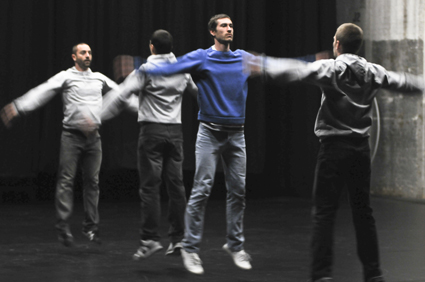
Jay Robinson, Adam Synnott, Lee Serle, Alisdair Macindoe, Bromance
photo Heidrun Löhr
Jay Robinson, Adam Synnott, Lee Serle, Alisdair Macindoe, Bromance
BROMANCE—A NON-SEXUAL, INTIMATE RELATIONSHIP BETWEEN TWO MEN; A FRIENDSHIP, BOND OR PLATONIC MALE CRUSH; BROTHERS IN ARMS EMBRACING THE OTHER.
Identified as a late 20th century cultural phenomenon, bromance has an extensive history (just think Ancient Greece or the Odd Couple). Dancers Alisdair Macindoe and Adam Synnott—a not so odd couple—have drawn on their experiences of growing up with brothers to create a concatenation of impressions in a stark space: hoodies, sneakers, flashes of bald fluorescence; an ejaculating electronic score; and the coupling of four ‘brother’ men.
Dancers Lee Serle and Adam Synnott stand in the emptiness of a warehouse. Nine fluorescent lights illuminate a greyish, industrial colour palette. Together they walk purposefully in lines. Together they jog, extend an arm and slap a thigh, perforating the silence. Rubber squeals on tarkett—a slow game of squash on a court without walls. I think of Lucy Guerin’s Untrained; perhaps it’s the casual wear and young lads pairing off (Lucy Guerin Inc: the hub of bromances?), but something more ‘dancerly’ registers with their gestures: poise, precision and timing.
Serle and Synnott spatially map a distinct grid, marked by an easy rhythm; eyes never meet in their columns of breath and silence. Little deviates. Once recorded sound (by Macindoe) is introduced, we hear the first few words of vocalised text. The environment thickens with scenarios morphing between line runs, leaps of joy and contracted shrugs of disappointment like spectators at a sporting match. A second couple enter—Macindoe and Robinson—out of phase with the original pair, but in time together. The symbiosis is viral.
A highlight is the star jump warm-up. Extended arms like blades are propelled from shoulder joints. The exaggerated exercise whips up a steady rhythm, tilted torsos on slightly altered planes. A windmill in a strong gale, sails disengaged, the cubist machine functions perfectly in this logic of experience. The abstraction moves me.
Tension exists between constructed moments of bromancing and material that appears to have emerged from time spent devising/rehearsing together. The former is expressed by clumsy representations of predictable scenarios in episodic tableaus that go on too long. The boys freeze frame in portholes of light. Their blokey grabbing, reaching and exaggerated Goya-like expressions prick through the darkness. A single figure peels off from the group, fists swing like pendulums, a low centre of gravity. Extended arms fold through his soup of self-made isolation. Feet direct leg lines, tugging and drawing out wider arcs. I enjoy the deliberate movement, but the transitions are too tight between lighting states and spatial formations for more meaningful image making. The weakness of the tableau section points towards the need for deeper exploration of the theme, or an irrevocable investment in the sparse simplicity of choices effectively performed to this point— dramaturgically a choice of less is more, or more needs to be done. The final tableau strengthens this section. Bodies upstage centre, baroquely entwined, scratch over points on individuated pathways. The forward, backward retrograde provides a more visually textured image than the stylised approach. Subtlety exceeds exaggeration.
Mention must be made of a simultaneously spoken word duet—a true testament to rehearsal style bromancing. On a train speaking about fears and sexual relations, eating sushi: no “slushy tuna from a can,” then “there goes the psycho guy” who’s “really freaking out the passengers.” The boys are “super-prepared” in their flawless recital. The audience giggles. Red Yamahas. Red Yamahas. Must “check out their number plates!” but not before we decode their handshake; it’s a fine moment of touch, camaraderie and invention.
In some sections, the choreography takes on a slumped krumping style: chest popping like a cockerel through stooped shoulders, ballasted by a fluid torso. Arms gesticulate wildly to trace a ‘me-out to the world’ intentional structure, juxtaposed with the flutter of smaller geometries detailed in fingers and wrists—ready to poke tidily away into one’s pocket.
Frisbee-ish green sponges glide in steady trajectories like bouncing balls from an old Atari game. The blank space and diverse lighting choices (Synnott) generously move us through a man-scale video game, deviance in a darkened alley (sudden surveillance with a roving spot), to a final steady portrait of two figures encased in the hoop of a looping, beating light, pixellated into mere spectres while the flanged vocals of a singer repeat the lyric “brother man” with all the right wrongness of synthetic-pop music.
As a Next Wave co-commission, Bromance celebrates contemporary dance finding pace with innovative lighting practices in its stagecraft rather than as a progression of the form. With partnered ease, the four brother men offer a generous peek into their studio collaborations. I look forward to their next co-creation.
Dancer Lee Serle has received a 12-month Rolex Arts Initiative award for mentoring by choreographer Trisha Brown in New York. For details see in the loop – july 26.
Bromance, choreography, direction, sound Alisdair Macindoe, choreography, video effect designer Adam Synnott, performers Alisdair Macindoe, Jay Robinson, Lee Serle, Adam Synnott, costumes Paula Levis, producer Lucy Guerin Inc, commissioned by Next Wave, Lucy Guerin Inc and Performance Space; Performance Space, CarriageWorks, Sydney, June 2-5
RealTime issue #98 Aug-Sept 2010 pg. 24
© Jodie McNeilly; for permission to reproduce apply to realtime@realtimearts.net
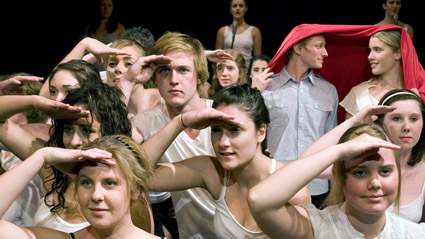
First Year Students, University of Wollongong, performing Park Young-Hee’s Finding Love
photo Derek Kreckler
First Year Students, University of Wollongong, performing Park Young-Hee’s Finding Love
PROFESSOR SARAH MILLER IS HEAD OF THE SCHOOL OF MUSIC AND DRAMA IN THE FACULTY OF CREATIVE ARTS AT THE UNIVERSITY OF WOLLONGONG ON NSW’S SOUTH COAST. REGIONAL UNIVERSITIES FACE MANY MORE CHALLENGES THAN THEIR WEALTHY CAPITAL CITY COUNTERPARTS BUT MILLER REVEALS HOW A SMALL SCHOOL IS BUILDING NEW DEGREES RESPONSIVE TO STUDENT NEEDS IN THE RAPIDLY TRANSFORMING WORLD OF THE PERFORMING ARTS AND FURTHERING CREATIVE PRACTICE AS RESEARCH.
the multidisciplinary context
With two decades of experience as director of Sydney’s Performance Space and Perth’s PICA (Perth Institute for Contemporary Arts), Sarah Miller is a vigorous supporter of multidisciplinary programming and interdisciplinary practices. The University of Wollongong’s Creative Arts Faculty offers a rich multidisciplinary context for creative scholarship in its embrace of Visual Arts, Graphic Design, Media Arts and Digital Media; Journalism, Creative and Professional Writing; and Performance and Sound-Composition & Music Production. Undergraduate students largely work within one discipline but there are opportunities for productive cross-overs: “I wouldn’t describe the faculty as interdisciplinary as such but there is the potential because a number of disciplines are co-located so that when you get to Honours, for instance, that cohort is ‘in the same room’.”
interdisciplinary opportunities
One area where interdisciplinary work can be pursued at undergraduate level is the Dean’s Scholars Program: “Students with a very high standard can do a double major. It’s a mediated program and they have to maintain distinction standard.” A small number of students are taken into the program, combining for example, says Miller, “theatre and creative writing.”
independent learners, transferable skills
The faculty’s drama school comprises Miller and four other staff members: theatre lecturers Tim Maddock, Janys Hayes, Lotte Latekefu who teaches singing and Margaret Hamilton who teaches dramaturgy plus “casuals who come in to teach skills—voice, movement and technical and production management. Visiting directors work on our end of semester productions as Theatre Fellows. They are professionals we know and love who give the students a breadth of experience which is really important.” As to her vision for her students, Miller explains, “What I saw was in line with my own experience and I wanted to more clearly articulate it: the idea of the self-producing artist, self-reliant, capable across a range of areas, with the good training that certainly was never available when I was a student [laughs]—I used to run around town trying to find classes to do!
“We’re aiming for a coherent training program which, of course involves repetition, and then there’s the university’s academic requirements. The theorist Lesley Stern said to me once, ‘The last thing the world needs is another dumb actor.’ I do take that on board—as in any creative arts area, how many graduates will become practitioners? They have to have the best training you can provide but they also need other options—to be really independent learners, capable of critical thought, with skills that are transferable, and it’s important that they’re not passive.”
skills, performance, dramaturgy
Miller described the principal ingredients of the current Bachelor of Creative Arts, Theatre degree: “There are three streams: skills development in acting, singing, voice and movement; a production every semester; and dramaturgy—a very rigorous course in the theory and history of theatre. Now I’m back in a university I have returned to history as something that is critically important. And training in research skills for different career pathways is embedded in the courses.”
Miller explains that “there is also a very small technical production cohort within the acting course. Frank Mainoo is an acting graduate working in this area as well as in his own work and with the performance group Team Mess.” (Team Mess emerged from the Creative Arts Faculty. Mainoo is appearing in the Brisbane Festival’s Under the Radar program with Sydney performance maker Jeff Stein). “The designer Robert Cousins is teaching the production students design this year and they all—to a greater or lesser degree—study lighting. Tanya Leach from Sydney Theatre Company taught stage management last semester. It’s important the students have contact with working professionals.”
As to how a spirit of independence is engendered, Miller says her staff are very good at developing a strong student cohort. Self-animation is the spirit of the school and of necessity—it’s a not a wealthy faculty. There’s an expectation from the very outset that while the students are supported that the shows will have to be self-reliant, and ‘make a buck’—but not a big profit.” As well as performing, students do front of house, bump-ins and help with publicity.
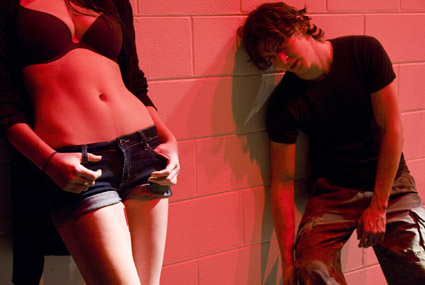
Second Year University of Wollongong students perform Fassbinder’s Pre-Paradise Sorry Now, directed by Chris Ryan
photo Derek Kreckler
Second Year University of Wollongong students perform Fassbinder’s Pre-Paradise Sorry Now, directed by Chris Ryan
making their own work
“They also have the unusual opportunity—and Tim and I feel it’s generally beneficial—to make their own work, albeit within tight parameters. It’s done on a competitive proposal basis and usually in 2nd and 3rd year. However, Jackson Davis wrote and directed Fire Moves Away (mentored by Theatre Fellow Chris Ryan) at the end of his first year, and showed it in the first weeks of 2nd year. It was so successful it went to the Hue Festival in Vietnam (facilitated by staff member Janys Hayes). Jackson is a Dean’s Scholar and one of the students combining Theatre and Creative Writing.”
the text-based/devised balance
Miller thinks the variety of approaches staff bring with them important for student flexibility. Chris Ryan (ex-Sydney Front and director of shows for PACT Youth Theatre) and Tim Maddock (Brink Theatre Company, Sydney Theatre Company, Griffin Theatre Company) “direct very differently but there has been no schism beween text-based and devised work, such as has happened elsewhere. This has been profoundly important.” She adds that through Margaret Hamilton students are incredibly well informed about the range of contemporary theatre and performance.
As well as Chris Ryan, the faculty has attracted a large number of theatre and contemporary performance professionals to work with students, including Deborah Pollard, Carlos Gomes, Geordie Brookman, Regina Heilmann, Tessa Leong, Drew Fairley and Mark Haslam. Miller is attentive to the need to balance text-based with devised works for production, noting as well that “some students just want to be actors and others almost from the outset want to make work. We need to open up the range of possibilities.”
Miller was particularly impressed with Korean performer Park Young-Hee’s Finding Love. Park came as a Theatre Fellow via Latt Children’s Theatre on the recommendation of director Roger Rynd [whose death on June 14 in Seoul is sadly noted. Ed]. “She directed and taught first years in their first 2009 semester, giving them a physical discipline and a sense of cultural difference from the very beginning.”
making connections
The faculty’s relationship with the organisations and venues outside the university is also important to Miller. Staff bring their connections and students have appeared in Performance Space’s NightTime series, have belonged to PACT’s Impact ensemble or appeared in the Tiny Stadiums Festival where the Appelspiel Collective created a model of the Erskineville village. Recent graduates have formed performance groups Team Mess and Tiger Two Times and actress Claire Bowen appeared in Geordie Brookman’s production of Spring Awakening, the musical, for the Sydney Theatre Company and in David Field’s film, The Combination.
As an integral part of their degree, undergraduates perform in their first year within the university in the faculty’s black box 86-seater, while their 2nd year productions are staged at the Illawarra Performing Arts Centre’s [IPAC] Gordon Theatre both semesters. The 3rd year graduating productions are shown at the PACT Theatre in Sydney and the Graduate Showcase is presented at Belvoir Street Downstairs. All the faculty’s shows are publicised widely within the university and beyond.
the new bachelor of performance
Miller is excited about the new degree: “From 2011 we’ll still have the Bachelor of Arts, Theatre and a new Bachelor of Performance. These will match the needs of different kinds of students. The Bachelor of Performance has two streams: one is acting and the other is performance making. There’s a common first year shared with the BCA Theatre students before decisions are taken about which pathway students might follow. In the first year there are common foundation subjects, then an introduction to stagecraft, one performance-focused and around the body and the other technical. As well there are skills training in acting, singing, voice and movement for performance focused students or subjects introducing stage management and the fundamentals of lighting and sound for students wishing to major in technical theatre production.
“After 18 months, the actors in the Bachelor of Performance continue actor training while the performance-makers pick up other areas of practice, different performative modes, installation and also directing—more specialisation, but no minors and only two electives, although performance-making students may choose to do a minor in technical theatre production.
“The Bachelor of Performance is designed to be the intensive course and the BCA Theatre degree more flexible,” Miller explains. “In a BCA you could do a major in theatre and a minor in technical production, or two minors—technical production and media arts or creative writing. It recognises the new emergent practitioner who plays in a lot of areas. BCA Theatre is about multidisciplinary flexibility.” Miller adds, “The production course will become a major in the BCA in 2012.”
Fortunately for a pressed Miller, who is also Program Co-ordinator for Music and Drama, “We have a new building with a rehearsal facility—two spaces to put people in—nothing flash but very functional.”
creative postgraduates
“Postgraduate study is a growth area,” says Miller. “We’ve had Masters and PhD students before but now we have increasing interest from mid-career and senior artists. It’s come about because of the classic need for artists within universities to get qualifications, or to reflect on one’s practice, or to seek structure and resources.” Wollongong offers a rare opportunity in NSW to do practice-based research in theatre. Miller says there’s also been a growth in the number of Honours students: “Mark Rogers is writing about the work of director Benedict Andrews and directing productions of plays by playwrights like Howard Barker and Marius von Mayenburg; Nathan Harrison is writing about Sydney performance group, version 1.0, which is arguably seminal research about Australian theatre practitioners.” The BCA Honours degree comprises 50% creative work and a minor thesis of 15,000 words—honestly, very demanding.” Honours students might then go on to a PhD. Artists undertaking Master of Arts by Research in the faculty include significant players in Sydney’s performance scene, Karen Therese and Victoria Hunt.
The Doctorate of Creative Arts is for artists with a high level of professional experience and a substantial body of practice. Current candidates include performance makers Deborah Pollard and Nikki Heywood. Miller says, “they exemplify the required ‘high level of artist achievement’ with longevity of practice and extraordinary maturity. I think it’s exciting for them. To prepare them and others, Professor Diana Wood Conroy has set up the Senior Artists’ Research Forum [SARF] which is a DCA-focused, intensive senior artists study program, supporting them in research methodologies training. There are fortnightly meetings with staff and other postgraduates for a semester and a half and then they go into the DCA proper. This is really helpful because it can be hard to come back into the university structure.”
With the imminent arrival of the Faculty of Creative Arts’ Bachelor of Performance at the University of Wollongong, we can look forward to the recognition of contemporary performance not only as a rich field of artistic endeavour and achievement in its own right, but as part of the great spectrum of performance that entails much else, including what we have traditionally understood as acting and theatre. That this extends to creative doctorates and the faculty and its students’ and graduates’ engangement with the world beyond the university, makes it all the more exciting.
Faculty of Creative Arts, University of Wollongong, NSW; http://www.uow.edu.au/crearts/index.html
RealTime issue #98 Aug-Sept 2010 pg. 2
© Keith Gallasch; for permission to reproduce apply to realtime@realtimearts.net
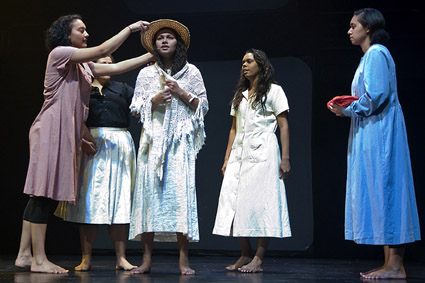
Rosie Fatnowna, Sharni McDermott, Teiya-Lee Gallienne, Elena Wangurra, Kaylah Tyson, Q150 and Long Before; Aboriginal Centre for the Performing Arts
photo Bain Stewart
Rosie Fatnowna, Sharni McDermott, Teiya-Lee Gallienne, Elena Wangurra, Kaylah Tyson, Q150 and Long Before; Aboriginal Centre for the Performing Arts
IT MAY ONLY BE AN ONLINE PROMO, BUT THE SELECTION OF COMMENTS FROM STUDENTS AT BRISBANE’S ABORIGINAL CENTRE FOR THE PERFORMING ARTS (ACPA) SAYS MUCH ABOUT HOW IT DIFFERS FROM NIDA, WAAPA OR EVEN NAISDA. “IT’S A SAFE ENVIRONMENT FOR MY PASSION”; “IT FEELS LIKE LEARNING IN OUR OWN COMMUNITY”; “THERE’S NEVER ANY SHAME HERE”; AND “I’M BECOMING MORE CULTURALLY STRONG IN MYSELF.”
For these Indigenous kids—almost half of whom are from regional Queensland rather than the cities—it’s not all about learning to sing, play music, dance or act in public; though that’s what they desperately want to do. It’s about connecting with their culture while preparing to get out there and compete in the entertainment mainstream. And though there aren’t yet any students from remote areas, and some have blond hair and blue eyes, they’re all singing from the same songsheet—which, when I was there, happened to be a number called “Black is the place I’m in.”
As such, the centre is part of the Queensland state government’s Indigenous Arts Strategy 2009—surely the first in the country; and with a $12million investment in things like the Cairns Indigenous Art Fair, the Queensland Indigenous Arts Marketing & Export Agency, the Saltwater Indigenous Film Festival and a network of 18 Indigenous Knowledge Centres, the most generous. Ironic that this was the state that worked most assiduously to ‘disperse’ its native peoples as far from their own country as possible; and I’m using the word disperse advisedly, in both its natural and euphemistic meanings—the latter disguising a massacre.
Given that such a turn-around in the State of Origin would likely be trumpeted until maroon in the face, why do we know so little about ACPA? One reason is that we’re still in thrall to the brilliant beginnings of NAISDA—spawning the Aboriginal & Islander Dance Theatre, Bangarra etc. In comparison ACPA has had a smaller and much more fraught start to life.
Michael Leslie—the recent Red Ochre winner for a lifetime of such efforts—founded ACPA in 1997. But it almost faded away a couple of times before a beefed up board of directors and two serious arts players came on the scene just two years ago. The board is now 50% Indigenous, and Chris Mangin, ex-Australia Council and the long time CEO of the Queensland Opera is there too. They brought in Milos Miladinovic as CEO, who simply said, “I wanted to feel proud of what I was doing” when I asked whether this was a step down from managing major venues such as The Edge in Auckland and the Victorian Arts Centre in Melbourne. “I’d come to the conclusion that I didn’t really like big musicals any longer!”
Miladinovic brought in Leah Purcell as Artistic Director—but only after she’d said no three times. However good the other artform teachers, the students needed an Indigenous role model—and who better than a film star, writer, director and stage actor who was also an ACPA alumnus, as was Ursula Yovich.
Can one suggest that the range of arts disciplines offered by ACPA is a factor in producing high individual levels of confidence; while NAISDA’s specialisation in dance has produced more corporate success. Penny Mullen, Head of Dance at ACPA, arrived in 2003 when class numbers were down to around five. But today she confidently compares ACPA with its rival NAISDA.
ACPA has always insisted on being centrally placed in Brisbane—as close to its South Bank arts activity as possible. The result is trainee and performing relationships with QPAC, Expressions Dance Company, the Brisbane Festival and La Boite Theatre. As a result, though, they’re in a condemned building at the moment and the hosted accommodation that’s essential for country kids is way out in the burbs at Beenleigh. Miladinovic reports, however, that a big, riverside building in West End is poised to come their way for the next five years—big enough to offer accommodation as well as teaching and administration. After that the State’s commitment will extend to a purpose-designed building, thanks to their assiduous massaging of what Chris Mangin describes as “the delicate balance of carrying the government forward with our dreams of the future.”
Ever-greedy, Miladinovic, would also like to head for Cairns—the State’s official Indigenous arts hub, where his students will be performing as part of the Indigenous Art Fair this year. There he could bring remote Aboriginal and Islander students into the fold. And if that works—why not go national?
They’re going international in September on an exchange with an Indigenous training college in Brazil. And because Leah Purcell has suffered family problems this year (which also caused her to pull out of playing Cordelia to John Bell’s Lear), the American director Stephen Helper is adding some Broadway glitz to the ACPA show at QPAC in August, which comes in two parts, Soul Music (the musical) and Souls Entwined (the dance, choreographed by Gina Rings and a team from Expressions).
The pattern of education that leads up to shows like this is the Certificate III cross-artform entry level, when it’s asked, ‘are they going to commit?’—as 75% of this year’s expanded number of 35 new students have so far. This compares to ACPA’s historic number of 85% completions—which is good compared to TAFE figures. Certificate IV is a change of pace and discipline for students—“a huge leap, but still cross-artform. If they make it through that, the Diploma is specialist, and suddenly they’re performers,” marvels the CEO. “There was Teiya [Teiya-Lee Gallienne], head down, hidden by hair for two years; then, overnight we discovered an actor and a singer in our midst!”.
Chris Mangin believes this sort of achievement more than justifies the two years he and Chair Denise Andrews put in ‘hands-on’ to save ACPA. “The history of training opportunities for young Aborigines is not marked by success. Yet it’s clear there’s a whole range of them with significant performing and writing skills. We have to marshal those skills and put them in front of a public—and it might lead to future employment.”
Long-term, Milos Miladinovic sees his main challenge as replacing himself with an Indigenous administrator. “Everything I see about mainstream courses is antithetical to keeping Aboriginal students on board; a 4,000-student environment is so far from their family and culture. Here, even if they don’t make professional performers, they’re able to go back into their communities as leaders; and maybe that’s where I’ll find my replacement arts administrator in time.”
The QPAC presentation of the Aboriginal Centre for the Performing Arts’ Soul Music/Souls Entwined has eight performances Aug 4-7; www.qpac.com.au/event/ACPAA_Entwined_10.aspx; www.acpa.net.au
RealTime issue #98 Aug-Sept 2010 pg. 4
© Jeremy Eccles; for permission to reproduce apply to realtime@realtimearts.net
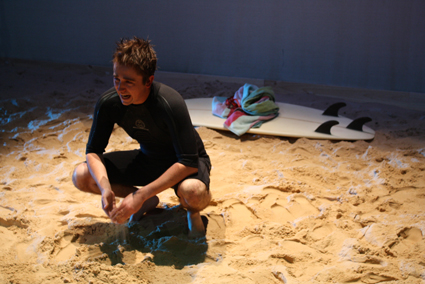
Dean Blackford, Blackrock, Tantrum Theatre
photo Tom Potter
Dean Blackford, Blackrock, Tantrum Theatre
WHEN MY FAMILY MOVED FROM CANADA TO AUSTRALIA IN 1990 WE WONDERED WHERE ON EARTH WE HAD LANDED. THE NEWCASTLE HERALD SEEMED TO REPORT ONLY TWO EVENTS: THE NEWCASTLE EARTHQUAKE (DECEMBER 1989) AND THE MURDER OF LEIGH LEIGH (NOVEMBER 1989).
Recently I had a chance to revisit the latter when I went to see Tantrum Theatre’s new production of Nick Enright’s play Blackrock. Enright first wrote the play Property of the Clan for Freewheels theatre-in-education company in 1992 before redrafting it as Blackrock for the Sydney Theatre Company in 1995. You might also have seen the 1997 movie directed by Steven Vidler. The Tantrum production is essentially the 1995 version, albeit with a few minor updates to include references to champion surfer Layne Beachley instead of Wendy Botha.
As we enter the space, a theatre with roughly 200 steeply raked seats, we see a trapezoidal stage covered in sand. Depending on the lighting (John Zeder), it looks like a beach, a bumpy relief map or a lumpy living room carpet. In the centre there’s a surfboard while up to the left a boy sits on a scaffold, dangling his legs. It’s Jared, enjoying the scenery before his cousin Cherie comes to pester him for a surfing lesson. From here, Blackrock follows a fairly classical narrative structure of exposition, complication, crisis and resolution. In the expository stages, we meet Jared, his mother Diane, his girlfriend Rachel and her family. We also meet his other ‘family,’ the surfing community at Blackrock. When their paterfamilias, Ricko, returns from some sort of safari, a party is in order. During the party, which is low on adults and high on alcohol, a girl named Tracy Warner is raped and murdered. The remainder of the play deals with the aftermath.
Sociologist Kai Erikson argues that trauma has both a centripetal and a centrifugal force within a community (A New Species of Trouble, WW Norton, 1994). On the one hand, it can cause existing divisions to widen. In Blackrock, the community splits along lines of class (the middle class perpetrator has access to a proper lawyer, the two working class accused are presumably left to Legal Aid), gender (the girls are deeply upset, the boys attempt to carry on as usual) and generation (neither the parents nor their children can comprehend each other’s actions and reactions). On the other hand, trauma can also cause communities to band together. This occurs in Blackrock to ethically ambiguous effect: in their efforts to comfort and reassure one another, the young men are soon colluding, coming up with alibis and agreeing to back each other up.
Director Brendan O’Connell draws subtle and nuanced performances from almost all of his cast. The young women effectively portray the febrile and slightly hysterical emotion of teenagers: they sob, stalk, whimper and sometimes shout. Brittany Turner is an endearing Cherie, making light work of monologues that are often tortured in drama classes. Likewise, Sarah Coffee is suitably highly-strung as Tiffany and Rachel Jackett is disarmingly low key as Rachel. The young men in the cast also manage to convey the excitement, terror and inarticulate rage their characters feel. Dean Blackford is especially sympathetic as Jared. The adults are also good: Karen Lantry deserves a special mention for her portrayal of Jared’s mother, who emerges as tough but tender, as does Cheryl Sovechles for her depiction of her vivacious sister Glenys. The characters’ moods are ably amplified by Kieran Norman’s sound design and Zackari Watt’s compositions: arguments are underscored by dissonance, points of shock by staccato notes and the music speeds up and slows down with the dialogue.
In the final scene, Jared finally cracks and admits that he saw the entire incident but did not go to Tracy’s aid. It is a melodramatic and somewhat problematic moment. For the character, it is the moment of confession, remorse and regret for his part in this moral mess. For the audience, however, it functions as a sort of reveal, as we finally find out what actually happened. In this sense, the play provides its spectators with a sense of closure that the community itself has never and probably can never experience.
“No one has ever worked through an injury without repeating it,” writes Judith Butler, “[t]here is not possibility of not repeating. The only question that remains is: How will that repetition occur, at what site…and with what pain or promise?” (Excitable Speech, Routledge, 1997). What, then, is the point and purpose of restaging Blackrock 20 years after the events that inspired it? For a young director, perhaps it is a chance to test himself against an Australian classic. Indeed, it is a chance to test the classic itself. For spectators who, like me, were there when the events transpired, the performance provides us with the time and space to do memory work, to wonder if that’s how it really happened and think about what has transpired in the interim. Finally, for the young actors themselves, performing in Blackrock might be likened to one of the play’s many initiation ceremonies (Toby turning 18, his sister Rachel dating her first boyfriend, and his mother writing on Indigenous initiations). To perform in Blackrock is to be initiated into Newcastle’s history, to learn that along with the mines and the beaches, the death of Leigh Leigh too is your ambivalent inheritance.
Tantrum Theatre, Blackrock, writer Nick Enright, director, designer Brendan O’Connell, performers Rod Ansell, Dean Blackford, Sarah Coffee, Ben Freeman, Erika Gelzinnis, Cordelia Hamilton-Russell, Steffen Hesping, Rachel Hackett, Dean Johnson, Karen Lantry, Bradley McDonald, Cheryl Sovechles, Brittany Turner, Daniel Yaxley, lighting designer John Zeder, composer Zackari Watt, sound designer Kieran Norman; The Playhouse, Civic Theatre, Newcastle, May 13-22, www.tantrumtheatre.org.au
RealTime issue #98 Aug-Sept 2010 pg. 6
© Caroline Wake; for permission to reproduce apply to realtime@realtimearts.net
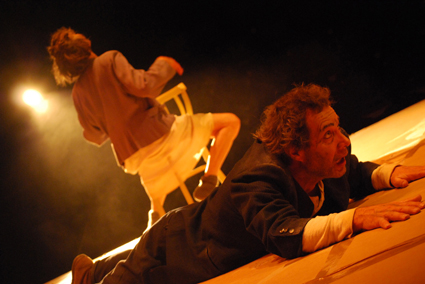
Eugene Gilfedder, Jennifer Flowers, The Chairs, La Boite
photo Al Caeiro
Eugene Gilfedder, Jennifer Flowers, The Chairs, La Boite
OF LATE THERE HAS BEEN AN ALMOST OBSESSIVE REVIVAL OF INTEREST IN THE WORKS OF ROMANIAN-BORN, FRENCH PLAYWRIGHT EUGENE IONESCO, WHO WROTE IN THE SHADOW OF THE HOLOCAUST AND WHOSE WORK REFLECTED THE IDEOLOGICAL TENSIONS OF THE COLD WAR. IT’S TEMPTING TO ATTRIBUTE THIS TO AN AWARENESS OF THE TOTAL CORRUPTION OF OUR LANGUAGE INTO A MORASS OF MANAGERIAL, MARKETING AND CORPORATE SPIN ANALOGOUS TO THE STRONG LINKS IONESCO MAKES BETWEEN LANGUAGE AND THE EMPTINESS OF POWER.
Is our world with its dying seas and asphyxiating atmosphere a fitting setting for the sort of tragic farce which was Ionesco’s chosen metier as a playwright? Is Ionesco our contemporary or is his 1952 play The Chairs just a vehicle for bravura performances, in this case, from Eugene Gilfedder as the Old Man and Jennifer Flowers as the Old Woman who confront the predicament of old age and old habits with a mounting fine edge of rage in Gilfedder’s case, and Flowers with a sly defiance of time that seizes every moment to flirt with the audience.
Ionesco comes to us cloaked in the guise of so-called Theatre of the Absurd. Now the spotlight has been turned on his case in an intelligent, scrupulously realised rendition of this small masterpiece for La Boite in Brisbane. Director Brian Lucas restores Ionesco as the legitimate heir of Feydeau combining an outrageous, surreal sensibility which Ionesco applies with a rationale that, far from being absurd, is, on the contrary, remorselessly logical in the way of clowns. Gilfedder greets an old flame with the declaration that she is as beautiful as ever, while noting the fact that she is going bald. He puncuates the arrival of a high plenipotentiary (God?) by barking like an excited dog. Flowers’ performance achieves the purest heights of comic burlesque when she mimes an act of seduction in her role as dessicated coquette.
Ionesco tells us that his plays have their origins in two basic states of consciousness, “an awareness of evanescence and of solidity, of emptiness and of too much presence.” He sets up an isomorphic resonance in The Chairs between these two qualities to which Brian Lucas seems acutely attuned from the evidence of his own solo works in dance theatre with their intricately crafted visual and kinetic elements and deep concerns with life’s ephemerality and the validity of language. Lucas’s treatment, too, has the light touch which renders his own work so accessible. It may be profound, it may be crazy, you take it or leave it. It illuminated the fact that, for me, Lucas’s own chosen metier is tragic farce, especially his 2010 show, Performance Anxiety (RT96, p30). As a dancer and choreographer, Lucas expressed surprise that he had been asked to direct Ionesco’s classic, but this was a joyful match especially considering that in later life Ionesco turned his attention to dance as a realm to express his ideas.
Through carefully plotted stagecraft, the play makes complex use of presence and absence, but this does not amount, despite Ionesco’s references to the Void, to a metaphysical statement. Integral to his purposes in theatre is the stage design where Bruce McKinven accommodates Ionesco’s stipulations, including symetrically arranged doors in the rear for exits and entrances as in a Feydeau farce. At a significant moment, double doors open onto a blazing wall of light signifying the Void backstage. However, this is a solidly spatial metaphor. Two ladders lead to high windows set on either side of what will eventually emerge as a replica, albeit shabbier, auditorium onstage. Two chairs face downstage.
The Old Man is atop one of the ladders as the play begins, apparently delighting in an ocean vista. When the Old Woman acidly remarks that it is too dark to see, he complains that it wasn’t like that in the old days when it was always light. Their fractious, co-dependent relationship is rapidly established through a series of verbal Punch and Judy cross-purpose conversational gambits while he sits on her lap indulging in a conscious abandonment to self-pity, partly triggered by her lamentations about his wasted talents.
To divert him, the Old Woman initiates a game they have obviously played before. Having rocked him on her knee while singing a soothing lullaby, she introduces the comforting topic of his important message to the world. Reaffirmed, the Old Man resumes his chair and begins to manifest a new, confident personality, a fictional self. He has moved, in his imagination at least, beyond his lowly status as a “master of the mop and bucket.” They sit in silence, momentarily taking on the image of members of an audience in expectation of a performance.
The Old Woman attempts to wind down the game by suggesting they are too tired and should cancel the evening’s performance when the doorbell rings. Startled into febrile activity, they rush to answer it and reappear, escorting and seating onstage an invisible guest with whom they exchange social banalities. From here on the action frenetically escalates into a vaudevillean tour de force. Guests continue to arrive, the Old Man frantically greeting them and the Old Woman struggling to produce chairs for them all. Comic vignettes of social intercourse grind to a halt as the reality of the old couple is overwhelmed onstage by these invisible presences, and they are separated and squeezed to the margins by this new audience-in-waiting. Eventually the Orator (Dan Crestani) who will deliver the Old Man’s message appears as a real, oleaginous, neo-Fascist figure—to the dismay of the Old Woman, she has to touch him to pronounce him “real flesh and blood”—but he studiously ignores the old couple.
Their make-believe mission apparently accomplished, the couple have no choice but to finish the game by committing suicide, somersaulting backwards from their separate perches on the windows into the sea. Faced with the expectations of the real audience in the auditorium merged with those of the invisible audience onstage (all conventional stage boundaries have now dissolved), the Orator struggles to deliver his non-existent message, finally abandoning the attempt and leaving the real audience to contemplate the possibility of their own disappearance into the indelible image created onstage.
Ionesco is gently asking to what extent we avoid interacting with the sheer crazy wonder of life by grounding existence in our own and other people’s fictions, including the theatre’s. If the messengers fail us, we must jump without a parachute into a void of unknowing. After Copenhagen, we must work out our own salvation, and the salvation of the planet. As Ionesco puts it, “Ideology is not the source of art. A work of art is the source and the raw material of ideologies to come.” Judging by the shared smiles tokening a renewed awareness of the unbearable lightness of being, the audience ‘got it.’ This seriously funny production validated Ionesco as a man for our time.
La Boite, The Chairs, writer Eugene Ionesco, translator Martin Crimp, director Brian Lucas, performers Dan Crestani, Jennifer Flowers, Eugene Gilfedder, designer Bruce McKinven, lighting designer Carolyn Emerson, sound designer Brett Collery; Round House Theatre, Brisbane, Jun 5–Jul 4
RealTime issue #98 Aug-Sept 2010 pg. 8
© Douglas Leonard; for permission to reproduce apply to realtime@realtimearts.net
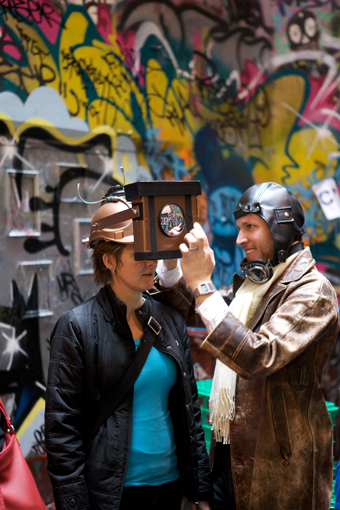
participant, Tim Webster, In Periscope
photo Bonnie Savage
participant, Tim Webster, In Periscope
THE NOTION THAT ART AFFORDS US FRESH PERSPECTIVES ON THE FAMILIAR IS SOMETHING OF AN EMPTY PLATITUDE; HOW OFTEN DO WE REALLY FIND OURSELVES CHALLENGED AS OPPOSED TO ASCRIBING ORIGINALITY AND INSIGHT TO SOMETHING WHICH MERELY CONFIRMS OUR OWN VIEW ON THE WORLD? EVEN THE FRAMES WE PLACE AROUND ‘ART’—AS OPPOSED TO ITS OTHERS—ARE DEPENDENT ON WHAT WE CHOOSE TO SEE AND WHAT WE HOPE WILL REMAIN ABSENT FROM OUR CONSCIOUSNESS.
in periscope
It was a right old surprise, then, to recently experience a tiny and very humble work of live art that literally shifted the frame. In Periscope was the ingenious creation of Tim Webster in collaboration with Sarah Rodigari and presented its handful of participants with a gentle yet effective physical and visual encounter with the city.
Upon arrival in a Melbourne laneway we were fitted with a curious piece of headgear—a steampunk-esque helmet held together with brass-painted screws and wires and with a large, rectangular face covering. When lowered it blocked all but the most peripheral of our vision but soon a panel was removed and a square of light appeared. The contraption was a periscope of sorts, presenting a magnified view of whatever lay directly above us. For the next 20 minutes we were guided around a city now only available to us in a strangely upended and abstracted way.
But as with most art that deserves the title, a description of the process doesn’t do justice to the experience. The effect of this periscope is an embodied one—it produces a sense of immediacy and alienation that goes beyond the conceptual. Moreover, it’s not the same as simply looking up while wandering the streets. The device framing our vision produces a screen rather than window on our environment and a distinct sense of dislocation results: the experience of our physical bodies moving through the urban space doesn’t correlate with the cool, distant flow of flattened architectural forms unfolding before our eyes.
As an experiment in live art making, In Periscope was subtle yet enthralling, much like last year’s En Route by Bettybooke (RT94). It produced that transfigured way of seeing so rarely found in art, yet did so in a modest and understated manner. It seems likely to me that this kind of achievement is more often realised in non-text-based work, but while the field of live art frequently shuns texts there are examples of more traditional theatre which still hold out hope for the transfigurative perspectives of the form.
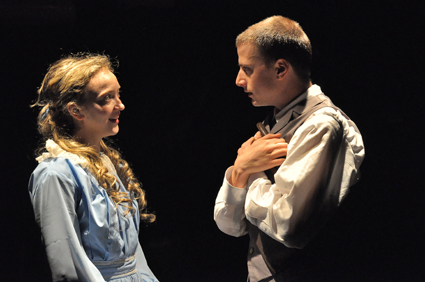
Amanda Falson, Thomas Conroy, Something Natural but Very Childish, Dirty Pretty Theatre
photo Joe Calleri
Amanda Falson, Thomas Conroy, Something Natural but Very Childish, Dirty Pretty Theatre
something natural but very childish
Director Gary Abrahams’ first outing of 2010 was a literary adaptation—Acts of Deceit (Between Strangers in a Room), after James Baldwin’s novel Giovanni’s Room. There Abrahams proved himself keenly adept at drawing out the emotional intricacies of a literary work and using them to shape a compelling stage drama. His second work for the year, Something Natural But Very Childish, extended this same process to a selection of short works by Katherine Mansfield.
What makes Abrahams’ works this year stand out so sharply is an aesthetic commitment to something deeply unfashionable in contemporary performance: the romantic. They are almost anachronisms in this regard, treating the sentimental with a degree of seriousness that is slightly unsettling in an age of irony and self-reflexivity. They’re far from kitsch, however. Rather, they overlay a vaguely hysterical kind of heightened emotion onto the rich and resonant themes of his source material; at the same time, they never revert to camp parody. Where there is excess, it seems designed to reproduce the sense of giddy intoxication one experiences when drawn into a lush, imaginative literary world. The director’s success is in reawakening the possibility of a post-ironic theatre that is anything but falsely naïve.
slut
Playwright Patricia Cornelius works within this frame, as well. Her play Do Not Go Gentle… has been a much-feted fabulation of aging and loss, but her short work Slut is an excellent introduction to the surgical skill with which she employs familiar theatrical conventions to deliver the unfamiliar.
Slut was commissioned by Platform Youth Theatre as part of a double bill two years ago; I still recall that performance as the result of a key monologue which arrives near the work’s conclusion. I was eager to see whether my memory of the text’s excellence would hold up to a second production.
Verve Studios’ new version is more confident than the original, perhaps the result of the slighter older casting. The work itself is chilling, inspired by the murder of a woman by her boyfriend on a Melbourne street several years ago. At the time, media coverage focused on the tragic death of a passer-by who attempted to stop the violence, while sneeringly referring to the female victim as a ‘partygirl’ who came to an unsurprising end. This is both the origin and destination for Cornelius’ attempt to make sense of the event.
Her script traces the history of a woman who since puberty has been defined by sexuality; crucially, this history is largely revealed through the breathless commentary of two schoolmates who narrate the decade leading to the eventual murder. It is only late in the work that it becomes apparent that the figure at the play’s centre is mostly without voice herself or, when she speaks, it is in the language of those who are shaping her identity. That brief monologue in which she does find her tongue is still wracking—her assertion that she’d never been permitted to want or dream of anything beyond her immediate circumstances is a confronting one in a space, the theatre, where dreaming of that which isn’t the case defines the very essence of an audience.
weekend
The period in which Jean-Luc Godard created his notorious film Week End (1967) was one in which he, too, was grappling with the position of the spectator in relation to his practice. Having moved beyond the formal experimentation of his earlier work, he searched for a politicised cinema that rebelled against the paradigm of audience passivity. While a worthy goal, one of the results was, in the case of Week End, a film intended to alternately outrage and bore its viewer, with endless sequences of cool banter, disjointed title cards and scenes of real animal slaughter.
A recent adaptation of Week End presented at La Mama’s Carlton Courthouse brought different problematics to the stage while equally provoking its onlookers. Most troubling of all was the apparently deliberate obsolescence of the work—performers gleefully artificial, replete with bad accents and hokey props, but just as often playing as if uninterested. This isn’t to say that these performances failed to engage; instead, they seemed calculated to prevent any identification with the increasingly bizarre events occurring on stage.
But if coprophilia, dismemberment and cannibalism are just the stuff of entertainment today, and when invoked must be treated with the same bored contempt deserving of vacuous spectacle, then it’s unclear why a theatrical production would seek to remind us of this fact. Weekend seems a self-defeating production, one that heralds the demise of classical theatre by feasting on the remains. It’s not the only way, I think. Admittedly, though, it’s a pretty damned entertaining one.
Affective Urbanism 3: In Periscope, Tim Webster in collaboration with Sarah Rodigari, helmet design and construction Rob Jan, around Melbourne, May 29-30; Dirty Pretty Theatre, Something Natural But Very Childish, writer, director Gary Abrahams, performers Luke Jacks, Thomas Conroy, Amanda Falson, Luisa Hastings Edge, Josh Price, Zoe Ellerton Ashley, Cameron Moore; La Mama Theatre, June 2-20; Verve Studios, Slut, writer Patricia Cornelius, directors Paola Unger, performers Hayley Birch, Kelly Hynes and Victoria Morgan; The Dog Theatre, June 30-July 17; Weekend, writer Matthew Lambert, director Lynne Ellis, created & designed by Paul Blackman from Jean-Luc Godard’s Week End, performers Sam Sejavka, Francis McMahon, Ben Andrews, Christian Bagin, Imogen Sagel; La Mama Courthouse, Melbourne, June 30-July 18
RealTime issue #98 Aug-Sept 2010 pg. 10
© John Bailey; for permission to reproduce apply to realtime@realtimearts.net
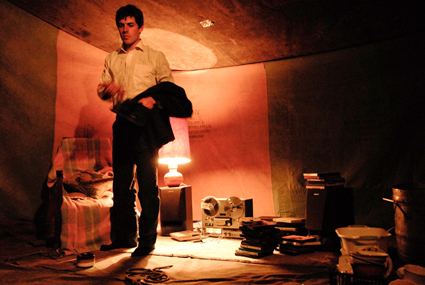
Matt Prest, The Tent
photo Heidrun Löhr
Matt Prest, The Tent
AN IMPORTANT DEVELOPMENT FOR AUSTRALIAN CONTEMPORARY PERFORMANCE IS ABOUT TO BE REALISED. THE MOBILE STATES CONSORTIUM, A STRONG SUPPORTER OF THE FIELD, HAS COMMITTED TO DEDICATING ONE OF ITS TWO ANNUAL TOURS TO A DIVERSE PROGRAM OF SMALL AND MEDIUM SIZED WORKS OVER THREE YEARS, STARTING IN 2010.
an expanding niche
The opportunities for contemporary performance works to travel regionally and cross borders have multiplied in recent years thanks to Mobile States (with sometime support from the federal government’s Playing Australia program), Melbourne’s Arts House, Sydney’s Performance Space, Brisbane Festival’s Under the Radar and a range of opportunities offered by Full Tilt (at the Arts Centre, Melbourne) and Malthouse (both of whom have presented works by Sydney’s My Darling Patricia), Next Wave Festival (see articles by Reck, Karipoff and Warren), Sydney’s Tiny Stadiums, Australia’s international arts and fringe festivals and now regional players like the enterprising Campbelltown Arts Centre, west of Sydney, and Punctum in country Victoria.
Audiences are becoming increasingly familiar with contemporary performance as a regular part of their art diet—indeed as a substantial proportion of it in Arts House’s 2010 Future Tense programs. As with the 2010 Next Wave Festival, Future Tense’s offerings include the latest manifestation in the field—live art’s extensive engagement with site, genres, games, media, science, sensory states and audience interaction.
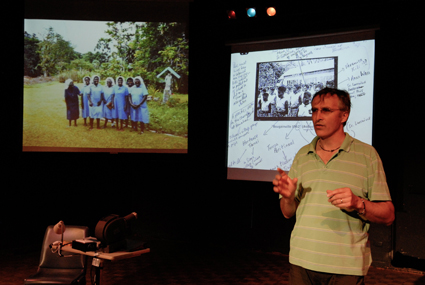
Paul Dwyer, Bouganville Photoplay
photo Heidrun Löhr
Paul Dwyer, Bouganville Photoplay
Mainstream theatre companies are also engaging with contemporary performance. In 2008 Sydney Theatre Company presented De Quincey Co’s embrace: Guilt Frame (RT 83; RT84) and in 2009 performance trio Post were in-residence with the company. Malthouse’s Tower provides a salaried venue for innovative works and Belvoir Street’s B Sharp has programmed Post (Everything I Know About the Financial Crisis in One Hour) and version 1.0 (The Market is Not Functioning Properly) in a forthcoming Downstairs double bill and version 1.0’s The Bougainville Photoplay Project Upstairs. Shutting down its B Sharp theatre program at the end of 2010, Company B seems set to commit to experimentation Downstairs: more room perhaps for contemporary performance to reach a wider audience.
mobile states: track record
Mobile State’s particular interest is “in those artists whose practice is concerned with experimentation, research and the investigation of ideas and form” (Performing Lines website) as demonstrated by its strong track record. It has successfully toured Branch Nebula’s Paradise City, Dancenorth’s Underground, Back to Back’s Small Metal Objects, Lucy Guerin Inc’s Love Me, Tanja Liedtke’s Twelfth Floor, version 1.0’s The Wages of Spin, Chamber Made’s Phobia, de Quincey Company’s Nerve 9, Jenny Kemp’s Still Angela and, most recently, Urban Theatre Project’s The Folding Wife across the country.
The consortium members are Adelaide Festival Centre, Arts House (Melbourne), Brisbane Powerhouse, Performance Space (Sydney), Perth Institute of Contemporary Art (PICA) and Salamanca Arts Centre (Hobart) along with producing member Performing Lines.
modus operandi
I spoke recently with Harley Stumm, a producer for Performing Lines, the agency that produces, develops and tours Australian works of many genres nationally and internationally. He’s a former executive producer for Western Sydney’s Urban Theatre Projects and brings considerable experience to this new initiative which is so clearly responsive to developments in the field.
Asked how Mobile States works, Stumm says, “Performing Lines manages the curatorial process but it’s a presenter-driven model. There were originally five members and now there are six with the Adelaide Festival Centre joining. We receive written proposals and vote on what goes forward. Performing Lines doesn’t have a vote because as a presenter-driven model you can’t vote to make someone put a show on. We participate in the discussions.”
motivation
Asked why Mobile States took on touring “Best New Australian Performance” (Press Release), Stumm explained, “Over the years artists have pitched a half-hour work or an installation for Mobile States and you think it’s a great piece, great to tour. But how? At various times we’ve talked about the idea of putting together a mini-festival to tour a broader spectrum of contemporary performance practice. There are new forms and genres arising but also new formats and new ways for audiences to experience work. So we developed the idea further, putting together a cluster of works to create an event that would build a bit of a vibe around this form of practice, and tendered for the Australia Council Touring Initiative from the Theatre Board. We’ll tour programs of shorter and mid-length works, performance installations, sound installations, audio walks, durational performances. We’ve selected a menu for the first tour of four works: Rosie Dennis’ Fraudulent Behaviour, Fleur Elise Noble’s 2 Dimensional Life of Her, version 1.0’s The Bougainville Photoplay Project and Matt Prest’s The Tent.”
complexities
The term ‘menu’ is apt. Stumm and the consortium had to grapple with the fact that not every venue could take on all the shows: “PICA in Perth has programmed all four works from the menu as a kind of mini-festival whereas other ‘festival-ed out’ presenters have selected certain shows as part of their seasons. Sometimes works have already appeared in a city, so they won’t be selected: The Tent had already done Melbourne.
“We’d initially planned a menu of five shows but we didn’t get Playing Australia touring money so we had to trim back. Then there were venue considerations. All of them have very different spaces—or not enough spaces—and different audiences, different budgets, any number of variables. Like all touring, there’s a group of diverse presenters coming together and working out what they can share and where they can’t compromise their own programming needs. On the other hand, there are benefits in touring to multiple venues—we’ve got four works going to five venues and no two venues have the same package, but there’s very little downtime so it’s still relatively cost effective.”
in darwin
Stumm emphasises that the program “is a group curation. The five works that we originally programmed were all high on most of the presenters’ wish lists.” But Mobile States programs don’t just go to the consortium’s venues: “We’ve toured Tess de Quincey, Branch Nebula and The Folding Wife to Darwin with the Darwin Entertainment Centre. This time the Darwin Festival artistic director Jo Duffy was very keen to look at some smaller works. Paul Dwyer’s The Bougainville Photoplay Project, which is about his father’s New Guinea experiences against the backdrop of Australia’s colonial history in the region, will go on at Brown’s Mart, which is perfect for it—a nice intimate space. Obviously the connection between this work and Darwin’s physical proximity to and historical relationship with Papua New Guinea interested Jo from the beginning.”
In the other work for the Darwin Festival, says Stumm, “Matt Prest’s The Tent will be performed on a strip of land on the waterfront, just down the hill from the CBD, between where they have the open air Deckchair Cinema and the new waterfront redevelopment. In the dry season when the accommodation in Darwin is booked up, all the ferals and grey nomads who’ve hit Darwin and either can’t find a place to stay or don’t want to pay for it, camp illegally in this park. So The Tent will be fantastic there. In The Tent there’s a kind of bush philosopher who’s opted out from the rat race. Matt says ‘The Tent is pitched at the crossroads of sustainability and prolonged adolescence’.”
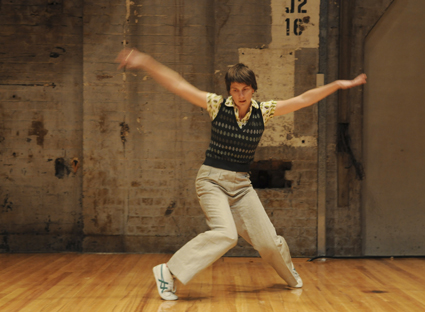
Rosie Dennis, Fraudulent Behaviour
photo Heidrun Löhr
Rosie Dennis, Fraudulent Behaviour
going regional
I ask Stumm about Mobile States’ commitment to regional touring. He replies that it’s not just an ideal, but a practical necessity if funding from Playing Australia is to be secured: “The advice we got from Playing Australia was that there wasn’t any issue with the model for the performance tour. It was simply a matter of regional reach. They have half a dozen selection criteria and so many program objectives. Regional reach is the top priority. So we have to extend our reach. And we want to do that. We have an application in for a stand-alone tour next year and another cluster—a menu of six works with each presenter choosing between two and four.”
Stumm points out that Mobile States has had good regional reach: “With The Folding Wife, we said okay, where’s the Filipino community located in Australia? And the answer is north Queensland and the Northern Territory. So we got that show to Mackay, Townsville, Cairns and Darwin. In the past, we got Branch Nebula’s Paradise City to Cairns and Alice Springs, Dance North’s Underground to NORPA in Lismore and to the Memorial Entertainment Centre in Bathurst.” Stumm says there is strong interest in future package tours from a couple of regional centres that “have a bit of a history of presenting more contemporary, more adventurous work”, but it has to mesh “with their own development programs. Stand-alone tours are definitely easier to sell to regional areas.” But it’s early days and Stumm is optimistic about the future of touring “performance clusters.”
Mobile States continues to be a significant force for promoting contemporary performance in Australia. As Harley Stumm sees it, and you’d have to agree, “the list of works that Mobile States has toured surveys some of the most important contemporary work for the last five years.” The new program of smaller scale works promises to bring far flung Australian audiences right up to date with new works and trends.
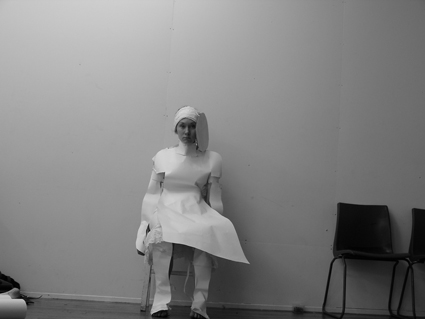
Fleur Elise Noble, The Two-Dimensional Life of Her
the works
Paul Dwyer’s the Bougainville Photoplay is engrossingly informal, musing on a doctor’s life in the 1960s in a brutalised neighbouring culture about which most of us know little. Fleur Elise Noble’s 2 Dimensional Life of Her generates a magical interplay between the artist’s own body and animated and paper sculpted personae telling us much about form, representation and self. So, in another way, does Rosie Dennis’ Fraudulent Behaviour—where a little lie can become a great fiction and you leave bemused, if compelled to reflect on your own white lies and worse. In The Tent, you’ll find yourself in an installation-cum-tent—sharing soup, entranced by puppet dreams and lateral glimpses into the meaning of life. These are works that engage in idiosyncratically different ways of telling and being. It’s wonderful that they’ve been mobilised to embrace a growing audience for new performance.
Mobile States, performance works, see individual venues for shows and times: Arts House, Melbourne, Aug 12-15; Darwin Festival, Aug 18-22; Brisbane Powerhouse, Aug 20-28; PICA, Perth, Sept 2-5; Salamanca Arts Centre, Sept 8-11
RealTime issue #98 Aug-Sept 2010 pg. 12
© Keith Gallasch; for permission to reproduce apply to realtime@realtimearts.net
{$slideshow} IN ACT IV OF EUGENE O’NEILL’S LONG DAY’S JOURNEY INTO NIGHT, EDMUND DRUNKENLY CITES ARTHUR SYMONS’ POPULAR TRANSLATION OF BAUDELAIRE’S PROSE POEM “EPILOGUE”: “WITH HEART AT REST I CLIMBED THE CITADEL’S/ STEEP HEIGHT, AND SAW THE CITY AS FROM A TOWER,/ HOSPITAL, BROTHEL, PRISON AND SUCH HELLS,/ WHERE EVIL COMES UP SOFTLY LIKE A FLOWER.” THE POET’S VIEW OF THE NOCTURNAL METROPOLIS—SEEDY IN ITS MODERN DISCIPLINARY INSTITUTIONS AND TEMPTATIONS—CONFESSES A KIND OF ILLICIT DELIGHT FOR THAT WHICH IS POISONOUSLY DESTRUCTIVE, OR AT THE VERY LEAST, OFFERS A FUTILE SENSE OF RESISTANCE TO THOSE THINGS WHICH, BY THEIR VERY NATURE, MARRY DESIRE WITH DEATH.
O’Neill’s largely autobiographical play, written in 1942 but first published three years after his death in 1956, and in 1957 awarded the Pulitzer Prize for Drama, registers—with durational monumentality—the slow rising of an evil that is both soft and beautiful: a family addicted variously to morphine, whiskey, money and women, but also to their own familial dynamics of intense rage and love. Resurrected by Sydney Theatre Company, directed by Andrew Upton and featuring William Hurt and Robyn Nevin, the work enacts a three-and-a-half hour durée that witnesses both authorial lament and exorcism. The text’s demons are profound; its unfolding excruciating.
Alongside the much younger Tennessee Williams and Arthur Miller, O’Neill has been credited with rendering American realism “true” by realising the gritty vernacular of characters struggling on the edges of institutions, families and themselves: their gestural and vocal rhythms, their cyclical obsessions, their fatalistic bodily and moral corruptions. Edmund (presumed to be the young O’Neill, played by Luke Mullins) is suffering from consumption, a secret he hides from his wretchedly deluded (and morphine-addicted) mother Mary (Nevin). His father James (Hurt) and brother James Jnr (Todd Van Voris) endlessly bait each other and Edmund in rehearsals of contempt and betrayal, in contests over money lost and bitter memories. As in any family, these are set pieces, but here the Tyrones are caught in the thickness of their self-interest over self-effacement, drowning themselves in whiskey to soothe and then re-provoke.
The production design and dramaturgy works, on all levels, to preserve the play’s historicity—its reimagining of the American dream was as much dramaturgical and stylistic as it was philosophical. In this respect, the text’s familial ghosts feel uncomfortably trapped by theatrical and literary ghosts of form instead of being offered a contemporary opening out of the play’s emotional and textural scope. The set (Michael Scott-Mitchell) reads as a truthful replica of modernist architecture, but gives no cue to its reality as a contemporary refashioning of an old idea; there is no self-reflexivity in this kind of resurrection. The house is angular and partial, often swathed in blue light, sinking (or so it feels) amidst the punctuating sound of fog horns (Max Lyandvert), which are moody, but also equally cloyingly illustrative.
The performances cadence to different registers, and each are acts of exceptional mental endurance despite occasional lapses of rhythm when in concert with one another. Hurt’s paternalism is contained and powerful in his quiet (possibly too quiet for some) burning rage, and focuses steadfastly to find a sturdy andante delivery for words that need—with their particular vernacular poetics—to be able to out-perform his own celebrity presence. Nevin’s Mary is jittery and birdlike, a vista of a too-archetypal feminine anti-heroine, irritatingly caught in the image of her own trappings (and those of the era). Mullins and Van Voris are both robust in their delivery; Edmund coughs his chest onto the stage in an arc to slow death, James smothers his boisterous cynicism with the fuzz and fog of drink.
The meta-literary references within the play, such as those by Baudelaire (and countless others), portend the great literary legacy that O’Neill was himself to leave, long after he escaped the family hellhole, and even longer after his death. He dedicates the work to his third wife Carlotta as “a play of old sorrow, written in tears and blood,” with a 25 year moratorium on its production. With the past so strongly haunting the presence of this work, STC’s production is at once compelling and awkward, an incomplete conception of what it is to give due credit to a masterful work that is being experienced in a very different time. There was a certain sense of slow torture in waiting for the play’s death throes to abate, but this was not, I imagine, unlike O’Neill’s own experience of growing up. In this respect, sitting through the long night’s journey into day felt important, possibly rewarding.
Sydney Theatre Company, Long Day’s Journey into Night, writer Eugene O’Neill, director Andrew Upton, actors William Hurt, Robyn Nevin, Todd Van Voris, Luke Mullins, Emily Russell, design Michael Scott-Mitchell, sound Max Lyandvert, costumes Tess Schofield, lighting Nick Schlieper, Sydney Theatre, July 3-Aug 1
RealTime issue #98 Aug-Sept 2010 pg. 14
© Bryoni Trezise; for permission to reproduce apply to realtime@realtimearts.net
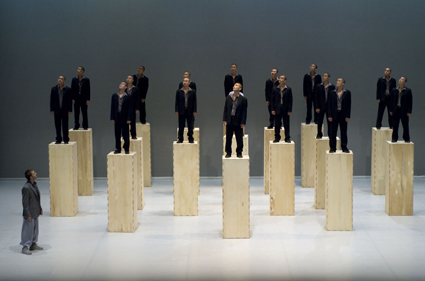
Sutra, Sidi Larbi Cherkaoui and Warrior Monks of the Shaolin Temple, Brisbane Festival
photo Andree Lanthier
Sutra, Sidi Larbi Cherkaoui and Warrior Monks of the Shaolin Temple, Brisbane Festival
NOEL STAUNTON EXPRESSES SOME NERVOUSNESS, IF WITH A CONFIDENT IRISH LILT, ABOUT HIS FIRST BRISBANE FESTIVAL. HE’S ONLY BEEN IN THE POSITION SINCE LATE 2009 AND IS STILL GETTING TO KNOW THE CITY: “I THINK THE PEOPLE OF BRISBANE WANT SOMETHING THEY CAN CALL THEIR OWN. IT’S NOT ABOUT SHOPPING DOWN AT THE ART SUPERMARKET; WE CAN ALL DO THAT. THAT’S WHY WE’RE DOING THE ROAD SHOW ARE WE THERE YET?, CIRCA HAS A SHOW FOR KIDS, WE’RE BUILDING A NEW FESTIVAL THEATRE SPACE AND WE’RE DOING STALKER’S SHANGHAI LADY KILLER WITH CO-PRESENTERS. HOPEFULLY IT’LL DO SOMETHING AND I’LL NOT BE RUN OUT OF TOWN.”
Formerly Executive Director of the Sydney Dance Company, Noel Staunton has worked in the arts for 30 years: as Technical Director of the English National Opera and Opera Australia, as Executive Director of Baz Lurhmann’s company, Baz Live, and Executive Producer of the 2004 South Australian Opera production of Wagner’s The Ring Cycle. An arts festival should come easy.
a new festival venue
When we meet in Sydney to discuss his 2010 program, Staunton commences by describing an initiative of which he’s clearly proud. “When I first visited the Brisbane Powerhouse and saw on approach the huge flat facade, I asked had anyone thought of building an amphitheatre here.” Which is exactly what he’s doing—creating an open air 600-seater called QUT Festival Theatre, ideal for Brisbane Spring when the festival plays. He sees the new venue as providing a base for exciting local work (CIRCA, Raw Dance, Topology, Queensland Theatre Company) and “extending the box office, which in the past was not major. If you pay for it, you’ll respect it, while of course there have to be events that are free. I’m experimenting in terms of the genres I’m putting in this space—circus, theatre, dance, music and opening with a production of Shakespeare’s Macbeth. It’s the first time Marcus Graham has played the role and Michael Gow is directing. It’s trimmed down and it’s all about the language and there’s no set—the wall is the set, it’s the scenery.” Opposite the amphitheatre is “the Milk Crate Lounge, where audience and artists can relax after the show.”
Staunton’s impressed by some of the young Australian talent he’s programmed—better known overseas than here—like percussion-based Raw Dance. Also in the QUT Festival Theatre program are Edinburgh Fringe, hit Melbourne’s Dark Party—“they’re like the Marx Brothers and staple things to their bodies.” In Bounce, Topology and their audience will actually bounce balls off the wall and floor of the theatre to provide patterns to which they’ll play. The ensemble are reworking the UK’s Aphex Twin’s “epic 1997 study in the rhythms of collision, Bucephalus Bouncing Ball, made from the sounds of bouncing ping pong balls” (Press Release).
circa & circa zoo
Also in the QUT Festival Theatre are Brisbane’s Circa Zoo, directed by Ben Knapton, presenting Strange Familiar Angel for children in the afternoon while globe-trotting Circa and artistic director Yaron Lifschitz are staging Wunderkammer, “a cabaret of the senses,” at night for adults. “Wunderkammer is created especially for the space,” says Staunton. The program also includes the music of Brisbane’s Robert Forster. Staunton adds, “What works and doesn’t work will help me plan 2011.”
are we there yet?
Of the 10 free events programmed for the festival, Staunton is particularly exicted by Are We There Yet?, a music theatre road show about people moving to Brisbane from interstate. It will play from a caravan in nine Brisbane suburban parks. Scripted by Scott Witt, it’s another opportunity, Staunton declares, to invest in local artists. It’s a three-year project, while another public series, Backyards (performed in actual backyards), inherited from previous Brisbane Festival artistic director Lyndon Terracini, will have its final outing this year.
stalker, shanghai lady killer
Shanghai Lady Killer from Sydney’s Stalker is eagerly anticipated. Staunton describes it as “a cross between a melodrama and Crouching Tiger, Hidden Dragon and a lot of fun.” Director Rachael Swain and the show’s writer, filmmaker Tony Ayres, have fashioned a contemporary onstage film noir “in the Chinatown of a futuristic Australian city [with] multi-media landscapes, acrobatics, parkour, trampoline, dance, circus and martial arts.” The production promises to explore “the Australian fascination with and fear of China” (Press Release). A leading Chinese martial arts film star, Wang Fei plays the lead role. The original musical score is by lain Grandage, design by Stephen Curtis and choreography by Gavin Webber (ex-Dancenorth) and Wu Shu Master, Alice Dong Pei, with stunts directed by Keir Beck.
angus cerini, wretch
Another Australian work in the program is Melbourne writer-performer Angus Cerini’s Wretch, performed with Susie Dee. John Bailey wrote in RealTime, “Wretch feels like the culmination of all of Cerini’s work so far, as well as connoting a stellar leap in his ability as a writer. The piece follows a young man in prison visited by his mother, detailing the hopelessness and failures each have experienced and which have led to his senseless crimes…Cerini serves up these lives with words that move from ocker realism to Byronic splendour to impenetrable gutterisms in a single breath” (RT 90.p40).
beckett, first love
“I have to have my bit of Beckett,” admits Staunton. “When you hear Conor Lovett speak, the Irish language is just absolutely beautiful—you could listen all day.” The Irish-French company Gare St Lazare Players are presenting First Love: “A young man, expelled from the family home…meets a woman who takes him home, with comically disastrous consequences.” It’s an account of an early Samuel Beckett short story indicative of what was to come. (Lovett is performing adaptations of Beckett’s three novels for the Melbourne International Arts Festival, p16.)
sidi larbi cherkaoui, sutra
I was impressed by Sidi Larbi Cherkaoui’s distinctive dancing and engaging presence in Zero Degrees, a collaboration with Akram Khan seen at the 2007 Sydney Festival. Staunton had hoped to attract the artist to work with the Sydney Dance Company but managed instead to secure him for the festival with Sutra, a work based on the rituals and traditions of Buddhist Shaolin monks. Staunton advises the wary, “You don’t have to worry if you’re frightened of contemporary dance. Sutra’s a perfect mix of acrobatics, martial arts and the spiritual…it’s a crowd pleaser.” The work comprises “a stark, evolving stage design of wooden boxes, which is manipulated…by 17 Warrior Monks of the Shaolin Temple and Sidi Larbi Cherkaoui” (Press Release). The set design is by UK sculptor Anthony Gormley.
new dance from indonesia
Having just returned from the 10th Indonesian International Dance Festival (see RT feature) I was excited to hear that Staunton has collaborated with Andrew Ross, director of Brisbane Powerhouse, to bring contemporary Indonesian dance to the festival. The featured choreographers in the New Dance from Indonesia program are Hartati (Di Dalam/Di Luar) and Ery Mefri (a double bill, SangHawa and Rantau Berbisik or the Nan Jombang Dance Company). Both are from the culturally rich and choreographically influential Minangkabau region in the coastal highlands of West Sumatra.
shaun parker, happy as larry
As well as Shanghai Lady Killer, with its dance and martial arts, there are two other Australian dance works in the program, by Shaun Parker and Meryl Tankard. Parker’s Happy as Larry premiered in the 2009 Sydney Festival. I wrote at the time. “Happy as Larry has a satisfying consistency built around a chalk board artist whose impressionistic documentation of his own state of mind and others’ movements [from balletic to hip hop] begins to build into a major artistic creation…Parker’s subtly memorable work is full of invention, vivid detail, characterful solos and duets and, in the end a smiling ensemble, their happiness well earned” (RT95, p14).
meryl tankard, oracle
Meryl Tankard’s Oracle is a co-creation with dancer Paul White and projection artist Regis Lansic. If suffering from visual and symbolic overload and structural weaknesses, Oracle, performed to Stravinsky’s The Rite of Spring, still manages to impress with White’s performance: “He dances to utter exhaustion. And we applaud him for it, and for the skill and passion with which this torment, this journey to being merely human… is so cruelly dramatised and endured” (RT94, 38). Oracle won Best Performance by a Male Dancer for White and Outstanding Achievement in Choreography for Tankard and White at the 2010 Australian Dance Awards.
cuban contemporary dance & ballet
At the top of Staunton’s dance program is Danza Contemporánea de Cuba (introduced to him by Sydney Dance Company’s Rafael Bonachela whose work and others’ the Cubans will perform): “I have to say these people are hot. Seeing we were bring the Ballet Nacional de Cuba out with QPAC I thought bring them as well. It’s the first time they’ve appeared together outside Havana. They have enormous technique,” usually described as a fusion of Afro-Caribbean, classical ballet and American modernism. Ballet Nacional de Cuba will perform Alicia Alonso’s account of Don Quixote.
under the radar
Staunton also has his eye on the future in the Under the Radar program, the festival’s in-built fringe, “with a smaller number of shows this year and a bit more mainstream.” There are many new names and new works among the some 25 shows listed, so previewing is not easy. Jeff Stein and Frank Mainoo from Sydney will chat with the audience about Hitchcock, birds and planes in The Raven Project; The Forces of Darkness present a de-motivational lecture in Leon Ewing’s the Problem with Evil; Side Pony from Perth play at being lions in The Pride; primal dreams proliferate in Skye Gelmann (Scattered Tacks) and Naomi Francis’ new circus show, Mothlight; Matt O’Neill, Kieran Law and Ron Seeto roll together dance, sound art and physical performance in Nostalgia; identity dissolves in Saskia Falls from Adelaide’s Vitalstatistix; the audience call the shots with new technologies in The Last Man to Die; and in The Bathers a transparent sauna becomes a theatre as Estonian traditional sauna customs are practised by Art Container. Look out for a bogan street ballet from Sydney’s youMove or risk Weeping Scab Players’ schlock horror in Cousin Love.
works in progress
With another eye on the future, Staunton is developing two works. These are not only for the benefit of artists but also for audiences: “You buy your ticket this year and see half or three quarters or whatever of the work and the completed work in the next year. You’ll see Natalie Weir’s First Ritual, the first half with her company, Expressions. Then she goes to China and works with a Chinese contemporary dance company on it and next year we bring them here and do the complete work. I also approached Perth director Matt Lutton who wants to do a version of Schubert’s Die Wintereisse. This year he’ll work on the theatre (writer Tom Holloway) and dance (choreographer Chrissie Parrott) elements and next year we add in the music. Audiences love to be involved—it gives them a way to dialogue with the artists. I’ll invite two more artists next year—no application forms, just me and them.”
–
Brisbane Festival, Sept 4-25, www.brisbanefestival.com.au
RealTime issue #98 Aug-Sept 2010 pg. 18
© Keith Gallasch; for permission to reproduce apply to realtime@realtimearts.net
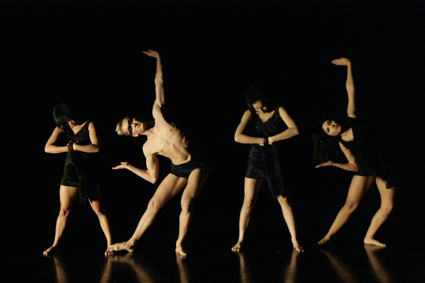
Hannah Glennie, Tyler Hawkins, Sophia Kennedy, Irina Nita, Kwacko, Victorian College of the Arts & Music (VCAM)
photo Jeff Busby
Hannah Glennie, Tyler Hawkins, Sophia Kennedy, Irina Nita, Kwacko, Victorian College of the Arts & Music (VCAM)
“DANCE PRACTICE” IS A TERM USED LOOSELY AND LIBERALLY TO DESCRIBE A VARIETY OF ACTIVITIES UNDERTAKEN BY A DANCE ARTIST. IT ENCOMPASSES MANY DEFINITIONS INCLUDING THE ACTIVITIES THAT DANCE ARTISTS ENGAGE IN, THE VARYING PROCESSES THROUGH WHICH DANCE ARTISTS CONNECT WITH THEIR WORK AND THE METHODOLOGY OF CONDUCTING POSTGRADUATE RESEARCH IE PRACTICE-LED RESEARCH. BUT WHICHEVER WAY YOU LOOK AT IT, THE ARTIST’S PRACTICE—THEIR ACTUAL ENGAGEMENT WITH THEIR CHOSEN FORM IN THE WAYS THAT THEY DETERMINE IT TO FULFIL THEIR CREATIVE OBJECTIVES—CAN BE REGARDED AS THEIR OWN ONGOING RESEARCH AND DEVELOPMENT PROJECT, WITH A “TECHNIQUE” OF ITS OWN MAKING.
Ultimately it is up to the artist to sort out which of their many experiences are integral to their artistic work and which are ancillary. Dancers often begin this process by undertaking a tertiary dance course. But as an artist’s dance practice is based on accumulated experiences and knowledge, a challenge for undergraduate tertiary dance courses is how to approach setting students upon their individual paths. So what role do these courses play in guiding young dance artists to begin thinking in these terms? And how do they help to set them upon their journey towards developing a practice which is relevant to their artistic pursuits?
Granted, the establishment of an individual dance practice is quite a sophisticated concept for a student beginning a tertiary dance course to grasp, let alone to appreciate that this is what he or she is ultimately headed towards. Sally Gardner, Lecturer in Dance at Deakin University, questions whether the majority of undergraduate students can initially engage with the notion of a dance practice: “99% of our beginning students understand dance in terms of ‘styles’: hence they say ‘I love doing contemporary’ or ‘Modern is so free’ and so on. They do not really understand dance as an ‘art’ as in the development of an individual creative vision. So they need to be led towards a new idea of dance. My hope is that on leaving Deakin they have come to realise that the journey is just beginning.”
It is widely acknowledged by the makers of Australian tertiary dance courses that the development of their students’ dance practice is an important and distinct element of their artistic training. Amongst the tertiary dance courses that had input into this article (Melbourne University’s Victorian College of the Arts and Music [VCAM], Western Australian Academy of Performing Arts at Edith Cowan University [WAAPA], Queensland University of Technology’s Creative Industries Department, Macquarie University’s Dance course and Deakin University’s School of Communication and Creative Arts), a variety of approaches was described. These included investigating a range of physical techniques and body based information, incorporating professional secondments and experiences such as touring and performing in the works of professional choreographers, and contextualising dance training through academic research and in terms of other creative fields. By and large these strategies and programs have been devised to provide students with opportunities to experience how artists work and for students to experience the reality of the artform’s requirements in the professional realm.
embodying
Jenny Kinder, Associate Professor at VCAM, describes their approach as an initial focus on the body, with further investigation of how that information can be incorporated to establish an autonomous dance practice with a distinctive artistic voice: “Students are exposed to the latest in dance science, kinesiology and somatic practices in addition to daily technique training and regular choreographic practice. Embodiment is developed through focus on neuro-muscular coordination and anatomical awareness. Students are encouraged to engage in an ongoing investigation of movement: anatomically, consciously and creatively in order to experience the dancing self and to find their own artistic voice.”
embedding
Secondment programs and employing sessional dance staff who have currency within the profession for dance technique, associated dance and movement subjects, and choreographic and performance projects are cited as excellent strategies that expose students to the variety of ideas, applications and methods that can inform their own dance practices. Cheryl Stock, Associate Professor at QUT, believes that “probably the most invaluable experience in terms of ‘real world’ practice is the secondment program in which final year students are embedded within a dance company or project.”
WAAPA in Perth has developed the secondment strategy further in establishing the LINK program that literally links new graduates from tertiary dance courses to the professional world. The one year program provides a postgraduate year of study while functioning as a pre-professional dance company. LINK members engage in extended dance training and performance programs worldwide, exposing them to a global perspective and providing the opportunity to make valuable professional connections. WAAPA’s third-year undergraduate students also participate in national and international intensive dance programs.
rationalised dance education
The current climate of change within many Australian universities is raised as a cause of concern where artistic practice is based around intensive physical training. Under current university restructuring programs, such as Melbourne University’s Melbourne Model, dance courses which have low student to teacher ratios and consume time and space less cost-effectively than others are facing a kind of economic rationalisation. In future years this may not be the best scenario for the continuation of studio-based dance practice, particularly where quantifiable employment outputs are emphasised. Cheryl Stock believes that “Although dance is quite nimble at getting around these bureaucratic and centralised ‘solutions’ it is my view that we are at a crisis point in being able to continue the highest level of training for dance practice in the industry (and by practice I mean the contextual, theoretical and practical aspects of being a dance artist in the 21st century, in all their complexity).”
another path
An altogether different approach towards dance practice can be found at the dance course at Macquarie University in NSW where students are accepted into the BA program academically rather than through audition. The vision and structure of this course seeks to redress the contention that those who study dance at tertiary institutes are primarily focused on becoming virtuosic company dancers. The course at Macquarie caters for students who wish to gain in-depth knowledge of dance as an art form and as a practice, in order to apply it to a range of other creative and research fields. Pauline Manley, Lecturer in Dance Studies at Macquarie, believes that the course enables a wider range of creative artists to intersect with the notion of a dance practice by “leading them away from the idea that dance is a display of technique”, and “developing the appropriate disciplines for an effective life in the creative arts.”
A lessened focus on physical technique means that students do not gain as readily the sophisticated and refined body management skills that are provided by courses which prioritise physical techniques to a higher degree. This reiterates the issue of whether tertiary institutions will be the ideal place for engendering a dance practice which is body based. In the case of the Macquarie course, Pauline Manley believes that their particular goals and approaches to students developing a dance practice are appropriate to a university study program and that “uni is the place to do it.”
finding the right space-time
Dance practice as observation and comprehension can be differentiated from the act of engaging in a dance practice through physical participation and rigorous assessment. Thus, determining whether a university setting is the best place to develop a person’s dance practice relates to the kinds of conditions and contexts that are relevant to what the student wants to do. Sally Gardner says that she would like to think that all aspects of dance at Deakin are approached as a form of inquiry. In terms of physical training, Gardner believes that body practices which have been so important in the development of dance artists like Trisha Brown and Russell Dumas require a specific kind of space-time. The university format of short timetabled classes is not conducive for this heightened degree of attention to the body and its movement. Importantly, she underscores an essential tenet for any young artist beginning to build their own dance practice:
“Students need to be able to spend time with practicing artists and they need to be able to see the best works that have ever been made in dance. Only then can they measure the gap between what they can do with their experience so far and what is possible. They will then go looking for the means to get where they want to be in dance, and they may in the process learn that they also need to develop the conditions that the dance they want to make needs.”
Awareness of how a dance artist interacts with the context of their work, as well as identifying the physical skills required for their chosen dance work, forms the very beginnings of an individual’s self-defined practice. A dance artist’s practice—like all other areas of the ephemeral live art that dance is—will always be subject to constant change, shifting opinions, re-evaluation and contradictions over time…as it should.
RealTime issue #98 Aug-Sept 2010 pg. 20
© Linda Sastradipradja; for permission to reproduce apply to realtime@realtimearts.net
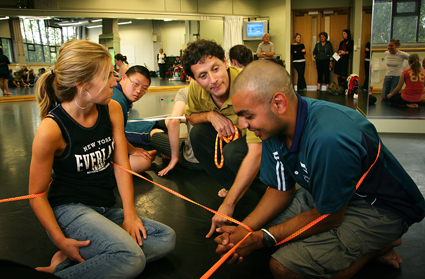
Associate Professor Ralph Buck (centre) and dance students working with members of the Pegasus Unit, the special needs class at Pakuranga College in South Auckland, NZ
DESPITE THE CROSSOVERS AND HYBRIDISING OF DISCIPLINES AND FORMS IN THE ARTS THESE DAYS, YOU’D BE HARD PRESSED TO FIND A UNIVERSITY IN PART OR WHOLE THAT DECLARES ITSELF INTERDISCIPLINARY. AN EXCEPTION IS THE NATIONAL INSTITUTE OF CREATIVE ARTS & INDUSTRIES (NICAI), A FACULTY IN THE UNIVERSITY OF AUCKLAND, NEW ZEALAND: “IN ALL AREAS, THE EMPHASIS IS ON CREATIVE EXPLORATION AND DISCOVERY AND ON INTERDISCIPLINARY COLLABORATION ACROSS THE FACULTY” [WEBSITE].
In NICAI dance sits alongside fine arts, visual arts, architecture and planning, and music. The focus on interdisciplinarity is principally postgraduate but there are major project based opportunities for undergraduates. Pan-disciplinary faculties are increasingly common in Australia. Sometimes this is the result of rationalisation, but none-the-less they can offer students the kind of interdisciplinary encounters they should expect after university in the arts or related careers.
Associate Professor Ralph Buck, Head of Dance Studies in the institute (alternatively referred to as the faculty) describes a three year Bachelor of Dance Studies degree where students increasingly engage with the world, develop dance flexibility, self-management and a sense of responsibility. There’s a marked emphasis on dance education and dance in the community with their career potential for teaching and leadership roles. The NICAI website mentions the following career options: choreography, dance journalism, dance education, dance therapy, community dance and academic research.
Buck explains that first year is focused within the university on class and studio work. In year two there are field trips, for example, to a secondary school that deals with students with disabilities, the psychiatric unit at Auckland Children’s Hospital and a retirement village. There’s also a camp in the far north of the northern island of New Zealand with activity focused on engaging with the environment—“a political project” designed to engender independence. In year three, students work in primary and secondary schools “not with their teaching hats on, but their artist hats, working in groups of three, making a company that works for five weeks in a school,” realising a project.
Buck’s aim is for students to “look at their own and others’ journeys,” to be responsive to the world. The dance classroom develops physical confidence, he says, but other aspects of the course widen student horizons so they can see “where to take their knowledge and experience.” He clearly expects his students to be realistic: “There’s a danger of a ridiculous chasm between expectations of a career onstage and reality. There are other ways to be a dancer.” One reality is that most money is to be had in teaching. He also looks to where dance is, in the community: “in different cultural groups and on the streets, not high art but hot and sweaty and just around the corner. In South Auckland it’s an access issue—there’s no stage, but dance is no less desirous.”
Across the course, says Buck, “there’s a strong multicultural element with a traditional core to first year study [including learning kaupapa hou and kapa haka and a range of Pacific music and dance] and a third to a quarter of students being Maori or Pacific Islanders studying alongside tap dancers and North Shore ballerinas. Everyone brings something and they help my teachers.”
There’s a strong emphasis too on independence, says Buck: “not to wait in line, to be bold and work at it. When the students finish they know what they want to do…and for the majority it’s not as dancers but as teachers or in youth work for churches and detention centres.”
As for interdisciplinary work at undergraduate level, Buck says it’s based around events and projects, not within courses per se. Recently fine arts, architecture and dance engaged with the NICAI’s new building with a choreographic response to spaces coming out of conversations about how we use them: “How do we respond to a stairway? How good is it? Look at it again…at the relationship between humans and design.”
Coming up is a major project titled The City Walk, involving fine arts, architecture, music and dance working with the Auckland Regional Council and town planners. The aim is to encourage the public to walk from the city centre to the Auckland-hosted 2011 Rugby World Cup “to reduce transport overload.” Nuala Gregory, NICAI’s Deputy Dean, writes, “[we are] designing a pan-faculty inter-disciplinary teaching project, The City Walk.The project has major benefits for students in terms of professional work experience and opportunities for international media exposure of their creative work…We are currently workshopping this project with the Auckland Regional Council, and have support from staff across faculty disciplines.” On their walk, rugby fans will encounter “displays of visual arts and live performances in music and dance.” The project will be trialled later this year.
The NICAI website provides video samples of dance and other works and plenty of evidence of interplay with Maori and Pacific cultures, some of it seen in dance and music taken to China recently as part of New Zealand’s delegation to the Beijing Modern Music Festival. Dance lecturer Dr Nicholas Rowe says on the NICAI website that an important aspect of the dance course is that it is not Eurocentric, that Auckland, “like a filter for the Pacific Rim” draws students from the region and encourages “the idea that the cutting edge can be local” whether New Zealand, Samoan, Malay or Australian.
With its pan-disciplinary range of departments, interdisciplinary projects and ambitions and its intercultural practices, the National Institute of Creative Arts & Industries has much to offer. NICAI clearly requires openness, the kind Ralph Buck seeks, where students “learn dance they’ve never done before,” “watch and learn in different contexts,” work with different communities and “learn how to operate in the world.”
National Institute of Creative Arts and Industries (NICAI), University of Auckland, New Zealand, www.creative.auckland.ac.nz/uoa/
RealTime issue #98 Aug-Sept 2010 pg. 22
© Keith Gallasch; for permission to reproduce apply to realtime@realtimearts.net
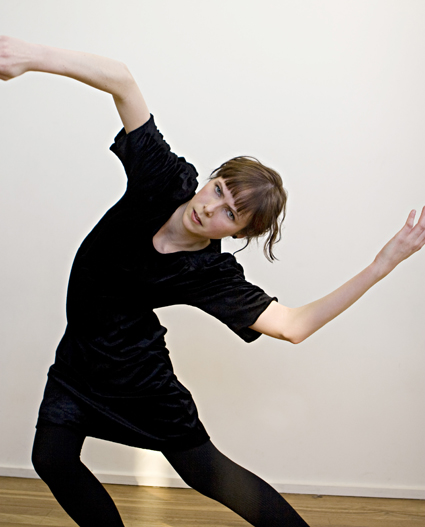
Fiona Bryant, In the Dark
photo Belinda Strodder
Fiona Bryant, In the Dark
WHAT DOES A BODY LOOK LIKE WHEN IT’S DANCING TO THE TUNE OF DEBORAH HAY? NOTHING IN PARTICULAR OR, AS HAY WOULD PUT IT, “THERE IS NO WAY IT SHOULD LOOK.” THIS MEANS THAT THERE ARE NO PREDETERMINED MOVES OR GESTURES WITHIN HAY’S WORK; THE USUAL CHOREOGRAPHIC LURE FOR COMPOSING THE BODY TO ACCOMPLISH PARTICULAR MOVEMENTS IS ABSENT.
This lack of predictability concerns performer and audience alike, which is not to say that the dancing is arbitrary. To watch a person engage with Hay’s choreography is to access a precise mode of experience. When we see the work ‘working’, we see a dancer on the edge of an abyss, oriented towards an obscure future. This isn’t merely the opacity of not having experienced what is yet to happen, for that is something every dancer faces. Rather, Hay’s work offers the dancer a heightened sense of not knowing.
Hay’s choreography intensifies the abyss of the future through turning the present into a void. Like Wile E Coyote in the Roadrunner cartoon suddenly poised over that dang canyon, there are no supports. Now what? To my mind, this is a key element of Hay’s work: to intensify the performative present by taking away what is usually there.
The title of this piece, In the Dark, indicates the sense in which the performer retains an open attitude towards an imminent future. The choreography could be seen as the means by which this is achieved. Over the years, Hay has developed numerous choreographies, complex combinations of left-field instructions, inscrutable, paradoxical, yet oddly concrete. They are, after all, the dancer’s only companion.
In the Dark arose from an intensive workshop held in March at the Bundanon Artists Residence, NSW, led by Hay with the assistance of dancer-choreographer Ros Warby. The workshop consisted of 10 dancers working solo. Each dancer was to practice their solo daily over the three months, so as to keep the choreography and its strategies alive. Come June, four Melbourne dancers presented a season of solos at Dancehouse. Three soloists performed each night. On night one, I saw Fiona Bryant, Atlanta Eke and Carlee Mellow. Unfortunately, I missed Luke George’s performance.
Each dancer brought one or two objects with them, a kind of security blanket or shamanistic fetish. Bryant was first, clip-clopping her way around the stage in boots according to an imperceptible rhythm. It was a good choice to begin with Bryant, who has some prior experience of Hay’s work. Her face was open, empty, drained of her usual persona. One had the strong feeling that she had no idea what was coming, that the horizon of oncoming movement was completely obscure. This is an incredible thing to sustain on stage with a pile of people staring at you. There was no ostentation in Bryant’s performance, no flourish, no demonstration of resident technique nor impressive gesture. She had the courage to simply stick to whatever was required from moment to moment. As a result, we saw a modest range of activities, lacking in pattern, eschewing recognition, jumping across the void again and again.
Since I have no real idea of the underlying choreography, what follows is pure speculation born of inference, for I am also in the dark. It looked like the dancers were engaging the near impossible, that attempting unachievable quests swallowed up their everyday dancing selves. There is a tinge of the postmodern in this work, not because it is pedestrian but because it challenges the knowing subjectivity of the dancer, because there is no space to display what one knows.
Atlanta Eke found her own way of engaging with the choreography. At one point, she stripped herself of her clothes, as if to shed her everyday self. She also broke with her dancing to incorporate a performed Q and A session, reminiscent of Xavier Le Roi’s recently performed autobiography. Why not fold audience participation into the moment, why not allow reflection in? At some point, Eke asked the audience whether the discussion was going on too long, whether she should finish. Some brave soul said ‘Yes’ and the solo was brought to an end.
Finally Carlee Mellow, probably the most challenged by the work precisely because she is the most experienced performer. Mellow had to find another way to dance, without resorting to past familiarities, to confront the choreography without the benefit of hindsight. She seemed to manage this, singing, stepping arhythmically, finding herself dancing in the work, without time to pause.
By the third solo, patterns began to emerge, the audience could anticipate the form if not the content. It’s no easy thing working in the dark and letting others see you doing so, but that’s what we saw: peeling away the layers to allow for another kind of dancing. The question then concerns what it is that emerges and where that comes from.
The Deborah Hay Solo Performance Project was a collaboration between Dancehouse, Critical Path, STRUT Dance and Bundanon Trust. For more on Hay’s methodology for this project, see www.deborahhay.com/spcp.html. For the dancers’ reflections on In the Dark, see www.dancehouse.com.au/research.
In the Dark, choreography Deborah Hay, 4 solo Adaptations by Fiona Bryant, Atlanta Eke, Luke George and Carlee Mellow; Dancehouse, Melbourne, June 17-20
RealTime issue #98 Aug-Sept 2010 pg. 22
© Philipa Rothfield; for permission to reproduce apply to realtime@realtimearts.net
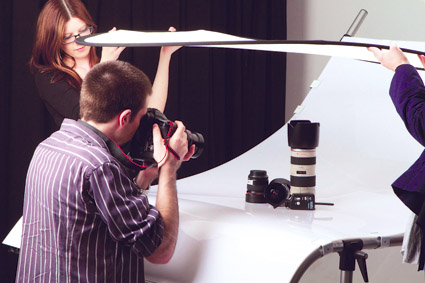
CSU photography students Amy Sinclair, Jason Schoenfeld, School of Communications & Creative Industries, Charles Sturt University, Wagga Wagga, NSW
The accompanying shot of photography students photographing a camera seemed apt for a RealTime edition where academics look at the relationship between the university as academy and the university as arts training institution. There are times when arts education tensions seem to go sharply binary. Our annual arts education coverage suggests that this is one such moment as the traditional notion of university study comes up hard against art practice. Even as practice-based research seems to be gaining traction, albeit not universally, other areas of tension open up. There is growing concern that as universities increase their investment in postgraduate programs, undergraduate students are in danger of losing out. We hear from academics who feel a strong obligation to students who will not be going on to higher degrees and whose focus is on making work and connecting with the sector of the arts economy in which they wish to work. The teaching emphasis here is on creating good learners who are flexible, deeply informed, multi-skilled and have substantial in-course ‘real world’ contact through work experience, professional practice and showing their work publicly. Some of the concern about undergraduate well-being is exacerbated by the effects of the absorption of arts training institutions into universities (most recently witnessed in the deleterious Melbourne University takeover of the Victorian College of the Arts & Music) who want to cost-cut class and studio times that creative arts courses desperately need for skills development and creative work. Some creative arts academics ask, again after years of amalgamation and rationalisation, is the university the right place for the creative arts? Others see universities now as too vocationally oriented, failing to develop critical enquiry. Some are concerned that the integrity of their discipline is weakened by artforms being shunted into multidisciplinary faculties, while others celebrate the interdisciplinary opportunities. Another tension is felt between university teaching and a socially networked world that invites decentralised learning: “What is to become of knowledge…in the confessional tweet economy when definitions of media art, discussions of the media sector and what I’m wearing at the time will be undifferentiated noise in the flow?” (see Darren Tofts). Some of these tensions will be destructive if skills development is diminished or the vocational thrust dominates; other tensions will be creative, making the university interdisciplinary…or “undisciplined” (see Peter Anderson).
RealTime issue #98 Aug-Sept 2010 pg. 1
© Keith Gallasch; for permission to reproduce apply to realtime@realtimearts.net
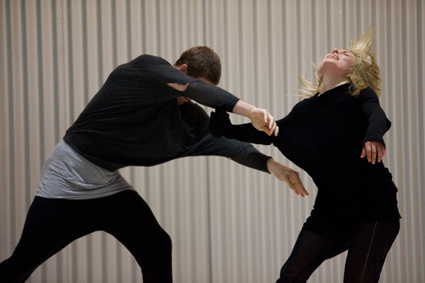
D’Arcy Andrews, Nicola Leahey, The Cry
photo Ferry Photography
D’Arcy Andrews, Nicola Leahey, The Cry
THE CRY, RAEWYN HILL’S FIRST FULL-LENGTH PRODUCTION AS THE NEW ARTISTIC DIRECTOR OF DANCENORTH, SEGUES FROM HER EARLIER WORK, ANGELS WITH DIRTY FEET (NEW ZEALAND, 2004). ANGELS WAS ABOUT ADDICTION, WHILE THE CRY DISSECTS THE RELENTLESS PROCESS OF RECOVERY. LIKE GAVIN WEBBER BEFORE HER, AND ROSS MCCORMACK AS GUEST CHOREOGRAPHER FOR LAST SEASON’S NOWHERE FAST, HILL FULLY EXPLOITS DANCENORTH’S HALLMARK PHYSICALITY, WHICH REMAINS CONSISTENT DESPITE AN ALMOST COMPLETE TURNOVER OF PERSONNEL IN THE PAST 18 MONTHS.
Preparation for this production included meetings with recovering addicts and the research has paid off with some remarkably insightful characterisations. The contrast between Nicola Leahey’s twittering Barbie doll-like role in Nowhere Fast and her dark intensity in The Cry is a testament to her versatility. Thomas Gundry Greenfield embodies the precarious point where frustration tips over into violence, while his victim, D’Arcy Andrews, tries to mediate, and responsively aligns his pain with that of the others. Jessica Jefferies’ manic character provides the only light relief with some sudden bouts of laughter and scratching during early group sequences, while still dancing in perfect time with the others.
With these four portraying recovering addicts, Luke Hanna’s character is less defined. He appears to organise the others and the set at some points, but also to manipulate, empathise and suffer. A gruelling 10-minute solo at the very end of The Cry reveals him as the personification of addiction itself, and the spirit of survival.
The set is inspired minimalism by Hill and production manager Van Locker. The white floor, two facing rows of skeletal chairs and cold lighting immediately establish this as a clinical space. Looming behind is an enormous, apparently floating, galvanised iron wall, its unforgiving scale an apt metaphor for the impersonal universe. The shiny, vertical corrugations reflect light from the vertically hung fluorescent tubes above, creating a slightly disconcerting fluid stripe effect on the eye. The first time a dancer smashes into the wall, the resounding percussive effect fills the large space and the audience jumps as one.
As The Cry opens it is quickly established that the characters have a pre-existing complex of relationships. The dancers use their actual names, adding authenticity to the limited dialogue. Repetitive movements of extraordinary strength and grace are interspersed with seemingly uncontrollable scratching, chest slapping and vein tapping. “Hit me, c’mon hit me,” says Jess, but we are unsure if she’s trying to provoke a reaction, or demanding methadone. Luke forcibly sits her down, keeps rearranging chairs and people.
To poignant violins, Nicola and D’Arcy perform a contorted floor piece, like limping spiders, until Tom intervenes and fights D’Arcy, smashing him into the wall, lifting him off the floor by the throat, then dropping him. The music is gone, D’Arcy is gasping for breath, everyone is shouting, chairs are thrown.
As order is restored, D’Arcy’s strangulated breathing becomes his music, pulsing through him, each considered movement connected to the pace of the breath. Another crescendo builds as Nicola dances to faintly oriental strains, a martial artist fighting with herself. Tom screams at her, “what have you got to prove, Nic? How good are you?”, throwing her to the floor repeatedly until she collapses. D’Arcy lifts her limp body onto his and Jess’s laps and, cradling her like a dead Christ, they tenderly undress and re-dress her in black.
In the most moving and complicit sequence of The Cry, tall Tom then carries Nicola on his front and then his back, threads his head through her clothing, and moves with her as though they are one, in a slow dance of grief. Nicola is completely pliant, as if dead. Tom lays her out on the floor, covers her face and performs a solo rife with tension and crucifixion-like gestures as the lights begin to fail and flicker. Anger builds again and he smashes chairs against the wall. They pile up around him like a funeral pyre as he flails, his face contorted in pain. Jess and D’Arcy crawl across the floor to the still prone Nicola and Luke wraps their faces in black cloth. Tom, a latter-day Atlas carrying the weight of the world, pushes the mass of tangled chairs into a corner.
Luke leads Tom as if leading an animal, mops his sweat and wraps Tom’s head in his own shirt, raises and lowers him in a slow tandem dance to drums like an amplified heartbeat, eventually laying him beside the others, casualties of a disaster. The shirtless Luke dances alone to plaintive strings, creating shapes out of his grace and strength, pleading and prayerful, moving from floor to air as if other forces are at work upon him. Face haggard, powerful, anguished and visceral, he dances and dances to exhaustion.
Less than an hour in length and unremittingly demanding, The Cry taxes its dancers to their physical and emotional limits. The audience is left almost as shattered.
Dancenorth, The Cry, concept, direction Raewyn Hill, choreography by artistic team, dancers Luke Hanna, D’Arcy Andrews, Thomas Gundry Greenfield, Jessica Jefferies, Nicola Leahey, set and light design HilLocker, Dancenorth, Townsvillle, June 2-6
RealTime issue #98 Aug-Sept 2010 pg. 24
© Bernadette Ashley; for permission to reproduce apply to realtime@realtimearts.net
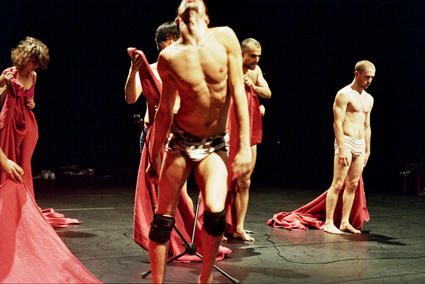
Out of Context—For Pina, Les Ballets C de la B
photo Chris Van der Burght
Out of Context—For Pina, Les Ballets C de la B
IT IS PERHAPS IRONIC, AND PERHAPS TRAGIC, 20 YEARS INTO A POST-IDEOLOGICAL ERA, IN WHICH CHOICE-LED CONSUMERISM HAS REMAINED THE SOLE SURVIVING ETHOS, THAT ART IS INCREASINGLY PREOCCUPIED WITH THE QUESTION OF THE STANDARDISATION OF HUMAN EXPERIENCE. WHAT SHOULD HAVE DISAPPEARED WITH THE SOVIET UNION SEEMS, ON THE CONTRARY, ALL-PERVASIVE.
From architect Rem Koolhaas’ notion of the “generic city” to theorist Fredric Jameson’s understanding of how postmodernity empties time of causal progression, analysis across disciplines returns to the idea that all this variation of screen sizes and skirt lengths is just a buzzing distraction from the standardisation of life on all levels, from feelings to social interaction, psychology to geography, to which There Is No Alternative.
Nothing exemplifies this buzzing vacuum better than the flying circus of internationally touring theatre, in which winning formulae and fashionable styles are often tediously replicated across languages and bodies, and all apparent cultural diversity collapses into trendy homogeneity. One such flying circus, Needcompany, is currently touring Europe with a production that interrogates precisely what happens to the human soul in this generic society.
The Ballad of Ricky and Ronny, a collaboration with Anna Sophia Bonnema and Hans Petter Dahl, is the first in a planned trilogy of pop-operas about a disaffected middle-class couple. It is sung entirely in international English, the thin, bland second language of most of the contemporary world, combining the tinniness of Nico and the verbal rhythms of Patti Smith with the drowsy beats of Flaming Lips. Ricky and Ronny once experienced love, idealism, the 1960s. Now, they cannot put a finger on the cause of their despair, as they lack any serious grievance. Instead, they milk their bloodless English, collected from Hollywood movies and pop music, for tired invectives and sentimental clichés. They try to muster stage provocation with bondage-wear and sexual experimentation. And yet they linger on stage in impeccable Euro-clothes, studiously avoiding physical contact, while their unnameable despair coalesces into a phantasm child, an hallucination made out of pink snow and yellow sperm, and they eventually commit a meaningless suicide. To underline just how little pathos The Ballad intends to create, an immaculate French maid sits upstage right throughout the performance, leisurely fiddling with the tech.
The opera is a structural, Zizekian tragedy: Ricky and Ronny are defeated by monster consumerism which satisfies desires before they can even fully form, leaving them in a state of voiceless agitation, or what cultural commentator Mark Fisher would call “depressive hedonia.” Thematically, the work sits in the conventional territory of dramatising cocooning middle-class despair without a cause. Its memory of love that used to redeem draws unlikely associations with Sarah Kane, whose despair is also moored in the deepest belief in love. However, Ricky and Ronny’s anxiety has no shelter throughout the performance, as the work refuses to believe in the metaphorical monsters its protagonists build to outsource their existential angst, much less defeat them in order to bring about any happy ending.
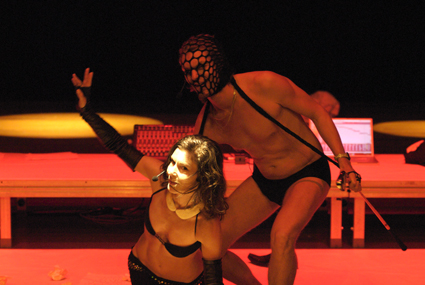
The Ballad of Ricky and Ronny, Needcompany
photo Maarten Vanden Abeele
The Ballad of Ricky and Ronny, Needcompany
The problems are threefold: eliminating the poetic aspects in the figuration of the bourgeois ennui does not, by itself, reveal its socio-political structure; The Ballad is no more penetrating a social critique than a conventional zombie flick. Secondly, made entirely out of generic elements, it is one of the most tedious performances I have ever seen, so commonplace through and through that it tends towards invisibility. Finally, there is an annoying solipsism at the heart of a performance that so deeply represents and replicates the very condition it denounces: it appears to have frustrated every Eastern European audience it has encountered, including the one that saw it with me at Eurokaz festival in Croatia. While it must be said that the immaculate staging and the direction of movement build the formal perfection of the piece, I have rarely been so pleased to see an audience rebel against understanding an artwork. For it means that tragic standardisation is not a universal condition, despite all the global English employed to construct the argument.
A new work by another Belgian company, Les Ballets C de la B’s Out of Context—For Pina, approaches the matter from a radically different angle. Alain Platel’s company is among Europe’s most respected, and the new work was showing at Sadler’s Wells for only two nights before rushing back to the festival circuit (it was scheduled at Avignon later in the season). The UK critics were rather sceptical towards a company that meshes vernacular movement with high aspirations (‘fun’ and ‘skill,’ two terms dear to British dance, are quietly sidelined in Platel’s vocabulary), but Out of Context has, in other places, been hailed as their best work yet.
The movement, woven out of the unconscious tics, spasms, hysterical and involuntary gestures that Platel has encountered in his prior work as an orthopedagogue includes pouting, scratching, over-the-top disco dancing, parodic mime and is consciously poor in style, making almost no references to any ‘serious’ dance tradition. Platel has refused to call himself a choreographer; Out of Context is an exquisite choreography nonetheless. Unlike his previous works, it is played on an empty stage, to no programmatic score. Bookmarked by nine dancers entering from the stalls, undressing to their underwear, then dressing and leaving again at the end of the show, it has three clear phases: initial rituals of mating and acquainting with animal sounds in the background evolves into the second phase, in which lines of pop music are thrown around together with exuberant dancing until, in the elegiac third part, the dancers retreat into singularity again. The piece defies description by virtue of sheer over-accumulation: 90 minutes of startlingly original movement with virtually no repetition, on nine different physiques that, even when amassed into synchronicity, preserve individual differences. (The piece is dedicated to Pina Bausch, in recognition of the foundational importance of her psychologically driven strategies for European dance.) Not having any narrative frame allows the audience to experience this decontextualised mass of movement on the level of affect, not cognition, free-associating stage images to deep memories. The result is emotionally penetrating and deliriously enjoyable.
Whereas The Ballad of Ricky and Ronny is a work so deeply illustrative of the nihilistic element within consumer capitalism that it irons itself into a completely inexpressive pancake, Out of Context locks itself within the last bastion of human expression that has escaped the Fordism of soul: the pre-cognitive, the involuntary, the spastic. We could see an eternal, unwinnable race at work, in which ever-shrinking chunks of life are accessed, broken down, conquered and reproduced—perhaps Platel is simply mapping previously inaccessible sides of the human experience. But it is also good, in some fundamental way, to experience a performance that leaves the audience elated rather than crushed.
Needcompany/MaisonDahlBonnema, The Ballad of Ricky and Ronny, authors, performers Anna Sophia Bonnema, Hans Petter Dahl, libretto Bonnema, music Dahl, costume, lighting MaisonDahlBonnema; Eurokaz Festival, Zagreb, June 23-24; Out of Context—For Pina, Les Ballets C de la B, concept, direction Alain Platel, dramaturgy Hildegard De Vuyst, danced & created by Elie Tass, Emile Josse, Hyo Seung Ye, Kaori Ito, Mathieu Desseigne Pavel, Melanie Lomoff, Romeu Runa, Rosalba Torres Guerrero, Ross McCormack; Sadler’s Wells, London, June 17,18
RealTime issue #98 Aug-Sept 2010 pg. 25
© Jana Perkovic; for permission to reproduce apply to realtime@realtimearts.net
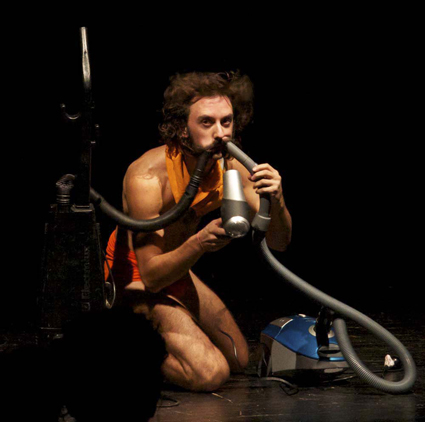
Luke George performs his own piece in 24 Hours, Dancehouse
photo Tim Jomartz
Luke George performs his own piece in 24 Hours, Dancehouse
IF YOU HAVE BEEN TO A THEATRE OR DANCE SHOW IN MELBOURNE IN THE LAST SIX MONTHS, YOU MAY HAVE COME ACROSS LUKE GEORGE. THIS TASMANIAN-BORN CHOREOGRAPHER HAS BEEN INVOLVED IN A RUN OF PRODUCTIONS THAT HAVE SURPRISED EVEN THE AMBITIOUS ARTIST HIMSELF WITH THEIR SUCCESS AND PROFILE.
Working freelance myself, I empathise with George, when he explains the embarrassment of opportunities that he is currently enjoying. “Last year I did not have a lot to do,” he says, “So I applied for everything.” Now he is working on five projects back to back and is cheerfully flat chat. “It’s very manageable because it’s all creative…and I am in all the work.”
Luke George drives his choreographic work from within, with the same commitment that he applies to his career. His early experience of leadership, as joint Artistic Director of Launceston’s youth dance company, Stompin’, 2002-8, delivered accolades aplenty. The energy that enabled him to create large scale work with young people is evident in his pursuit of a broad range of engagements in his new home town of Melbourne.
Contributions as a dancer to the work of Chunky Move, Shelley Lasica, Jo Lloyd, Frances d’Ath and others have been matched by choreographic projects. “Performing and choreography have always been intertwined for me,” George says, and cites his role in the work of Phillip Adams for Balletlab as an example of where he is challenged most. “I get something from Phillip because he asks me to be in a state of questioning. He is always pushing what he wants to do. It’s exciting and scary too.”
24 hours
As well as recently contributing to the development of Aviary, the Balletlab production due to premiere in 2011, George was a participant in Adams’ contribution to the 24 Hours project at Dancehouse (RT97). For this fleeting but hugely popular initiative, Jo Lloyd commissioned four choreographers to conceive, devise and present a production within 24 hours. Adams worked with new media artist Matthew Gingold to create a movie for his commission, extracting something wild and unfettered from the spontaneity of his intimacy with performers George and Balletlab regulars Brooke Stamp and Jo White. In George’s own commissioned piece for the 24 Hours program, he worked with sound artist Nick Roux, along with Stamp and visual artist Mila Faranov. In tune with the zeitgeist, George is very inspired by the removal of theatrical artifice. He relished the tight temporal frame of Lloyd’s commission to dig deep into the present moment.
deborah hay project
Dancehouse furnished Luke George with another excursion into rich territory with the Deborah Hay project, In the Dark (p22). A collaboration between Perth’s Strut, Sydney’s Critical Path and the Melbourne venue brought 10 dance artists into residency with the American experimental choreographer Hay and her Australian muse, dancer and choreographer Ros Warby. Hay gave the artists the template of a solo and required them to enter into rigorous and disciplined exploration of the material over three months prior to its performance in a triple bill.
George’s light and ludic performance for In the Dark was the highlight of my experience of this production. He invested Hay’s material with authority and charm, rendering the dense and potentially introverted material open and intriguing. He held his focus with considerable aplomb given the proximity of the audience and the inevitable sniggers that greeted his entrance with trademark mutton chops absurdly set off by a hot pink body suit and clumpy shoes. George spoke with enthusiasm of the discipline required to fulfill Hay’s contract. “The repetition of rehearsing the work daily for three months forces you to recognise patterns within your behaviour and to find ways to transcend these; to find fresh possibilities within the material and yourself,” he said. “I’m really into the idea of practice. Not just to be good, but to continuously witness your own practice and learn from it. It services a lot of things that are all connected.”
nownownow
There are strong connections between Hay’s tantalising exposure of the performer on an empty stage and the full evening production that George is about to complete. NowNowNow has been commissioned by Lucy Guerin Inc and will receive its premiere at Dancehouse in late July. “I have pulled back on all the production elements in this piece,” George says. “It’s all about the relationship between the performers and then theirs with the audience.” Kristy Ayres and Timothy Harvey will dance with George, with basic costumes and no video or props. Martyn Coutts will dramaturg. “We have got to the point where we are in such clear communication with each other,” George says of the two developments that have preceded the final production phase to come. “I used to think we could not be in the moment, but I am starting to think this is possible.”
My experience of the sharing in which the second development of NowNowNow culminated, was of an intense, willed focus from the performers upon a series of seemingly interchangeable exercises from which something almost violent seemed fit to explode. The push and pull of their alternating desire to communicate and to withdraw was uncomfortable and intriguing. As befits a development, the discipline of their play with this dynamic was a little unsteady and the trajectory of the piece involved some awkward fits and starts. George encouraged his invited audience of peers to stay behind after the showing for a discussion that he relished for its negative as much as its supportive commentary.
first run
“I am very interested in talking about dance,” George says. He links his concern for talking honestly about his own work to a sense of responsibility for the artform and a growing maturity in Australia in relation to criticism, academic discourse and research as practice. With Brooke Stamp, Luke George co-curates First Run, a platform for emerging choreographers supported by Lucy Guerin Inc. First Run encourages protracted discussion of works in progress shown and has been embraced by the independent dance makers of Melbourne, with high attendance and a good quality of debate. “With First Run we are developing a place where we can talk without nervousness and tiptoeing around.”
miguel gutierrez
George has long ceased to tiptoe around. His next project, a Culturelab research residency, involves louder than life New York choreographer, Miguel Gutierrez. The two met during Balletlab’s 2007 production, Brindabella, for which Gutierrez contributed a striking section of choreography. When Balletlab were resident in the US, George contrived to stay on and hang with Gutierrez and his dynamic New York collaborators. Gutierrez describes George as his “spirit brother in art” and shares his interest in the relationship between performer and audience. He too is not afraid to confront and George is looking forward to exposing a peer audience to the result of their development.
resilience
Inspired by his visits to cities like New York and Berlin where artists forge a living from precarious means, George has developed some strategies for resilience through the lean periods. He choreographs regularly for the Melbourne gay club JOHN and works in theatre for productions large and small (he was movement director for Optimism at the Malthouse and Urchin by emerging company Encyclopedia of Animals in Full Tilt this year). George also supports emerging artists such as James Welsby and Amy Macpherson and their dance collective Phantom Limb for whom he made a piece this year. Despite the now, now, now whirlwind of creative life he’s enjoying, Luke George has few illusions about the hard work ahead. He says he hasn’t got around to writing any grant applications so the flow of opportunities will necessarily slow. We agree not to think about that and enjoy the present moment.
Luke George’s NowNowNow will be reviewed in RealTime 99, October-November. To read about Lucy Guerin Inc’s First Run go to http://www.lucyguerin.com/research/First_Run
RealTime issue #98 Aug-Sept 2010 pg. 26
© Sophie Travers; for permission to reproduce apply to realtime@realtimearts.net
JUST HOW DO YOU ASSESS THE RESEARCH QUALITY OF A CREATIVE WORK? THIS QUESTION CAME UP AGAIN AND AGAIN AT JULY’S AUSTRALIAN SCREEN PRODUCTION EDUCATION AND RESEARCH ASSOCIATION (ASPERA) CONFERENCE, HIGHLIGHTING WHAT IS A COMPLEX PROBLEM EXERCISING THE MINDS OF MOST WORKING IN THE SCREEN PRODUCTION EDUCATION SECTOR AS THE EXCELLENCE FOR RESEARCH IN AUSTRALIA (ERA) INITIATIVE MOVES INEXORABLY FORWARD. OR WILL IT? WOULD A CHANGE OF GOVERNMENT DERAIL THE WHOLE PROCESS, BRINGING ABOUT YET ANOTHER CHANGE OF DIRECTION?
The ASPERA conference, held at UTS in Sydney this year, is the annual forum for academics within the Australian screen production field to discuss shared issues, exchange ideas and, currently, to address the challenges posed by the ERA. While the three days of the conference provided an interesting mixture of the problematic, the pragmatic and the abstract, with a bit of the practical and the mathematical thrown in, issues to do with both technological change and with ERA kept recurring.
complex contexts
Theo van Leeuwen, UTS Dean of Arts and Social Sciences, said in opening the conference that teaching media studies within a university environment may often not “fit in with the timetables and ways of assessment of the university,” especially while also coming to terms with the challenges of technological change, but that “universities are places where you have the chance to experiment and test out ideas and develop arguments that can be carried out into the public sphere.”
Deb Verhoeven from RMIT highlighted the recent AFTRS screen producer survey and some of its findings—she advised those interested to go to the very user-friendly website to find out more. Verhoeven drew attention particularly to the very low ratio of younger people identifying as content producers (with most producers being over 40), and the fact that only five percent thought that a creative arts education was important.
a new kind of academic
Verhoeven also asked how academics might learn from emerging media practice, and how new media practices might challenge and change the role of academics. Saying that she usually avoided films that featured teachers (especially those with Robin Williams), she reported on a film that she believes really shows how education works, especially in an unstructured and innovative way—How to Train Your Dragon. “It advocates networking and mentoring, that information must have a perceived relevance, and argues that old knowledge can become irrelevant in the course of acquiring new knowledge,” she explained.
Arguing for the emergence of a new type of academic, the mediator and motivator, Verhoeven said that “we perhaps underestimate the importance that media and communication departments are going to have in universities in the future.” She also argued that digital media affects a whole range of producers, and that it’s not just about digital literacy; “a key competency,” she said, “is the ability to move flexibly between different digital environments.”
When Gill Leahy of UTS, convenor of the conference, asked about aesthetic criteria for these new environments, she said that “audiences are much more likely to tolerate what we’d see as not good quality. Getting stuff out there just in time for audiences that are ready for it is much more important. We’ve got a lot to learn from the very practices we’re teaching our students.”
defining era, defining research
The problematic for the sector is how to deal with the major changes that are happening in universities to do with the assessment of creative work. The ERA initiative assesses research quality within Australia’s higher education institutions using a combination of indicators and expert review by committees, and research is defined as the creation of new knowledge and/or the use of existing knowledge in a new and creative way so as to generate new concepts, methodologies and understandings. Andrew Curran, from the Australian Research Council, gave a briefing updating the process and giving details of how it works; he commented that “being a creative lot will be good for you in the ERA.”
Going through all the general principles, objectives and timelines of the ERA, Curran pointed out that peer review is a “really important component” of the assessment process, and that while everything must be submitted, the process is designed to be flexible. Interestingly, he confirmed that while the rather controversial list of ranked journals has been finalised, as well as the list of conferences, the ARC would continue to receive feedback regarding journals and conferences which would be recorded on the database, and that the list would be updated and revised prior to any future ERA round. He added that the ranked journals are only one of a number of unweighted indicators, and that articles in C-ranked journals could be put forward in peer review. He argued that the challenge for the assessment of creative work is in defining the research element, and that a portfolio needs to demonstrate coherent research content. “Work out how to present your discipline and highlight its importance and outcomes,” he said.
rating exhibition outlets
Another area of creative arts publication equivalence that will be able to be assessed within the ERA process was introduced by Mick Broderick of Murdoch University, who explained that film exhibition outlets, which include local and international film festivals, broadcasters, museums and galleries, as well as online sites, could be ranked to act as proxies. His initial list of film festivals, which caused a fair amount of immediate discussion and revision, will be edited, rated and ASPERA-endorsed, but must follow the ERA A* to C format and will be adjusted annually. “This initial list is imprecise and generalised,” explained Broderick, emphasising that the ratings must be done by academics and peak bodies, not bureaucrats. “I’m confident that the sector knows enough for the listings to be accurate,” he said. “Fortunately, most of the festivals we’re looking at have their own internal peer review process, while works submitted to festivals should have all gone through a peer review at their own institution as well.” He indicated that ASPERA should also supervise the ranking of broadcasters, academic festivals and other levels of specialist exhibition in the future.
Leo Berkeley of RMIT is concerned that the whole discussion is still premised on creative works being films, but, as he says, there are now websites and games and other digital work, which are much more difficult to assess. And Deb Verhoeven was concerned that the list of festivals for ranking didn’t include any online festivals.
assessing output & assessors
But the most compelling session was the work-in-progress report on the large-scale project headed by Dr Josko Petkovic from Murdoch; he’s now three quarters of the way through the research project, Assessing Graduate Output at 19 Australian Film Schools, and he provided page after Powerpoint page of the most intricate charts, using sophisticated maths, which recorded the elegant differences in ratio and some of what he called “interesting convolutions,” in his quest to quantify the information. As he said, “the crux of the problem is that many of us believe that the scholarship/research aspect of our work is hard to quantify,” and this research project is aimed at establishing “that the assessment of students’ creative work can be as consistent as assessment in other disciplines.” In this initial stage, it’s the assessors (30 screen production academics), not the projects, that are being assessed, and “the project is based on the proposition that assessment of screen production is as complex and multi-faceted as the screen production process itself.”
With its multiplicity of criteria and ranks of assessors, the interim report was quite confronting, and we probably need the final, written report to definitively come to the same conclusion as Josko Petkovic; that the assessment process will be valid, highly reliable and internally consistent.
holding up in the real world
Another strand in the conference centred on the sector’s relationship with the industry; George Karpathakis of Edith Cowan University talked about community engagement and professional placement, and in particular the experience of a number of his students as they entered what one called “the real world—up until now you’ve been in the classroom, and you get to work with people in the industry and find out how you hold up.” As Karpathakis explained, while the policy is for the student to find the placement, in practice it’s usually the academic who uses their contacts. Once in the placement, students are on their own; in the cases he highlighted, the initial work led to other jobs and more responsibility.
Trish FitzSimons talked about the Work Integrated Learning process happening at Griffith University, where all third year students have to do 65 hours placement. “The rationale is that we’re running vocational programs, but there are not enough jobs out there.” She believes that there is so much for them to learn from their work placement, “and it also makes their films better.” Griffith, she says, is lucky in that it has connections with industry and screen cultural organisations in their area; “we get calls from big productions on the Gold Coast for students to work in the art department or whatever, and we have a mentorship scheme that often leads to placements. Work is unpaid initially, but as students prove their worth they can move into paid work.”
Leo Berkeley explained that RMIT encouraged their international students to do their industry attachments back home, between semesters, where it helps to integrate them with local industries but, of course, he added, monitoring their progress is more difficult.
new risk environments
Pragmatic matters? Well, Occupational Health and Safety probably comes under this heading, although Nicholas Oughton from Griffith University argued that creative industries, including screen-based ones, operate in a different environment and context from traditional workplaces, which makes the traditional OH&S systems inappropriate. “Creative industries thrive on risk-taking,” he argued, “and are constrained by risk avoidance.” He believes that as the very nature of work changes in the 21st century, and as cultural and creative elements are becoming more important, a new perspective on OH&S is required; he recommended that a new OH&S model should be designed for the creative industries.
signs of work
This is only a taste of the conference, and in amongst the papers and discussions there were some glimpses of actual creative work. Sarah Gibson of UTS gave a peek into her fascinating and soon to be completed multiplatform project Re-enchantment, an interactive journey into the world of the fairytale, which will be hosted on the ABC’s website and supported by three-minute animated minidocs on ABCTV. David Carlin tempted us with some scenes from Motel, three interlocking short films set in the same motel room with the same actors, made by three filmmakers and two designers as a practice-based research project at RMIT. And Rachel Wilson from RMIT reported on the work she is doing towards the setting up of a digital archive of student films—sounds dry, but it was absolutely fascinating and should result in a great resource.
ASPERA Conference 2010, University of Technology, Sydney, June 7-9; http://www.aspera.org.au
RealTime issue #98 Aug-Sept 2010 pg. 27
© Tina Kaufman; for permission to reproduce apply to realtime@realtimearts.net
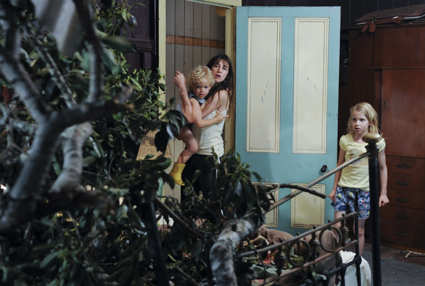
Charlotte Gainsbourg, Morgana Davies, Gabriel Gotting, The Tree
photo Baruch Rafic
Charlotte Gainsbourg, Morgana Davies, Gabriel Gotting, The Tree
UNDER CLARE STEWART’S CREATIVE LEADERSHIP THE SYDNEY FILM FESTIVAL APPEARS TO HAVE FOUND THE PERFECT BLEND: A COMPETITION VIBE WITH BIG AUDIENCES AND FESTIVAL STARS (EWAN MCGREGOR OUT FOR ROMAN POLANSKI’S THE GHOST WRITER—POLANSKI EDITED THE FILM IN JAIL); INDIE FAVOURITES (LIKE TODD SOLONDZ’S FOLLOW UP TO HAPPINESS, LIFE DURING WARTIME AND MICHAEL WINTERBOTTOM’S CONTROVERSIAL THE KILLER INSIDE ME); CULTURAL ODDITIES (BANKSY’S BRILLIANT DOCO, EXIT THROUGH THE GIFT SHOP); MERCILESS BLACK HUMOUR (CHRIS MORRIS’ OUTSTANDING FOUR LIONS); AND A GOOD MIX OF INDUSTRY TALKS (INCLUDING A HIGHLY ENTERTAINING TAKE ON AUSTRALIAN GENRE MOVIES).
This year, two films with Australian connections featured in competition (The Tree and Wasted on the Young), and a sold-out session of The Dendy Awards for short films revealed lots of Oz talent on the rise.
the tree
French director Julie Bertucelli’s The Tree was selected for Cannes Film Festival’s closing night. The film is a French/Australian co-production (hence the inclusion of uber-cool actress Charlotte Gainsbourg—so memorable in Lars von Trier’s Antichrist [2009]) and is that rarest of film beasts—it beautifully melds the Australian landscape with a French film aesthetic. Simone (Morgana Davies) is a spunky, headstrong girl who witnesses the death of her father Peter (Aden Young) while riding on the back of his ute. As he suffers a heart attack, his truck smashes into the beautiful old fig that dominates the family home. As grief overpowers her mother, Dawn (Gainsbourg), the girl turns to the tree for comfort and protection, eventually sleeping there; she is convinced she can hear her father whispering in the leaves.
Like Scott Hicks’ The Boys are Back, The Tree focuses on the inner world of a child in the immediate aftermath of unexpected death. Hicks’ film was also set in an old house with a verandah, a sublime rural landscape. Both films were based on successful books and, while occasionally maudlin, with lashings of syrup, they manage to connect deeply with childhood experience—in the dialogue of kids trying to understand a world gone awry—and the struggles of the parent (in Hicks’ case, a father) left behind. How to grieve when your children are swamping you: there’s no space or time to reflect. At the funeral, Simone observes, “No-one’s crying. That’s how it is when people are really sad.” As Dawn finds it increasingly hard to get out of bed, the neighbours quickly forget her pain. In her home no-one answers the phone. Dad’s still on the answering machine. Simone brushes Dawn’s hair, organises clothes off the hangers, in a bid to reclaim her mum, help her rediscover life.
The beautiful tree took a long time to cast. Eventually, when Bertucelli found the perfect specimen (with no CGI help), the house set was built around it. With its patches of lichen, ants scaling the trunk, it becomes like a many-limbed maternal body. The wonderful sound design brings the relationship between Simone and the creaking tree to life; it sings in the wind. The girl gradually becomes a bowerbird, taking her father’s watch and other precious items, and hanging them in the tree’s branches to create a kind of shrine. The film never veers into magical realism (hinting, hinting) but still there is that sense of child-like wonder at the majestic (I remember my passionate childhood love for Enid Blyton’s The Magic Faraway Tree).
The Tree’s drama comes in the form of George (Marton Csokas), Dawn’s new lover who, being a pragmatist wants to cut the tree down (after a large branch crushes part of the house), underestimating the determination of a young girl grieving for her father.
wasted on the young
Wasted on the Young, while differing markedly in style, is also about parental absence. A slick and techno take on upwardly mobile teens in a posh school, the nihilism of writer/director Ben C. Lucas’ film reminds me of novelist Bret Easton Ellis’s early work, the generation-defining Less Than Zero. Adults of any kind (parents, teachers) never feature within the film’s frames: this is a dog-eat-dog world where boys aim for perfection (the swim team) while girls compete to fuck them. Zach (Alex Russell as head honcho) holds parties every weekend in his super-styled mansion where it seems only his brother Darren (Oliver Ackland) is not on the guest list: he’s hunkered down by the computer, working on his school projects.
While clichés abound (jocks vs nerds), and there’s nothing really new to the date-rape-revenge narrative (extending the themes of Steven Vidler’s Blackrock [1997]), most of the acting is terrific (especially Adelaide Clemens as the rape victim, Xandrie) and what sets the film apart is its brilliant production design and highly stylised effects. Beautifully integrated is the teens’ world of text and chat, the conversations dripping off the walls, part of the film’s fabric, rather than just posed as the usual screen shots. The ending, too, takes on reality TV’s voyeuristic need to vote contestants off, of how far you’re going to push the idea that you have a right to watch and control, whatever the outcome.
the dendy awards
The Dendy Awards each year brings together a great showcase of filmmakers working on short film projects, and always highlights names to watch. This year, as always, was a mixed bag but there were a number of stunners. Winner of the Yoram Gross Animation Award, The Lost Thing (directed by Shaun Tan and Andrew Ruhemann) uses a unique otherworldly aesthetic (familiar to readers of Shaun Tan’s picture books) to craft a melancholy tale of a boy who discovers a hybrid creature that doesn’t quite belong in the muted industrial landscape of his world, and helps it find a place in the sun. The film won the Cristal Award at the Annecy Film Festival, the most prestigious international animation festival.
In terms of drama, The Kiss (winner Best Live Action Short; director Ashlee Page) and Deeper Than Yesterday (Rouben Mamoulian Award for Best Director; Ariel Kleiman) were both outstanding and (bizarrely) featured dead females floating. The former is a languorous nightmare where two teenage girls, hot and drunk, take a bike ride in the bush and jump into a well before realising they can no longer reach the rope ladder to climb out; the latter, a remarkably assured surreal tale of Russians aboard a submarine who surface to discover the body of a woman floating nearby. Once aboard she becomes a kind of waltzing matilda, a site for the men’s frustrated fantasies.
It’s always hard to pick and choose at festivals but part of the joy is the hit and miss, that feeling of jetlag when you realise you’ve spent a whole day in a seat without moving your arms or legs. The festival offers its own pathways (with titles like Fire Me Up, Freak Me Out, Take Me to the Edge…) to negotiate the ticketing process but I usually make my own way. This year I opted for black comedy; the youth factor; films starring actresses named Charlotte; and new Aussie. It was a great success.
The Tree and Wasted on the Young screened in competition at the Sydney Film Festival with Wasted on the Young receiving an honourable mention from the judging panel.
The Tree, writer, director Julie Bertucelli, based on a novel by Judy Pascoe, producers Sue Taylor, Yael Fogiel, Laetitia Gonzalez, original music Grégoire Hetzel, cinematographer Nigel Bluck, editor François Gédigier; Wasted on the Young, writer, director Ben C Lucas, producers Janelle Landers, Aidan O’Bryan, cinematographer Dan Freene, editor Leanne Cole
RealTime issue #98 Aug-Sept 2010 pg. 30
© Kirsten Krauth; for permission to reproduce apply to realtime@realtimearts.net
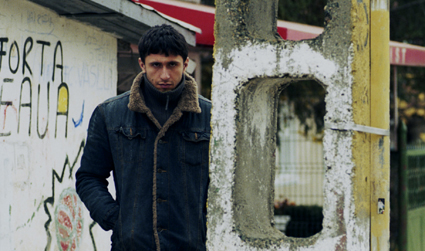
Dragos Bucur, Police Adjective
FOUR FILMS IN THE 2010 SYDNEY FILM FESTIVAL INDUCED STRANGE STATES OF BEING, EACH CINEMATIC EXPERIENCE A REMINDER OF THE CAPACITY OF FILM TO SUSPEND TIME, CHALLENGE VISUAL PERCEPTION AND QUESTION OUR READINGS OF THE BEHAVIOUR OF OUR FELLOW HUMAN BEINGS. FOR A STEADY STREAM OF EXITING FESTIVAL-GOERS UNWILLING TO SURRENDER TO THESE FILMS’ DEMANDS FOR PATIENCE, THE PREVALENT STATE OF BEING WAS DOUBTLESS BOREDOM, BUT FOR THOSE WHO WENT THE DISTANCE THE REWARDS WERE, WELL, ALMOST INEXPRESSIBLE.
women without men
Iranian artist Shirin Neshat’s video installations are some of the most powerful I’ve experienced. Women without Men deepens conventional filmmaking with the language of Neshat’s video art—the long gaze at a still face or at an eerie garden or across a desert; images that recur and disorient—a woman on a rooftop, looking out before falling; time made indefinite. On the other hand there’s urgency and suspense in this unhurried telling of the destruction of democracy in Iran in 1953 and the parallel plight of four oppressed women of different social castes who seek refuge on a country estate and achieve temporary unanimity.
police, adjective
In the ultimate stakeout movie, Romanian Corneliu Porumboiu’s Police Adjective, we enter into the real time world of physical surveillance as a young undercover detective (Dragos Bucur) interminably monitors a suspected young hashish dealer. Just as viewer patience is stretched to the maximum, the stakeouts are interpolated with brief, relatively brisk episodes (with the detective’s wife, other investigators, his boss) that reveal his growing doubt about prosecuting a harsh sentence against a minor offender. The episodes yield a growing sense of absurdity in a tired, stressed system where the confusing gap between law and justice signals not only a young post-communist country struggling with the notion of democracy but also a rigidity that belongs to the past. The deadpan dialogue captures the semantic contradictions with Kafka-esque brilliance as the characters struggle to come to terms with new meanings.
uncle boonmee who can recall his past lives
Apichatpong Weerasethakul’s uncle boonmee…is the strangest of these films, certainly the most disorienting as the Thai director’s typically inconclusive narrative—embodying folk tales, ghosts, sexual politics and the demands of family—unfolds with utter unpredictability. A dying man reunites with his son and dead first wife and visits the cave site of his first life. Subsequently we linger with the remnants of the family in a motel room which splits into a parallel universe. As with Weerasethakul’s Tropical Malady, there is a raw beauty to the filming—nightime has never been so dark in film as here—unaccented performances and a totally convincing merger of worlds actual and other that together question what’s real.
white material
Isabelle Huppert’s character in Claire Denis’ White Material is like one those strangely engaging, obtuse women in Eric Rohmer films oblivious to what is going on around them, except that here the woman is a French colonial coffee plantation owner in Africa in the midst of a bloody rebellion destined to banish or murder colonists and many of the native population with them. Seemingly blind to the disintegration of her family, the fears of her workers, the compromised friendship with a local African leader and the danger to herself, she pushes ahead, harvesting with frightening determination.
The suspense in White Material is painful, the pacing almost real time, the tropical heat palpable—we feel like we’re travelling every exhausting kilometre with the woman when she goes to fetch replacement workers, living out the senselessness of her quest, a condition doubtless created by the personal investment she has made in the plantation against all the odds of politics and family. Denis creates a world that hovers between the actual and something bordering on the surreal, realised here by having to identify with the woman’s misreading of her circumstances, all the way to a chilling release that is less than cathartic and all the more meaningful for it.
2010 Sydney Film Festival, June 2-14
RealTime issue #98 Aug-Sept 2010 pg. 31
© Keith Gallasch; for permission to reproduce apply to realtime@realtimearts.net
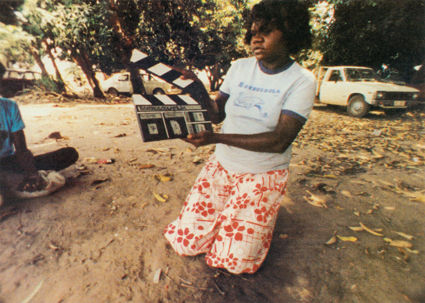
Two Laws (1981)
THERE WAS A SENSE OF POIGNANCY THAT PERMEATED PROCEEDINGS AT THE ‘FROM U-MATIC TO YOUTUBE’ SYMPOSIUM, A CONFERENCE CO-CONVENED BY MONASH UNIVERSITY AND THE AUSTRALIAN CENTRE FOR THE MOVING IMAGE (ACMI). ON THE OPENING MORNING, DR. THERESE DAVIS (MONASH UNIVERSITY) BROKE THE NEWS THAT A NUMBER OF THE SCHEDULED PARTICIPANTS FROM REMOTE BORROLOOLA COMMUNITY IN THE NORTHERN TERRITORY–KEY INVITED SPEAKERS—COULD NO LONGER MAKE THE EVENT AFTER THE SUDDEN DEATH OF A COMMUNITY ELDER.
It was touching to learn that this elder was a significant figure and actor in some of the Borroloola films that were to be screened at the event. The symposium was henceforth dedicated to the “old people” of Indigenous communities who have fought hard for the current possibilities for Aboriginal filmmaking in Australia. The entire event was recorded on film so that a future dialogue might continue between the participants and those absent.
The major focus of the symposium was to recognise the achievements and the challenges of remote community filmmaking. These are frequently low-budget films that don’t usually make it to any type of public screening. Because such films are community projects or else privately undertaken, they comprise a grey area of Australian filmmaking, neglected and virtually unknown both in public discourse and academic scholarship.
The symposium provided a choice opportunity for ACMI and co-convenor Helen Simondson to showcase some of the work they have been doing in conjunction with Aboriginal communities in Victoria through the Digital Storytelling program. In operation at ACMI since February 2004, the scheme involves teams working with community groups to enable individuals across the state to create three to four minute multimedia stories about their lives, histories and interests. Despite a tendency toward sentimentality, without question Digital Storytelling has provided an important recording tool for Indigenous Victorian communities when beforehand there was none.
While it may be a standard view that films should be shown to large audiences, there is also significant Indigenous filmmaking screened purely for the benefit of small, remote communities. The Yanyuwa Song Lines Animation Project from the Borroloola community is a case in point. Their short films—The Law that comes from the Land, the Islands and the Sea (2010), The Song of the Tiger Shark at Manankurra (2010), The Dreamings of the Saltwater Country (2010)—have been made as attempts to rescue sacred stories and songlines for the Borroloola community that would otherwise be lost with the passing of elders. As Associate Professor John Bradley (Monash University), who helped with the production of these short films, warns, “it is inconceivable what really dies” when traditional stories are lost in the generation gap. These films were screened at the symposium and at one public screening at ACMI but only with the special permission of the Borroloola community. This raised an important issue that characterises some Indigenous community filmmaking—what Professor Stephen Muecke (UNSW) referred to as the “politics of non-distribution,” which might also complicate the job of accounting for the extent of community filmmaking in Australia.
A tie-in event to the symposium was the release on DVD of the landmark film Two Laws by Carolyn Strachan and Alessandro Cavadini, timed to commemorate its 30-year anniversary. Made at the beginning of the land rights struggle in Arnhem Land in the late 1970s, it provides a fascinating document of life in the Borroloola community in the midst of large-scale political upheaval. ACMI arranged a public screening of the film. Two Laws is admittedly not an Indigenous film in the sense of being made by an Indigenous director or producer from the community—at the time the Borroloola community had no filmmaking experience and required outside expertise. Yet the film was obviously created with much insight and creative contribution from the community. According to Strachan and Cavadini, who spoke at the panel session “Updating Two Laws: DVDs and Indigenous film heritage,” even the narrative of the film was collaboratively created, defined by storytelling traditions from the Borroloola community.
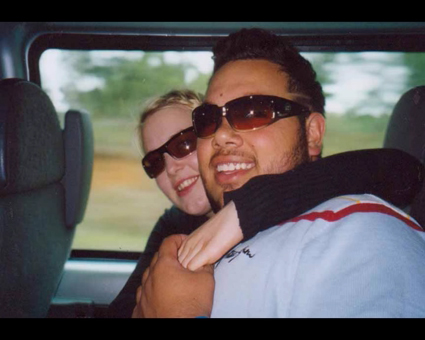
Tim Kanoa, Digital Storytelling, ACMI
Of course, 30 years on, there is also much to celebrate about Indigenous filmmaking, with successful feature films made by directors such as Ivan Sen, Rachel Perkins and Warwick Thornton. The second focus of the symposium was to celebrate the achievements of Indigenous filmmakers and foreground issues at stake in contemporary digital filmmaking. To this end, the symposium focused on the work of two Aboriginal female filmmakers, Darlene Johnston and Romaine Moreton, invited speakers at the event.
Discussions were framed around screenings of the makers’ precocious first short films, Johnston’s Two Bob Mermaid (1996) and Moreton’s The Farm (2006). Johnston, who has gone on to make a number of acclaimed short films and documentaries and is currently getting ready to shoot her first feature film, Obelia, spoke about current copyright opportunities for emerging filmmakers and of her experience working with renowned actor David Gulpilil for her film Crocodile Dreaming (2007). Moreton indicated the importance of using cinema to highlight the previously untold stories of Indigenous life in Australia; in her instance with the making of The Farm it was the green bean-pickers doing casual work around Queensland and Central New South Wales. She also spoke eloquently about Indigenous community filmmaking elsewhere in the world such as the Canadian online portal IsumaTV which is produced for Inuit communities and could serve as inspiration and a possible model for Australian communities.
There were some voices of dissent at the symposium; some felt that the proceedings required a much stronger Indigenous presence. To this end, it was urged that a second, larger conference with greater funding be held, incorporating views from Indigenous filmmakers from around the country. Overall, the symposium seemed well placed to raise awareness of the politics of contemporary Indigenous community filmmaking, as well as to focus on the sheer sensitivity of many of the issues involved in the filmmaking process and in copyright law.
Perhaps one shortcoming of the symposium was that it was difficult to assess how extensive Indigenous community filmmaking is. The case studies featured were informative, yet these were only two examples. How many remote communities are making films? How can one attempt to characterise Indigenous community filmmaking over the last three decades? A second conference could feature reports from community groups in each state and territory and perhaps aim to form a national network to encourage further production, distribution and leverage future filmmaking opportunities.
Australian Centre for the Moving Image and Monash University, From U-matic to YouTube: a symposium celebrating three decades of Australian Indigenous community filmmaking, ACMI, Melbourne, June 8-9
RealTime issue #98 Aug-Sept 2010 pg. 32
© Gem Blackwood; for permission to reproduce apply to realtime@realtimearts.net
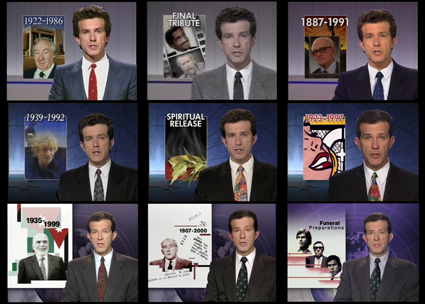
O-bit, Layla Vardo, HATCHED 2010 National Graduate Show, PICA, Perth
see image notes*
O-bit, Layla Vardo, HATCHED 2010 National Graduate Show, PICA, Perth
LET’S ASSUME, FOR THE SAKE OF ARGUMENT, THAT THERE IS SUCH A THING AS ‘THE SOCIAL NETWORKING REVOLUTION,’ AS IF THERE WAS NOTHING OF THE KIND BEFORE THE EVANGELISTIC WEB 2.0, AND TELL ME THAT MYSPACE IS NOT THE ‘HORROR VACUI’ OF OUR TIMES. I’VE ALREADY DIGRESSED INTO POLEMIC. LET’S BEGIN AGAIN, WITH A QUESTION: WHAT IS THE CURRENT STATE OF MEDIA EDUCATION IN THE CONTEXT OF SOCIAL NETWORKING?
Debates around nomenclature, the novelty or regressive nature of new formations are of course perennial, shifting with trends in industry, emergent communication technologies and constant updates within contemporary ‘app’ culture. The old chestnut “new media art” seems to have finally succumbed to the dustbin of history, absorbed into the malleable and apparently more robust discourse of “digital media” (though media or digital art doesn’t seem to trouble the attention of arts critics too often these days). Similarly, the pervasive formations of mobility, customisation and social networking have taken centre stage as inflections of the contemporary mediascape. The Web’s old hat, man.
new contexts
How has the higher education sector responded to these shifts? The fusion of different disciplines is a common feature of much recent and ongoing curriculum development throughout Australian universities. The University of Western Sydney’s recently accredited Master of Convergent Communications course is predicated on the “breakdown of traditional media silos.” Developed by media artist Kate Richards, the course is sensitive to the dynamic “transformation of media production and consumption practices” and the imperative that curricula, designed for preparing graduates to work in such a context, must also change.
Mitchell Whitelaw, who teaches in the postgraduate Digital Design program at the University of Canberra, is also interested in the “fuzzy areas between established practices,” a notion approaching the “hybridity” that RMIT academic and media artist Ian Haig values (though for him the paradigm of “digital media” is a “no brainer” and he dismisses it as “corporate, generic and uncreative”).
Chris Chesher, Director of the Digital Cultures program at the University of Sydney, points out that the introduction of its Bachelor of Arts Informatics program in 2000 was in response to the interests of employers seeking graduates “with the capacity to combine techno-savvy with writing, research and the creative skills of an Arts degree.” In 2007 the program was relaunched as Digital Cultures, a change that reflected the “refocusing of the program around Humanities, Social Sciences and Creative Arts engagements with cultural changes associated with digital technologies.” The Bachelor of Digital Media degree at the College of Fine Arts (UNSW) has also strategically positioned itself, in Ross Harley’s words, “across art school approaches to media production, communications-style degrees typically offered in humanities and social sciences, and design-centric approaches to the teaching of creative production and computing”.
So where will these fuzzy, techno-artistic hybrids find employment, having completed their digital media education? Whitelaw postulates the tantalising, yet not unproblematic idea that in this climate of emergent possibility his students “will have jobs that currently don’t exist.” This is indeed a notion that will detain the attention of critics and industry soothsayers for some time to come. Though a word of caution: multimedia graduates in search of as yet unimagined occupations ended up designing snappy promos for Foxtel or Val Morgan—hardly speculative industries or occupations.
multimedia tiredness
Both principles, of transcending definitional boundaries and blending media in unexpected ways, have clearly escaped the quagmire of ‘multimedia,’ with its reductive combination of audiovisuality and interactivity. It is indeed conspicuous to note that institutions that developed significant multimedia programs in the 1990s (such as Swinburne and RMIT) have moved towards the broader catch-all of Digital Media with its emphasis on a suite of production and conceptual literacies grounded in the principle of a utilitarian, digital paradigm that unifies domestic, commercial, industrial and creative activities. The University of Adelaide’s Graduate Certificate of Design in Digital Media also emphasises the “integration” of digital media into a range of practices and identifies its cohort as “post-professionals” seeking to extend their disciplinary knowledge through the use of digital media. Stephen Huxley, from Swinburne University of Technology’s Faculty of Design points to an overall “tiredness” associated with the notion of multimedia among industry and students alike. Huxley also points to the maturity of industries that developed out of the 1990s and were defined “under the umbrella term of multimedia,” suggesting that they “can no longer be addressed appropriately as a collective.”
transmedial adaptation
Media artist Maria Miranda also describes the ways in which artists have responded to such enormous changes in the mediascape in the last five to 10 years. She notes accordingly that media artists are “increasingly working within social networking paradigms and a much more low tech approach” (personal communication). Miranda’s portrait of the contemporary media artist resonates with and sheds valuable light upon current trends in media education in the Higher Education sector, which is also becoming more nomadic and sensitive to the trans-mediated nature of quotidian life: she writes, “many artists are working in public spaces, and across sites both online and offline simultaneously.” Recent responses within the Academy towards the revival of frayed and fraught notions such as convergence (University of Western Sydney) and culture (AFTRS’ new Graduate Certificate in Screen Culture) suggest that program design and branding within the sector are pro-active, offering digital media education that critically assesses this transmedial reality, as well as adequately equipping graduates for working within its changing industries. In this, then, media education is visionary as much as grounded in the present. The University of Western Sydney’s rationale and approach in this context of dynamic change is made plain, in that it is predicated on the “uneasy fit between creative and mobile audiences.” In the assertive, second person vernacular that is de rigueur within academic program design, its projected outcomes for students are clearly forward thinking and innovative: “you will develop new digital content, build skills and resources and explore the industry’s future, while assessing how you can adapt your experience to this rapidly changing industry.”
Not surprisingly, Queensland University of Technology’s “cultural industries”-inflected Media and Communications program accepts that the mix of fixed and mobile media is simply a fact of life. Accordingly, its program is interested in the concept of the “distribution of creative content” through various and intersecting media channels. Indeed, its Honours program in Technology Innovation (Digital Media) describes the “evolution” of the digital media industry (again understood as the dispersal of multimedia into more established practices such as cinema and performance) as “just beginning.” This development of student literacy, informed by the connection between digital technology and ‘creative’ disciplines, is also a focus of the University of Tasmania’s Masters in Creative Media Technology.
decentralised learning & working
If we accept that Digital Media is the new black and multimedia is so yesterday, how are Universities accommodating the voracious behemoth of social networking into the delivery of their curricula? The decentralising of learning and teaching has tapped into the social network’s imperative of delivering, to quote Ted Nelson, “anything instantly.” Lectures no longer have to be delivered, but can instead be pre-recorded and downloaded as podcasts to be auditioned at a time and place of the student’s discretion using mobile media. Online resources of all kinds (such as blogs and Wikis) have become a staple to be browsed like so many apps and, not surprisingly, it is becoming commonplace for universities to have their own iTunes channel for archiving downloadable learning materials. Many campuses have also embraced the virtual space of Second Life, whereby islands cater for the transfer of knowledge as much as the fulfilment of fantasy. Facebook, too, has been colonised by universities in the name of ubiquitous presence in the mediated lives of their students. Even the linguistically challenged Twitter has become a curriculum resource, with Griffith University Journalism students among the first in the country required to tweet as part of their assessable work.
to tweet or not
What are we to make of this confluence of academic work and the wireless public domain, the creative commons and the social network? In a recent essay on the blurring of public and private spheres in the “Age of Always Connect,” American writer Mark Dery discusses notions of “over-sharing” and the “death of shame” as the negative signs of the times we live in (http://trueslant.com/markdery/). Written with his inimitable acerbic wit, force and invention the essay is a cautionary tale about the double-headed hydra of mediated solipsism (the silent fixation on screens that makes “solitude portable”) and the unwanted broadcasting of privacy (“the stranger with the headset, chattering blithely about her irritable bowel as she elbows past you at the supermarket meat counter”).
It is clear that the academy has already embraced the siren song of the mediated world of me (it is “trending” in tweet-speak), but does it follow that the social network and the ideal of a ‘commons’ should become part of the intellectual infrastructure of the university? And does such a suggestion make me a tweet-less dag? What is to become of knowledge (as something that precedes and must succeed me) in the confessional tweet economy when definitions of media art, discussions of the media sector and what I’m wearing at the time will be undifferentiated noise in the flow? Discuss in 140 characters or less.
*Image notes: Layla Vardo is a graduate of RMIT (2009). Her work O-bit was awarded a prize as part of the Dr Harold Schenberg Bequest presented at HATCHED 2010 National Graduate Exhibition, PICA, Perth.
“Chronicling the aging of the subject and the medium of television itself, O-bit is a single channel video installation composed of chronological jump-cut images and breath sounds of news anchor Richard Morecroft as he delivers obituaries and death reports during his 17 years presenting the ABC nightly news” (Hatched 2010 Catalogue).
RealTime issue #98 Aug-Sept 2010 pg. 33
© Darren Tofts; for permission to reproduce apply to realtime@realtimearts.net
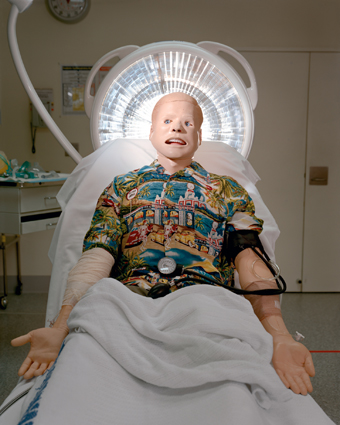
Living in Sim, Justine Cooper
image courtesy of the artist
Living in Sim, Justine Cooper
THE UNCANNY VALLEY TAKES ITS NAME FROM A GRAPH DEVELOPED BY JAPANESE ROBOTICIST MASAHIRO MORI IN 1970 TO MEASURE THE EMOTIONAL RESPONSES OF HUMANS TO THE DEGREE OF ANTHROPOMORPHISM IN ROBOTS. THE ‘UNCANNY VALLEY’ IS A PRONOUNCED DIP IN THE GRAPH WHICH OCCURS WHEN PEOPLE REACT NEGATIVELY TO THE ROBOTS BECOMING CLOSER TO THEM IN HUMAN APPEARANCE. THIS VALLEY IS WHERE THINGS SEEM HUMAN AND NOT QUITE HUMAN AT THE SAME TIME. TO QUOTE CURATOR LYNNE SANDERSON’S CATALOGUE ESSAY: “THIS IS THE PLACE WHERE ZOMBIES AND CORPSES THRIVE. IT IS ALSO WHERE MANNEQUINS LIVE…” LIKE MORI’S EXPERIMENTS THE EXHIBITION PRODUCES A RANGE OF CONTRADICTORY REACTIONS.
On the opening night we all crowd onto the viewing platform in a small side room waiting for Peter William Holden’s Arabesque to fire up again; it takes about 12 minutes for the hydraulic system to reset itself. Finally, the opening bars of Strauss’ Blue Danube can be heard and the performance literally kicks off. Eight robotic legs and arms move in time to the entire piece of music, and I hear someone mutter behind me that it is a fitting tribute to such a trite piece of music. Perhaps he means we’ve heard it so often that it has entered into the realm of artifice.
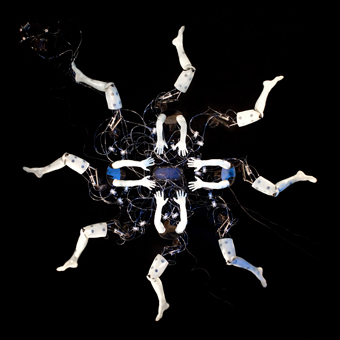
Arabesque, Peter William Holden
image by Medial Mirage/Matthias Moller
Arabesque, Peter William Holden
The photos of Arabesque in the catalogue show glowing iridescent legs and arms; a slow shutter speed must have been used, as luminous lines of movement are visible as well. These photographs of the “mechanical flower” are quite beautiful, whereas the artwork itself is fascinating in a different way, mainly with how it works. The cast arms and legs are made from a translucent material which has the appearance of waxy, dead skin. They are powered by hydraulics, with air periodically hissing its release, accompanied by the click of the limbs as they move. The artist deliberately left the many cables and workings of the sculpture in sight, acting as a kind of puzzle as to how it operates. People standing next to me laugh and clap and cry out “brilliant.” When taken in the context of the Uncanny Valley thesis, this seems akin to laughing at a funeral—that tendency to laugh in moments when not quite comfortable. I overhear many other people saying “It is like a…” which seems to signify that the work has entered the realm of the uncanny—as something for which we don’t yet have a language.
Dominating the gallery space is Justine Cooper’s photographic and video work Living in Sim which Cooper made as an outcome of her residency in at the Centre for Medical Simulation in Cambridge, Massachusetts. Presented in multiple formats, DVD, photographs and online, the work employs medical mannequins used to simulate patients for the training of medical practitioners. Cooper presents us with a hyper-real medical centre, complete with mannequins of aged care patients in wheelchairs, imposing hospital directors and the heaving breasts of nurses. One gallery wall is covered with small photographic canvases; nearly all of the dummies pictured on these have their mouths open as in silent screams, or maybe they are singing? In this hospital drama there is no blood, dirt or overcrowding; everyone who needs a bed has one, including Noctomum who has just given birth to nine children from multiple races. Another wall features images that Cooper has taken of actual simulated medical training exercises and these are quite affecting, particularly the mournful photograph of wheelchair-bound patients stuck in the corner and seemingly neglected.
The gallery space is also dominated by the sickly sweet soundtrack of Cooper’s video work. The DVD features blood, orifices and mess. The soundtrack croons on about the intimacy of doctor-patient relationships. The patients and medical staff of this “community living out the drama of health care” are further realised through a blog (livinginsim.com) which features posts and poems by the fictional staff members and video and photographs of their world. The mannequins use the blog to debate issues, such as plastic surgery (which Nurse Smilodon is vehemently against) and artificial insemination. The blog is what makes this artwork paradoxically ‘come to life,’ a demonstration of Cooper’s astute observations on the artificiality of online communication. The staff’s blog posts and biographies bring the comedic element of the work into play along, with more disturbing elements. In the visitors book in the gallery some visitors have written that the exhibition is offensive, stupid and pointless, asking that old question ‘is this art?’ One contributor has aptly written: “Disturbing? I find episodes of Master Chef more disturbing! I think some people in our health system must feel like dummies!”
The other two artworks in the exhibition are somewhat dwarfed, both in terms of size and complexity. David Archer’s A Journey Into the Mind takes us back to the Victorian era when experiments with robotics and automata were just appearing—the toys of the upper classes and the amusement parks of the masses. This sculpture is a hand-painted arcade style machine where the viewer looks into the lens and turns a handle. The human head inside the machine slowly opens to reveal a skull, which also opens in turn, revealing a peanut in the place of a brain. The simple mechanism and ‘message’ of this work is a reminder of how far science has come in robotics and yet how little has been achieved. Rona Pondick’s Jawbreakers is also a simple work, a jar of brightly coloured lollies stands on a shelf. On closer inspection these jawbreakers are revealed to be made from toothy cast jaws. Pondick writes that she sometimes wants to bite people she gets angry with, but has to stop herself because it’s socially unacceptable. The piece spirals in on itself—you bite a jawbreaker, it bites you back. These are lollies that will break your jaw and are broken jaws. It is a simple, playful piece. Pondick has used maniacally grinning teeth in her work previously; these little disembodied mouths can be quite disturbing, even uncanny.
With its dark humour, Uncanny Valley rides the fine line between comedy and drama and is at once disturbing and questioning. The exhibition functions in a very visceral manner with its small stories of real and artificial life in a darkened room. But the artificiality of the materials and media don’t quite allow for interaction with our own soft, warm bodies; somehow we feel excluded—surely part of the fear that fills the dark spaces of Masahiro Mori’s ‘uncanny valley.’
The Uncanny Valley: An exhibition exploring the not quite human, curator Lynne Sanderson, RiAus, Science Exchange, Adelaide, June 4-July 23, www.riaus.org.au
RealTime issue #98 Aug-Sept 2010 pg. 36
© Kirsty Darlaston; for permission to reproduce apply to realtime@realtimearts.net
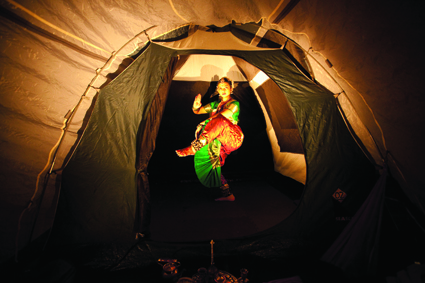
Radhika Krishnamoorthy, Private Dances
photo Jorge de Araujo
Radhika Krishnamoorthy, Private Dances
GENRE BENDING AND RISK TAKING WERE THE PROVISOS OF THE 2010 NEXT WAVE FESTIVAL WHICH RAN FOR OVER TWO WEEKS IN MELBOURNE. AUSTRALIAN EMERGING ARTISTS PUT THEIR BODIES UNDER DURESS, THREW OFF THEIR LAYERS OF SELF-CONSCIOUSNESS (AND CLOTHING) AND REWARDED THEIR AUDIENCES WITH INTIMACY, INSIGHT AND INTRIGUE.
private dances
Have you ever had someone dance just for you? Up close, you can perceive sweat glisten, sinewy muscles snaking in the spotlight, chest heaving. Exhilarated, yet coy, you make eye contact. Private Dances (curator, producer Natalie Cursio) ranges from traditional Korean dance to Private Parking—a performance in a van while you sit in the driver’s seat. It’s a large scale production incorporating 10 live performances, food, unexpected sets and six short films all viewed solo. Due to the random manner in which viewers are chosen to participate the audience takes in a variable slice of the action.
The Meat Market was converted into a softly darkened bar while tents—set up as if for children in a lounge room—provided just some of the unexpected venues for viewing film and performances with the unbridled joy of playtime. Dancer Atlanta Eke donned a gorilla suit to dance with you to a ballad. Alone, you think, until invited to sit in the annexe of the tent and watch the next person sharing a teenage dance hall moment to Cindi Lauper. Dancing stripped of the restrictions of a stage and the anonymity of a crowd became an intimate interaction. Underlying the evening’s fantastical entertainment was pleasure in its quiet voyeurism and feeling of gratitude. Private Dances was a gift to the audience, a rare opportunity to be treated like a royal guest in a Persian tent city. Not surprisingly, the show was a festival favourite and quickly sold out.
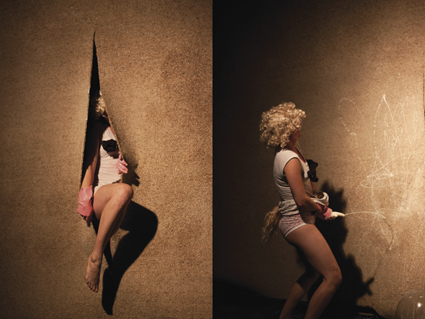
Sugar Coated, Hannah Raisin
photo Kim Ryan
Sugar Coated, Hannah Raisin
sugar coated
Hannah Raisin in Sugar Coated took a multidisciplinary approach in exploring gender roles and sexuality with a collection of film, sounds and live performance. A slight 24-year old with an unassuming bob, the recent VCA graduate handles her subject matter with fearless aplomb and speedy costume changes. She seems to intuit where the history of gender politics is at, taking back raunch culture from the pornographers and exploiters, interpreting it with artistic wit and a sensory explosion. This even includes scent: bait fish rained from her underpants in the opening act, leaving a lingering fragrance for the remainder of the show. In her investigations into domesticity and sexuality Raisin uses props ranging from fling-ups (textile representations of female genitalia) to soapy water to draw a reclining nude. In one video she pours milk over herself on a city street wearing just a transparent raincoat—much to the shock of middle-aged theatre goers. In the closing act she dons a bikini made of bath bombs, dousing herself with bottles of water while standing in a toy sea shell pool—a sadly bedraggled Venus. Raisin’s desire to push her body to often painful new places wins her fans but is also effective in conveying her contradictory messages of female angst and empowerment.
short message service
In a risk averse culture, The Short Message Service was an experiment in allowing audience control of two performers via text message. The show echoed Marina Abramovic ‘s 1974 Rhythm 0, which freely tested the relationship between artist and audience. Here though, the audience requests were channelled through gatekeepers who chose which text message instructions to relay via a handsfree set. The props consisted of a table and two chairs; no scissors, gun, rose thorns nor direct interaction here.
Phase 1 of the experiment began slowly; the audience was urged to send greetings for the two performers. These were trite enough to begin with; “Ni Hao, Herro.” Phase 2 required the audience members to involve their respective actors in moments of tenderness and tension. Verbal communication became action; Mish, the female actor, was instructed to disrobe and spent a good portion of the performance topless. She bore the abusive urges of the audience with the passive stoicism of Abramovic. Naked breakdancing and slapping of faces were some of the dark desires that were realised onstage.
After Rhythm 0, Abramovic stated, “if you leave [the] decision to the public, you can be killed…” She went on to mention the aggressive atmosphere created. Indeed there was also something vaguely reminiscent of the ‘71 Zimbardo prison experiment in this show; instead of security guards with batons the audience inflicted pain via mobile phones. As an experiment, SMS raised some pertinent points on technology and intimacy, in the process receiving a few laughs, though the possibility of text message RSI and the occasionally puerile outcomes made it a hard sell for an hour long show.
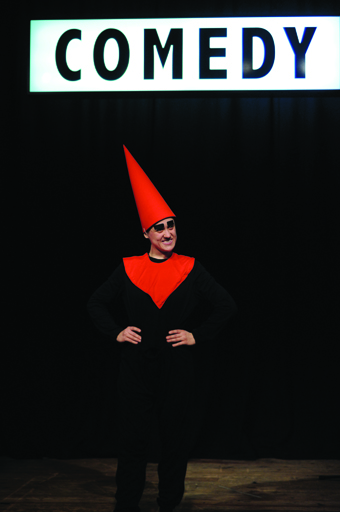
Frances Barret, A Comedy, Brown Council
photo Devika Bilimoria
Frances Barret, A Comedy, Brown Council
a comedy
Performed by artist collaborators Brown Council, A Comedy investigates Nietzche’s idea that maliciousness and absurdity are the basis of all laughter. The audience is guided through the well-established comedy canon: stand up, slapstick, spectacle and audience participation. Expectations are slowly dismantled and what we begin to see are uncomfortable, tortured performances from forced banana consumption to real slaps in slapstick routines. Not only do we sense the desperation of comedians for a laugh but the lengths they will go to achieve it. By the close of the show the once comical dunce hats that the performers and audience wear take on a sinister role. After her failed attempt to escape from rope bindings, a target is drawn on the face of a bound female performer and the audience is encouraged to hurl tomatoes. It could be a scene from Abu Ghraib; the conical hat and black sack clothing she wears are familiar images from the 2004 prison torture scandal. Unfortunately those pummelling the performer seemed to miss this reference and the premise of the show. To be fair, the constant encouragement for audience participation was quite manipulative and seemed to sanction this violence.
and that was the summer….
On a lighter note, And that was the summer that changed my life was a comedy where one could snort and guffaw without prejudice. Written and performed by Zoë Coombs Marr (of performance group Post), it’s a sharply observed monologue dealing with the acute embarrassment of teenage firsts—the transition from childhood love of dinosaurs and music camps to sexual awakening. That Marr unabashedly admits to her most excruciating moments is a cathartic experience for the audience. Dressed in an unflattering leotard with a parachute jacket, sometimes we even recognise ourselves in her. Before pity ever sets in, Marr cuts in with a boast—“I’ve crushed a lot of pussy”—and keeps the audience besotted with acerbic humour and the kind of daggy, alone-in-your-own-room creativity that sustains countless teenagers.
Peppered throughout are nostalgic musical interludes dating to that summer in the mid 90s when it all changed for her. In these, Marr performs Lucille Ball type facial contortions and uses an appliquéd brontosaurus on her leotard as a puppet. In her self-deprecating confessions are serious coming of age hurdles that lend poignancy to her story. Just as Frankie magazine elevated doilies and baking to fashion, Marr turns her flute playing, nose bleeding Sapphic alter ego into a high priestess of cool. The final musical number is a creamy chef d’oeuvre and a big payoff for the audience.
Next Wave Festival 2010: Private Dances, concept, curator, producer Natalie Cursio, Arts House, Meat Market, May 12-16; Sugar Coated, artist Hannah Raisin, Goodtime Studios, May 14-20; The Short Message Service, performers, collaborators Jackson Castiglione, Mish Grigor, co-creators, collaborators Leah Shelton, Lachlan Tetlow-Stuart: BlackBox, Arts Centre, May 14-22; Brown Council (Frances Barrett, Kate Blackmore, Kelly Doley, Diana Smith), A Comedy, Trades Hall, May 19-23; Zoë Coombs Marr, And That Was The Summer That Changed My Life, BlackBox, Arts Centre, Melbourne May 26-29
RealTime issue #98 Aug-Sept 2010 pg. 39
© Varia Karipoff; for permission to reproduce apply to realtime@realtimearts.net








































































